TRENDNET TEW635BRM Wireless N ADSL Modem Router User Manual UG TEW 635BRM V1 0R
TRENDNET, INC. Wireless N ADSL Modem Router UG TEW 635BRM V1 0R
TRENDNET >
manual
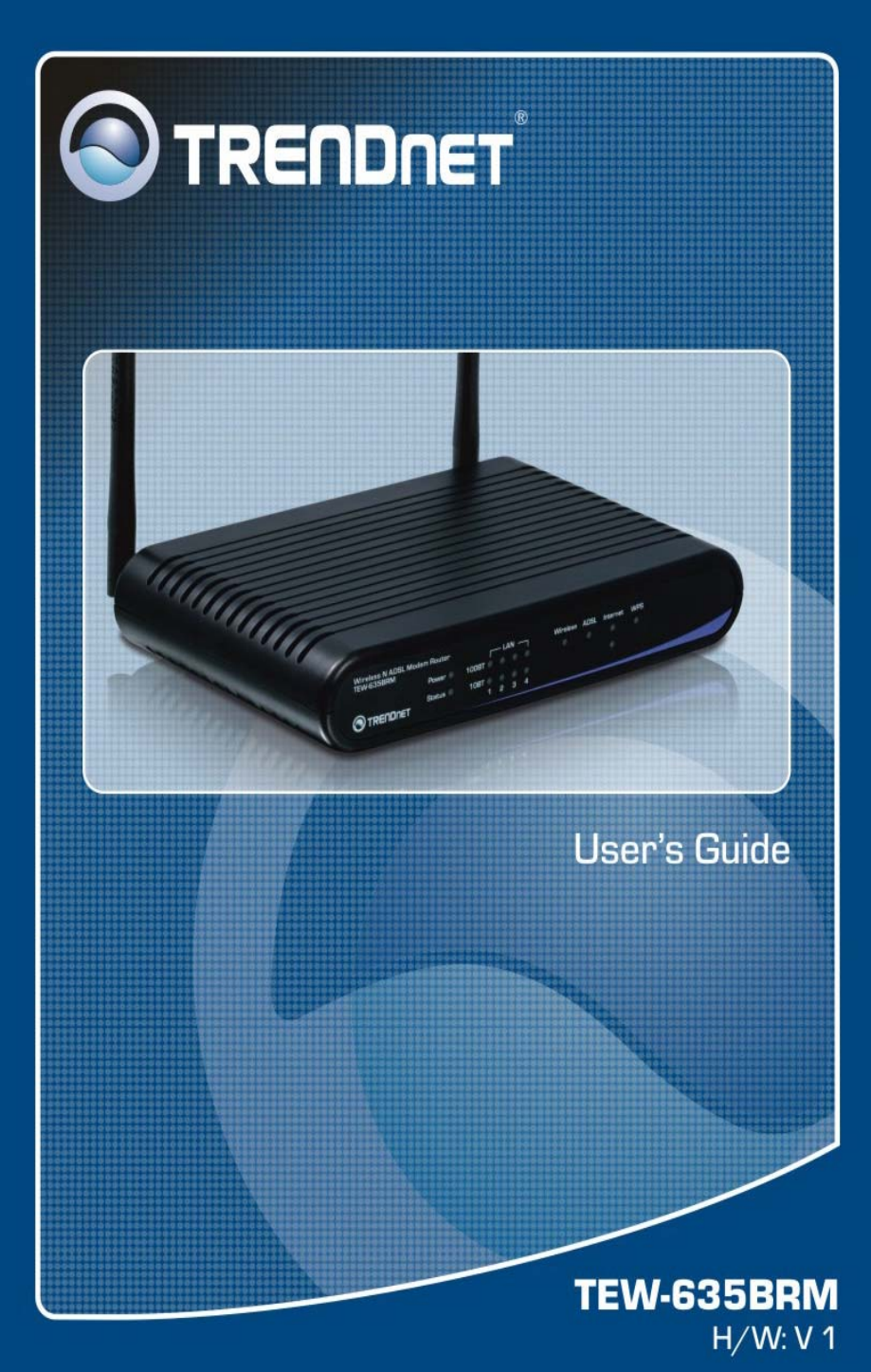
i

ii
Table of Contents
CHAPTER 1 INTRODUCTION ............................................................................................. 1
Wireless ADSL Modem Router Features ........................................................................ 1
Package Contents .............................................................................................................. 5
Physical Details .................................................................................................................. 6
CHAPTER 2 INSTALLATION ............................................................................................... 8
Requirements ..................................................................................................................... 8
Procedure ........................................................................................................................... 8
CHAPTER 3 SETUP .............................................................................................................. 10
Overview .......................................................................................................................... 10
Configuration Program .................................................................................................. 12
Setup Wizard ................................................................................................................... 13
Configuring VCs .............................................................................................................. 20
Main Screen ..................................................................................................................... 23
LAN Screen ...................................................................................................................... 24
Wireless Screen ................................................................................................................ 26
Wireless Security ............................................................................................................. 29
Trusted Wireless Stations ............................................................................................... 33
Password Screen .............................................................................................................. 35
Mode Screen ..................................................................................................................... 37
Status ................................................................................................................................ 38
Connection Status - PPPoE & PPPoA ........................................................................... 41
Connection Details - Dynamic IP Address .................................................................... 42
Connection Details - Fixed IP Address .......................................................................... 43
Binding Function ............................................................................................................. 44
CHAPTER 4 COMPUTER CONFIGURATION ................................................................ 45
Overview .......................................................................................................................... 45
Windows Clients .............................................................................................................. 45
Macintosh Clients ............................................................................................................ 57
Linux Clients .................................................................................................................... 57
Other Unix Systems ......................................................................................................... 57
Wireless Station Configuration ...................................................................................... 58
Wireless Configuration on Windows XP ....................................................................... 58
CHAPTER 5 ADVANCED FEATURES .............................................................................. 69
Overview .......................................................................................................................... 69
Internet ............................................................................................................................. 69
Dynamic DNS (Domain Name Server) .......................................................................... 73
Options ............................................................................................................................. 75
Schedule............................................................................................................................ 76
Port Trigger ..................................................................................................................... 77
Port Forward ................................................................................................................... 79
Port Range Forward ....................................................................................................... 80
QoS ................................................................................................................................... 81
CHAPTER 6 ADVANCED ADMINISTRATION ............................................................... 83
Overview .......................................................................................................................... 83
PC Database ..................................................................................................................... 84
Config File ........................................................................................................................ 85
Logs ................................................................................................................................... 86
iii
E-mail ............................................................................................................................... 88
Diagnostics ....................................................................................................................... 90
Remote Administration ................................................................................................... 91
Routing ............................................................................................................................. 93
Upgrade Firmware .......................................................................................................... 97
CHAPTER 7 MODEM MODE .............................................................................................. 98
Overview .......................................................................................................................... 98
Management Connections .............................................................................................. 98
Modem Mode Main Screen ............................................................................................ 99
Operation ....................................................................................................................... 103
APPENDIX A TROUBLESHOOTING .............................................................................. 104
Overview ........................................................................................................................ 104
General Problems .......................................................................................................... 104
Internet Access ............................................................................................................... 104
Wireless Access .............................................................................................................. 105
APPENDIX B ABOUT WIRELESS LANS ........................................................................ 107
Modes ............................................................................................................................. 107
BSS/ESS.......................................................................................................................... 107
Channels ......................................................................................................................... 108
WEP ................................................................................................................................ 108
WPA-PSK ...................................................................................................................... 108
WPA2-PSK .................................................................................................................... 109
WPA-802.1x ................................................................................................................... 109
Wireless LAN Configuration ........................................................................................ 109
APPENDIX C SPECIFICATIONS ..................................................................................... 110
Multi-Function Wireless ADSL Modem Router ........................................................ 110
Wireless Interface .......................................................................................................... 110
Regulatory Approvals ................................................................................................... 113
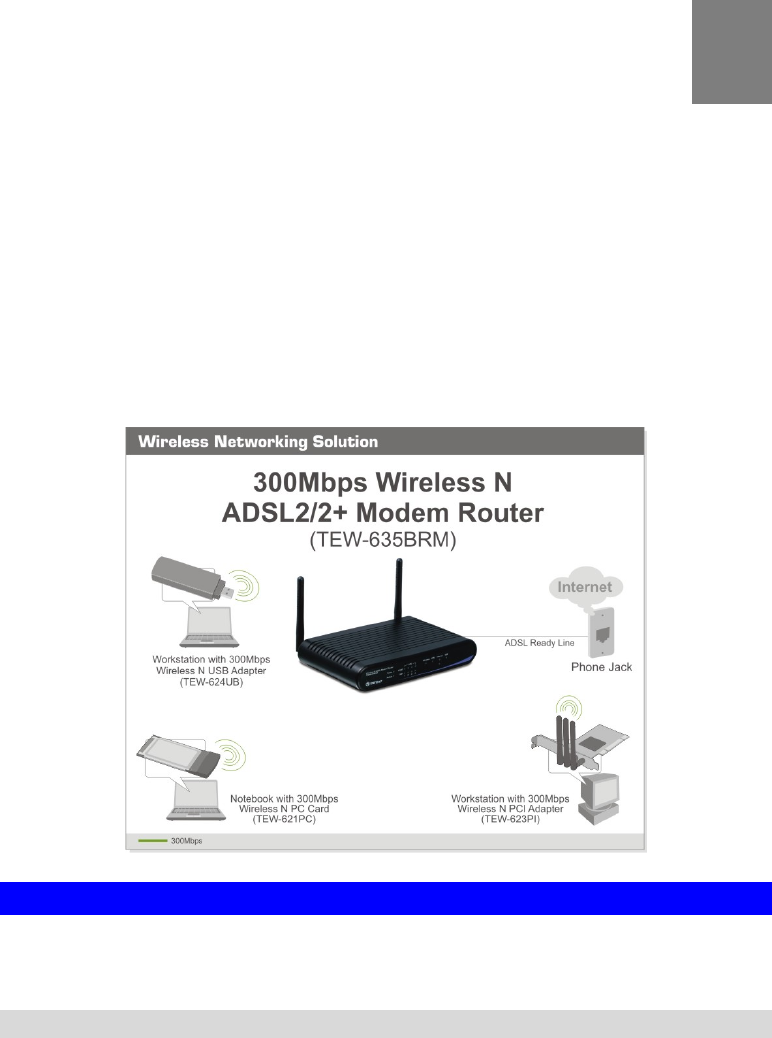
1
Chapter 1
Introduction
This Chapter provides an overview of the Wireless ADSL Modem Router's
features and capabilities.
Congratulations on the purchase of your new Wireless ADSL Modem Router. The Wireless
ADSL Modem Router is a multi-function device providing the following services:
• ADSL Modem.
• Shared Broadband Internet Access for all LAN users.
• Wireless Access Point for 802.11n, 802.11b and 802.11g Wireless Stations.
• 4-Port Switching Hub for 10BaseT or 100BaseT connections.
Wireless ADSL Modem Router Features
The Wireless ADSL Modem Router incorporates many advanced features, carefully designed
to provide sophisticated functions while being easy to use.
Internet Access Features
• Shared Internet Access. All users on the LAN or WLAN can access the Internet
through the Wireless ADSL Modem Router, using only a single external IP Address. The
local (invalid) IP Addresses are hidden from external sources. This process is called NAT
(Network Address Translation).
• Built-in ADSL Modem. The Wireless ADSL Modem Router has a built-in ADSL
modem, supporting all common ADSL connections.
1

2
• IPoA, PPPoE, PPPoA, Direct Connection Support. The Wireless ADSL Modem
Router supports all common connection methods.
• Auto-detection of Internet Connection Method. In most situations, the Wireless
ADSL Modem Router can test your ADSL and Internet connection to determine the con-
nection method used by your ISP.
• Static or Dynamic IP Address. On the Internet (ADSL port) connection, the Wireless
ADSL Modem Router supports both Dynamic IP Address (IP Address is allocated on
connection) and Static (Fixed) IP Address.
Advanced Internet Functions
• Application Level Gateways (ALGs). Applications which use non-standard connec-
tions or port numbers are normally blocked by the Firewall. The ability to define and
allow such applications is provided, to enable such applications to be used normally.
• Port Triggering. This feature, also called Special Applications, allows you to use
Internet applications which normally do not function when used behind a firewall.
• Port Forwarding. This feature allows Internet users to access Internet servers on your
LAN. The required setup is quick and easy.
• Dynamic DNS Support. DDNS, when used with the Virtual Servers feature, allows
users to connect to Servers on your LAN using a Domain Name, even if you have a dy-
namic IP address which changes every time you connect.
• URL Filter. Use the URL Filter to block access to undesirable Web sites by LAN users.
• Scheduling. Both the URL Filter and Firewall rules can be scheduled to operate only at
certain times. This provides great flexibility in controlling Internet -bound traffic.
• Logs. Define what data is recorded in the Logs, and optionally send log data to a Syslog
Server. Log data can also be E-mailed to you.
• VPN Pass through Support. PCs with VPN (Virtual Private Networking) software
using PPTP, L2TP and IPSec are transparently supported - no configuration is required.
• Multi-PVC Support. A permanent virtual circuit (PVC) can provide a continuous
connection between two or more points when needed without having to reserve a specific
physical path in advance. In this way, many companies can share a common pool of cir-
cuits. (Please note: auto-detect connection setup in Setup Wizard does not support Multi-
PCV. If you would like to enable the Multi-PVC feature, please use manual connection
method instead.)
Wireless Features
• Standards Compliant. The Wireless ADSL Modem Router complies with the
IEEE802.11g (DSSS) specifications for Wireless LANs.
• Supports Pre-N Wireless Stations. The 802.11n Draft standard provides for backward
compatibility with the 802.11b standard, so 802.11n, 802.11b and 802.11g Wireless sta-
tions can be used simultaneously.
• WEP support. Support for WEP (Wired Equivalent Privacy) is included. Key sizes of
64 Bit and 128 Bit are supported. WEP encrypts any data before transmission, providing
protection against snoopers.

3
• WPA-PSK support. Like WEP, WPA-PSK encrypts any data before transmission,
providing protection against snoopers. The WPA-PSK is a later standard than WEP, and
provides both easier configuration and greater security than WEP.
• WPA2-PSK support. Support for WPA2 is also included. WPA2 uses the extremely
secure AES encryption method.
• 802.1x Support. Support for 802.1x mode is included, providing for the industrial-
strength wireless security of 802.1x authentication and authorization.
• Wireless MAC Access Control. The Wireless Access Control feature can check the
MAC address (hardware address) of Wireless stations to ensure that only trusted Wireless
Stations can access your LAN.
• Simple Configuration. If the default settings are unsuitable, they can be changed
quickly and easily.
• WPS Support. WPS (Wi-Fi Protected Setup) can simplify the process of connecting any
device to the wireless network by using the Push Button Configuration (PBC) on the
Wireless Access Point, or entering a PIN code if there's no button.
• WDS Support. Support for WDS (Wireless Distribution System) allows the Wireless
Access Point to act as a Wireless Bridge. Both Point-to-Point and Multi-Point Bridge
modes are supported.
LAN Features
• 4-Port Switching Hub. The Wireless ADSL Modem Router incorporates a 4-port
10/100BaseT switching hub, making it easy to create or extend your LAN.
• DHCP Server Support. Dynamic Host Configuration Protocol provides a dynamic IP
address to PCs and other devices upon request. The Wireless ADSL Modem Router can
act as a DHCP Server for your local LAN and WLAN devices.
Configuration & Management
• Easy Setup. Use your WEB browser from anywhere on the LAN or WLAN for configu-
ration.
• Configuration File Upload/Download. Save (download) the configuration data from
the Wireless ADSL Modem Router to your computer, and restore (upload) a previously-
saved configuration file to the Wireless ADSL Modem Router.
• Remote Management. The Wireless ADSL Modem Router can be managed from any
PC on your LAN or Wireless LAN. And, if the Internet connection exists, it can also (op-
tionally) be configured via the Internet.
• Network Diagnostics. You can use the Wireless ADSL Modem Router to perform a
Ping or DNS lookup.
Security Features
• Password - protected Configuration. Password protection is provided to prevent
unauthorized users from modifying the configuration data and settings.
• Wireless LAN Security. WPA-802.1x, WPA2-802.1x and WEP and Wireless access
control by MAC address are all supported. The MAC-level access control feature can be
used to prevent unknown wireless stations from accessing your LAN.

4
• NAT Protection. An intrinsic side effect of NAT (Network Address Translation) tech-
nology is that by allowing all LAN users to share a single IP address, the location and
even the existence of each computer is hidden. From the external viewpoint, there is no
network, only a single device - the Wireless ADSL Modem Router.
• Firewall. All incoming data packets are monitored and all incoming server requests are
filtered, thus protecting your network from malicious attacks from external sources.
• Protection against DoS attacks. DoS (Denial of Service) attacks can flood your
Internet connection with invalid packets and connection requests, using so much band-
width and so many resources that Internet access becomes unavailable. The Wireless
ADSL Modem Router incorporates protection against DoS attacks.

5
Package Contents
The following items should be included. If any of these items are damaged or missing, please
contact your dealer immediately.
• TEW-635BRM
• Multi-Language Quick Installation Guide
• CD-ROM (User’s Guide)
• 1 x RJ-45 Ethernet Cable
• 1 x RJ-11 Telephone Cable
• 1 x External Power Adapter (12VDC, 1A)
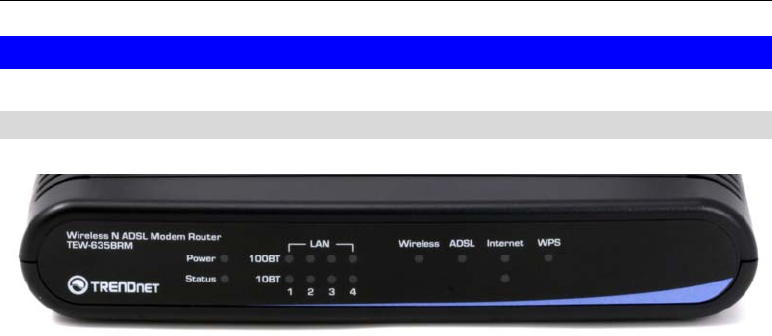
6
Physical Details
Front-mounted LEDs
Power LED
On (Green) - Power on.
Off - No power.
Flashing (Green) - Device is rebooting.
Status On (Orange) - Device error.
LAN For each port, there are 2 LEDs. One is 100BaseT, another is 10BaseT.
• On (Green) - Corresponding LAN (hub) port is using 100BaseT.
• On (Orange) - Corresponding LAN (hub) port is using 10BaseT.
• Off - No active connection on the corresponding LAN (hub) port.
• Flashing - Data is being transmitted or received via the corresponding
LAN (hub) port.
Wireless On - Wireless enabled.
Off - No Wireless connections currently exist.
Flashing - Data is being transmitted or received via the Wireless connec-
tion. This includes "network traffic" as well as user’s data.
ADSL On - ADSL connection established.
Off - No ADSL connection existing.
Flashing - ADSL is synchronizing.
Internet On (Green) - Internet connection is available.
Off - No Internet connection available.
On (Orange) - Authentication error.
WPS On - WPS wireless security is enabled.
Off - WPS is disable
Flashing - The device is in the 2-minute interval to synchronize security.

7
Rear Panel
ADSL port Connects ADSL line here
LAN 1~4 10/100Mbps LAN port.
Power ON/OFF Press this button to power on/off the device
Power port Power adapter port
WPS Button Push the WPS button to enable the WPS function. On your other
wireless device, push the WPS (if available) or type the pin code to
establish the secured wireless encryption connection automatically.
Wireless ON/OFF Press this button to switch wireless function on or off.
To restore the factory default settings
Press the Wireless and WPS buttons simultaneously for 8 seconds and release them. Wait the
Wireless ADSL Modem Router to restart. The ADSL router should restore the factory default
value.
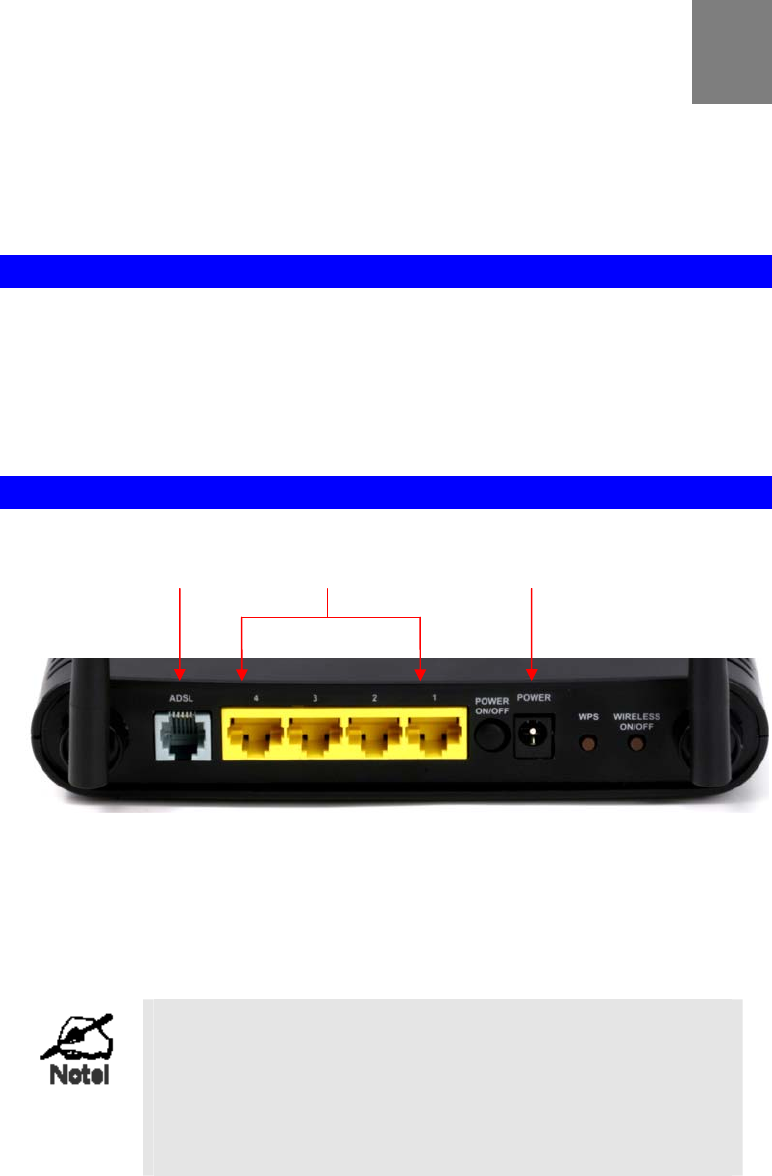
8
Chapter 2
Installation
This Chapter covers the physical installation of the Wireless ADSL Modem
Router.
Requirements
• Network cables. Use standard 10/100BaseT network (UTP) cables with RJ-45 connectors.
• TCP/IP protocol must be installed on all PCs.
• For Internet Access, an Internet Access account with an ISP, and a DSL connection.
• To use the Wireless Access Point, all Wireless devices must be compliant with the IEEE
802.11g, IEEE 802.11b or IEEE 802.11n Draft specifications.
Procedure
1. Choose an Installation Site
Select a suitable place on the network to install the Wireless ADSL Modem Router.
For best Wireless reception and performance, the Wireless
ADSL Modem Router should be positioned in a central
location with minimum obstructions between the Wireless
ADSL Modem Router and the computers.
Also, if using multiple Access Points, adjacent Access
Points should use different Channels.
2
ADSL Line LAN Ports Power Connector

Installation
9
2. Connect LAN Cables
Use standard LAN cables to connect computers to the Switching Hub ports on the Wire-
less ADSL Modem Router. Both 10BaseT and 100BaseT connections can be used
simultaneously.
3. Connect RJ-11 Telephone Cable
Connect the provided telephone cable from the ADSL port to the ADSL phone jack which
provided by your ADSL phone company.
4. Power Up
Connect the provided power adapter to the power port. Only use the provided power adap-
ter. Using a different one may cause hardware damage.
5. Check the LEDs
• The Power LED should be ON.
• One of the LAN port should be on if there is a computer connected.
• The Wireless LED should be ON
• The ADSL LED should be ON if ADSL line is established.
• The Internet (Green) LED may be OFF. After configuration, it should be ON.
For more information, refer to Front-mounted LEDs in Chapter 1.

10
Chapter 3
Setup
This Chapter provides Setup details of the Wireless ADSL Modem Router.
Overview
This chapter describes the setup procedure for:
• Internet Access
• LAN configuration
• Wireless setup
• Assigning a Password to protect the configuration data.
PCs on your local LAN may also require configuration. For details, see Chapter 4 - Computer
Configuration.
Other configuration may also be required, depending on which features and functions of the
Wireless ADSL Modem Router you wish to use. Use the table below to locate detailed instruc-
tions for the required functions.
To Do this: Refer to:
Configure PCs on your LAN. Chapter 4:
Computer Configuration
Use any of the following Advanced features:
• Internet (DMZ, URL Filter)
• Access Control
• Dynamic DNS
• Options
• Schedule
• Port Trigger
• Port Forward
• Port Range Forward
• QoS
Chapter 5:
Advanced Features
3

11
Use any of the following Administration Configuration
settings or features:
• PC Database
• Config File
• Logs
• E-mail
• Diagnostics
• Remote Admin
• Routing
• Upgrade Firmware
Chapter 6
Advanced Administration

12
Configuration Program
The Wireless ADSL Modem Router contains an HTTP server. This enables you to connect to
it, and configure it, using your Web Browser. Your Browser must support JavaScript.
The configuration program has been tested on the following browsers:
• Netscape 7.1 or later.
• Mozilla 1.6 or later
• Internet Explorer V5.5 or later
Preparation
Before attempting to configure the Wireless ADSL Modem Router, please ensure that:
• Your computer can establish a physical connection to the Wireless ADSL Modem Router.
The computer and the Wireless ADSL Modem Router must be directly connected (using
the Hub ports on the Wireless ADSL Modem Router) or on the same LAN segment.
• The Wireless ADSL Modem Router must be installed and powered ON.
• Wireless ADSL Modem Router's default IP Address (192.168.10.1). Make sure there is no
other device using the same IP address within the same network.
Using your Web Browser
To establish a connection from your computer to the Wireless ADSL Modem Router:
1. After installing the Wireless ADSL Modem Router in your LAN, start your computer. If
your computer is already running, restart it.
2. Start your WEB browser.
3. In the Address box, enter "HTTP://" and the IP Address of the Wireless ADSL Modem
Router, as in this example, which uses the Wireless ADSL Modem Router's default IP
Address:
HTTP://192.168.10.1
4. When prompted for the User name and Password, enter values as follows:
• User name admin
• Password password

13
If you can't connect
If the Wireless ADSL Modem Router does not respond, check the following:
• The Wireless ADSL Modem Router is properly installed, LAN connection is
OK, and it is powered ON. You can test the connection by using the "Ping"
command:
• Open the MS-DOS window or command prompt window.
• Enter the command:
ping 192.168.10.1
If no response is received, either the connection is not working, or your com-
puter 's IP address is not compatible with the Wireless ADSL Modem Router's
IP Address. (See next item.)
• If your computer is using a fixed IP Address, its IP Address must be within the
range 192.168.10.2 to 192.168.10.254 to be compatible with the Wireless
ADSL Modem Router's default IP Address of 192.168.10.1. Also, the Network
Mask must be set to 255.255.255.0. See Chapter 4 - Computer Configuration
for details on checking your computer's TCP/IP settings.
• Ensure that your computer and the Wireless ADSL Modem Router are on the
same network segment. (If you don't have a router, this must be the case.)
• Ensure you are using the wired LAN interface. The Wireless interface can only
be used if its configuration matches your PC's wireless settings.
Setup Wizard
The common connection types are explained in the following table.
Connection Type Details ISP Data required
Dynamic
IP Address Your IP Address is allocated
automatically, when you con-
nect to you ISP.
Often, none.
Some ISP's may require you to
use a particular Hostname or
Domain name, or MAC (physical)
address.
Static (Fixed)
IP Address Your ISP allocates a permanent
IP Address to you.
Usually, the connection is
"Always on".
IP Address allocated to you, and
related information, such as
Network Mask, Gateway IP
address, and DNS address.
PPPoE, PPPoA You connect to the ISP only
when required. The IP address
is usually allocated automatical-
ly.
a) User name and password are
always required.
b) If using a Static (Fixed) IP
address, you need the IP address
and related information (Network
Mask, Gateway IP address, and
DNS address)
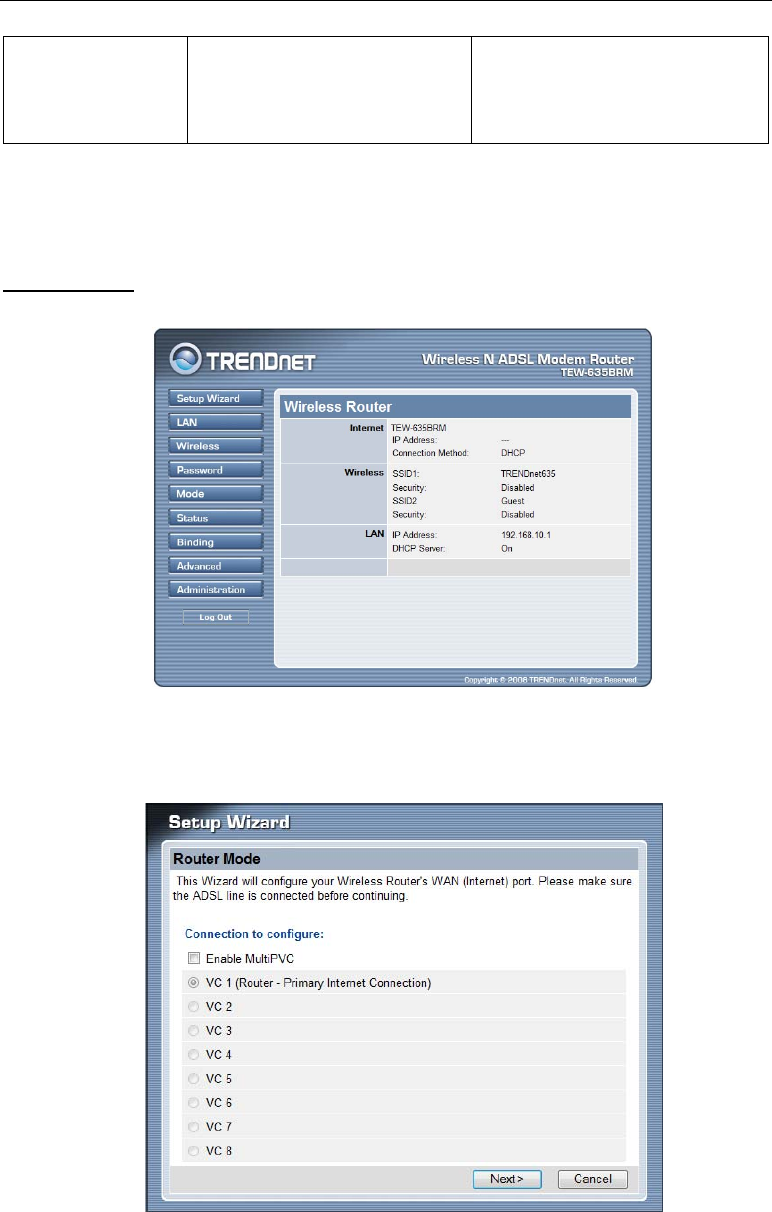
14
IPoA
(IP over ATM) Normally, the connection is
"Always on". IP Address allocated to you, and
related information, such as
Network Mask, Gateway IP
address, and DNS address.
The first time you connect to the Wireless ADSL Modem Router, you should run the Setup
Wizard to configure the ADSL and Internet Connection. There are two options. One is “Auto-
Detect” and another is “Manual Selection”.
Auto-Detection
1. Click the Setup Wizard link on the main menu
2. On the first screen, select VC 1 (Router - Primary Internet Connection), then click "Next".
Note: Auto-detection does not support “MultiPVC”. If you would like to enable the
multi PVC feature, you must use Manual Selection to setup your ADSL line.
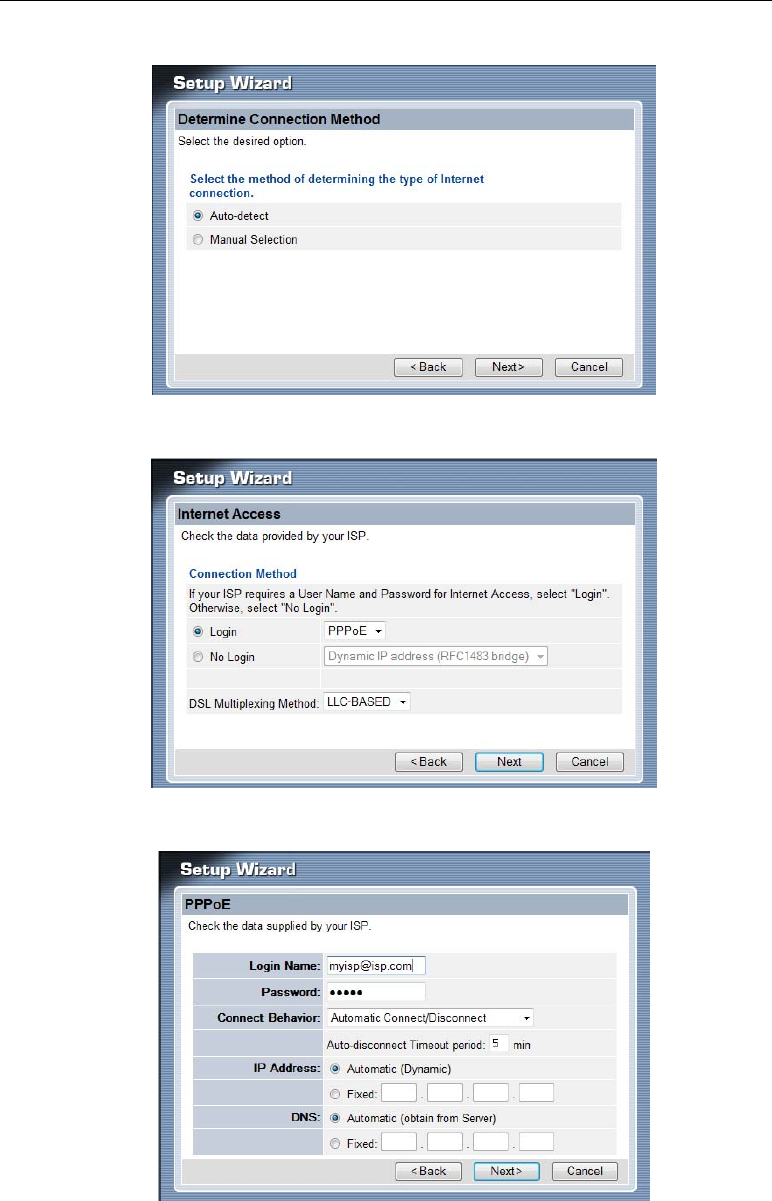
15
3. Select the “Auto-detect” connection method.
4. Configure the setting based on the information your IPS provided.
5. Type in the username & password if applicable
6. Waiting for the Modem Router reboot.
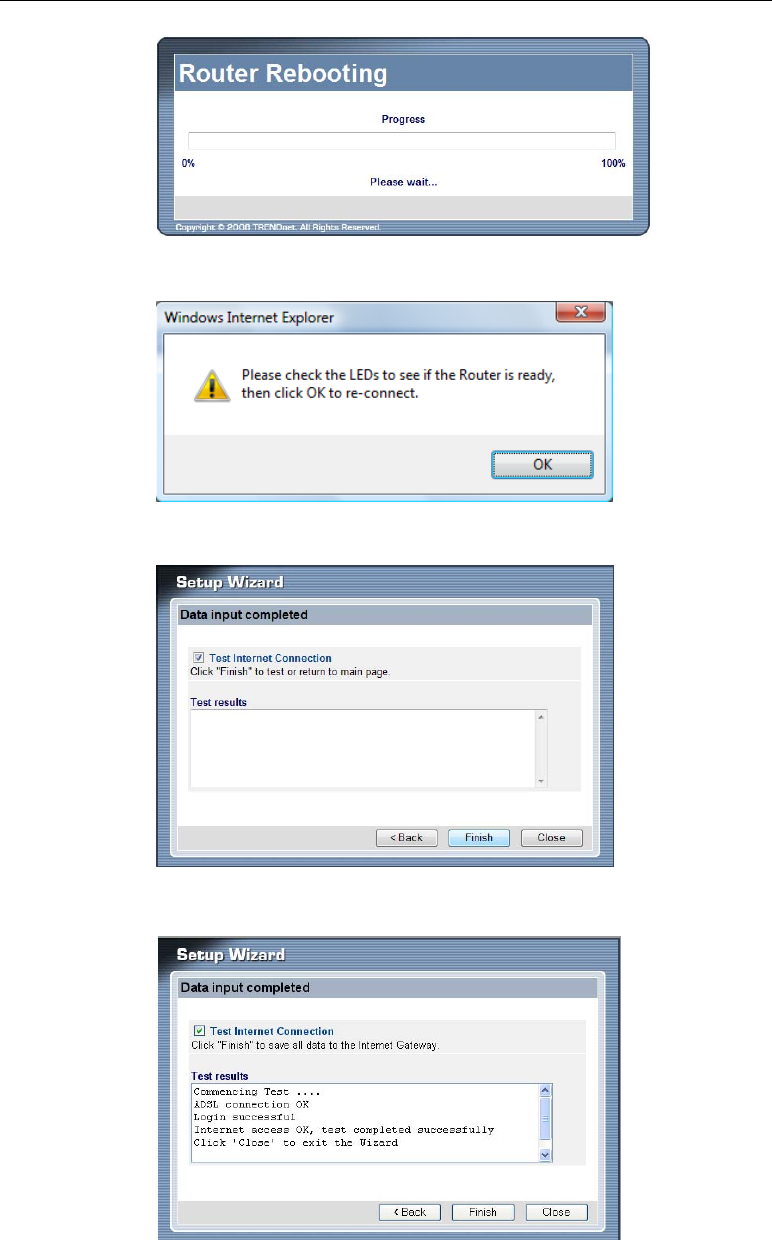
16
7. Click OK.
8. Click Finish to diagnostic the setting result
9. Click Close to exit the Setup Wizard
10. If the connection test fails:
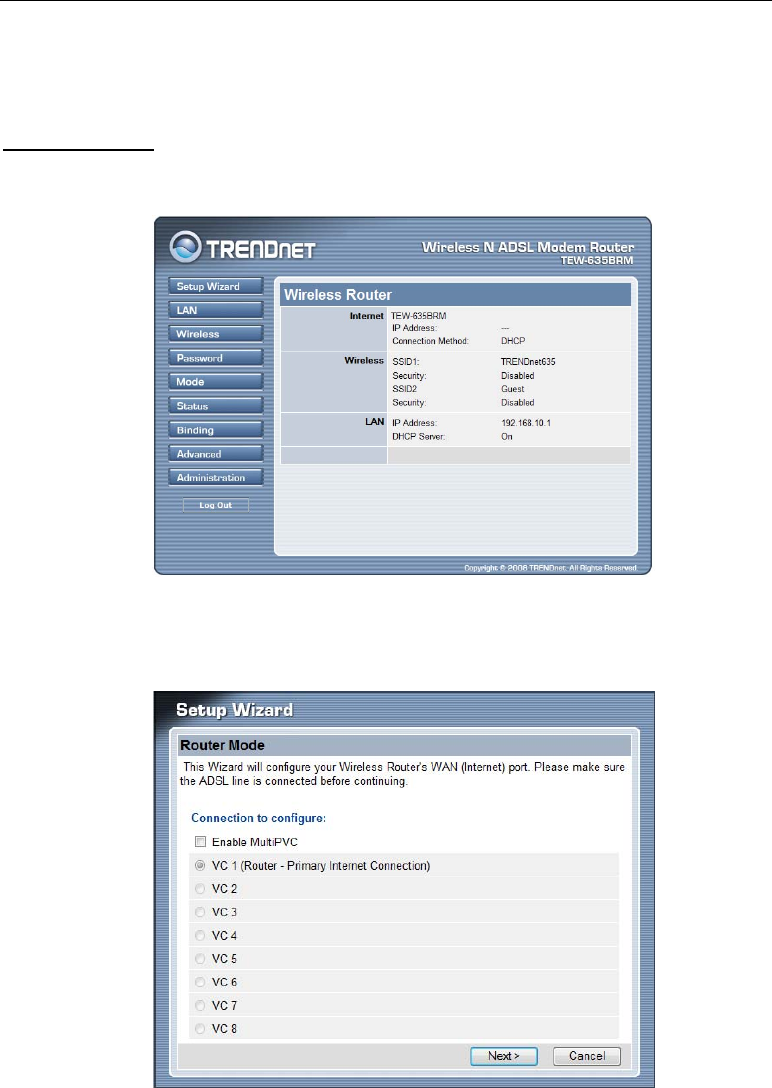
17
• Check all connections, and the front panel LEDs.
• Check that you have entered all data correctly
Manual-Selection
1. Click the Setup Wizard link on the main menu
2. On the first screen, select VC 1 (Router - Primary Internet Connection), then click "Next".
If you would like to enable the “Enable MultiPVC”, please select it now.
3. Select Manual Selection
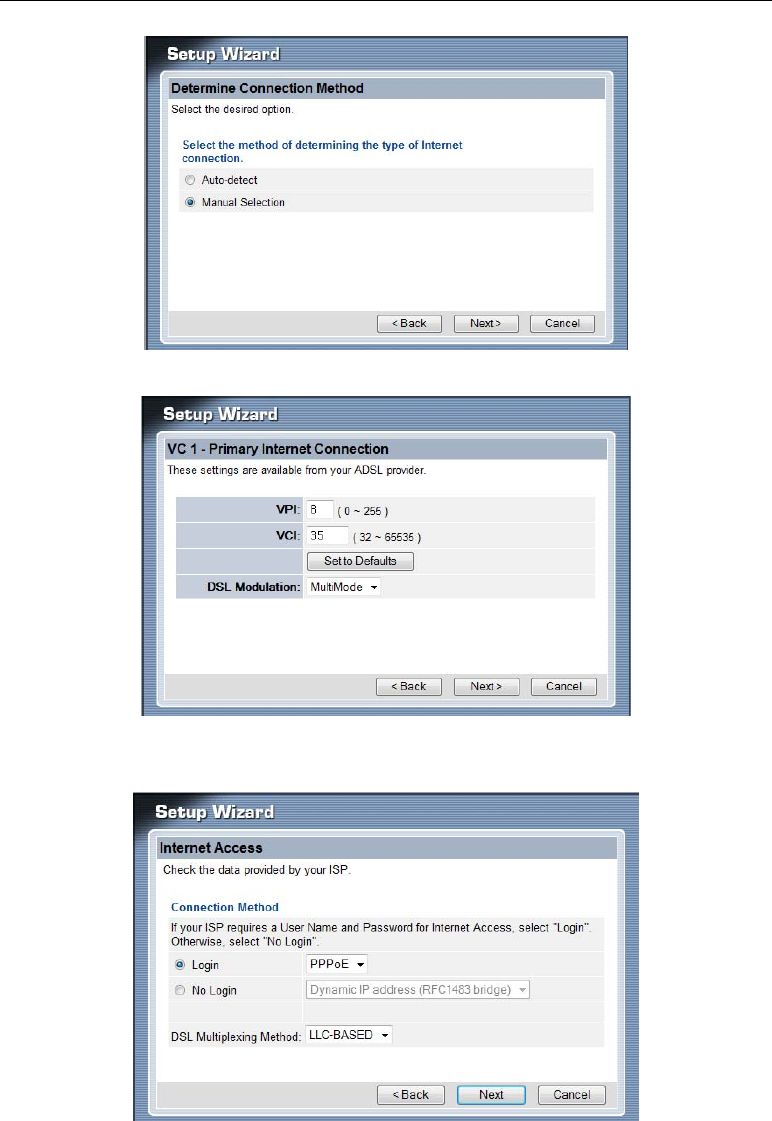
18
4. Type in the VPI and VCI value that provided by your ISP provider, then click "Next".
5. Configure the setting based on the information your IPS provided.
6. Type in the username & password if there is any
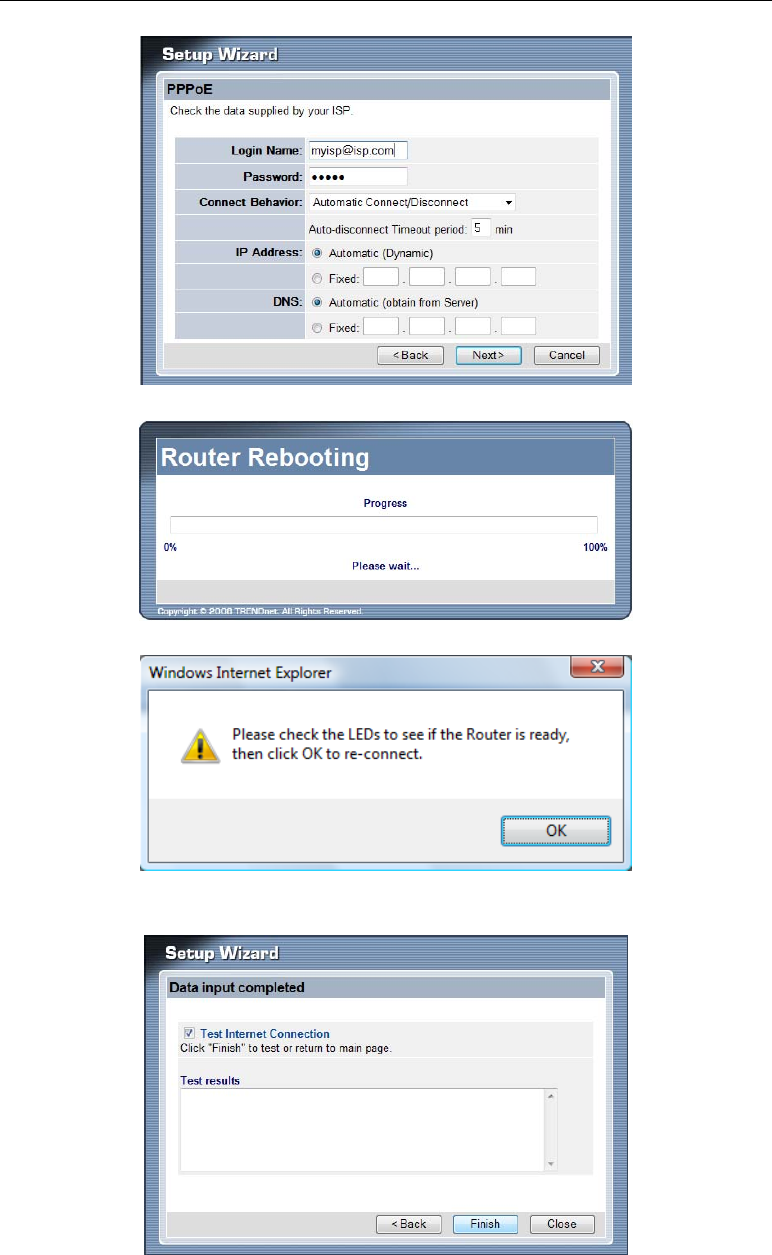
19
7. Waiting for the Modem Router reboot.
8. Click OK.
9. Click Finish to diagnostic the setting result
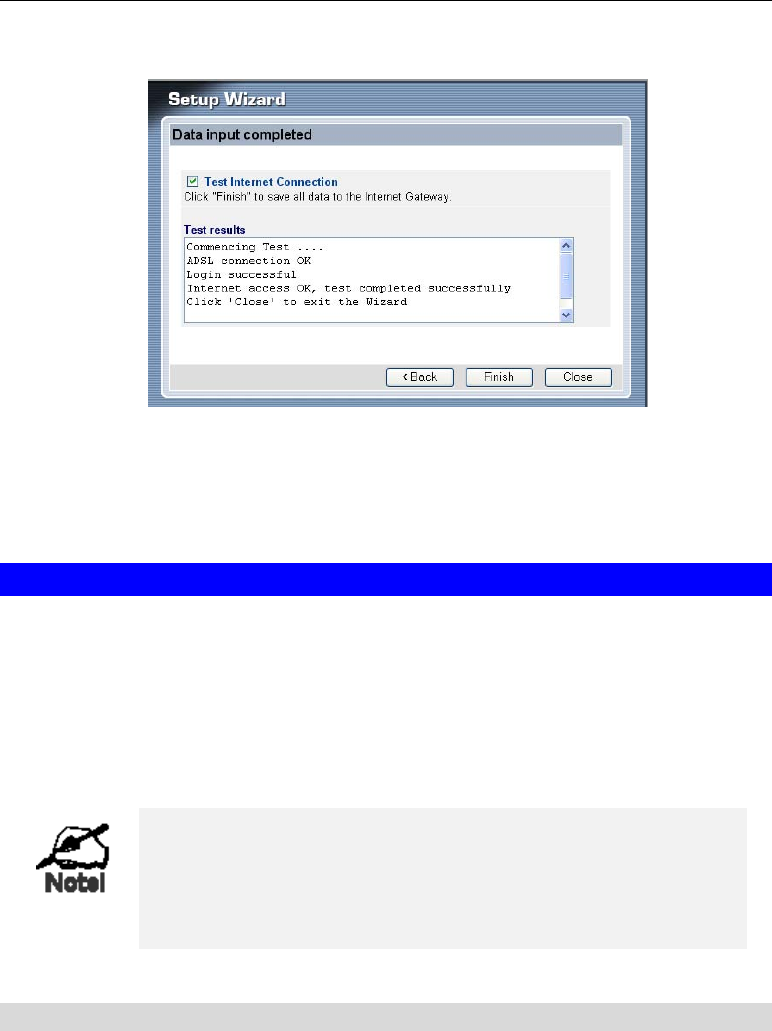
20
10. Click Close to exit the Setup Wizard
11. If the connection test fails:
• Check all connections, and the front panel LEDs.
• Check that you have entered all data correctly
Configuring VCs
The Wireless ADSL Modem Router supports multiple VCs (Virtual Circuits) on the ADSL
connection.
VC1 must be used for general-purpose Internet access. The other VCs are available for special
purposes, such as Video-on-Demand.
You can only use these VCs if supported by your ISP and ADSL service provider. In that case,
they will provide the necessary configuration data.
Some ISP's allow multiple PPPoE connections. This allows
multiple PCs to connect to the Internet using PPPoE client
software. When using the Wireless ADSL Modem Router,
multiple PPPoE connections are neither necessary nor sup-
ported.
To Configure additional VCs
1. Start the Setup Wizard again.
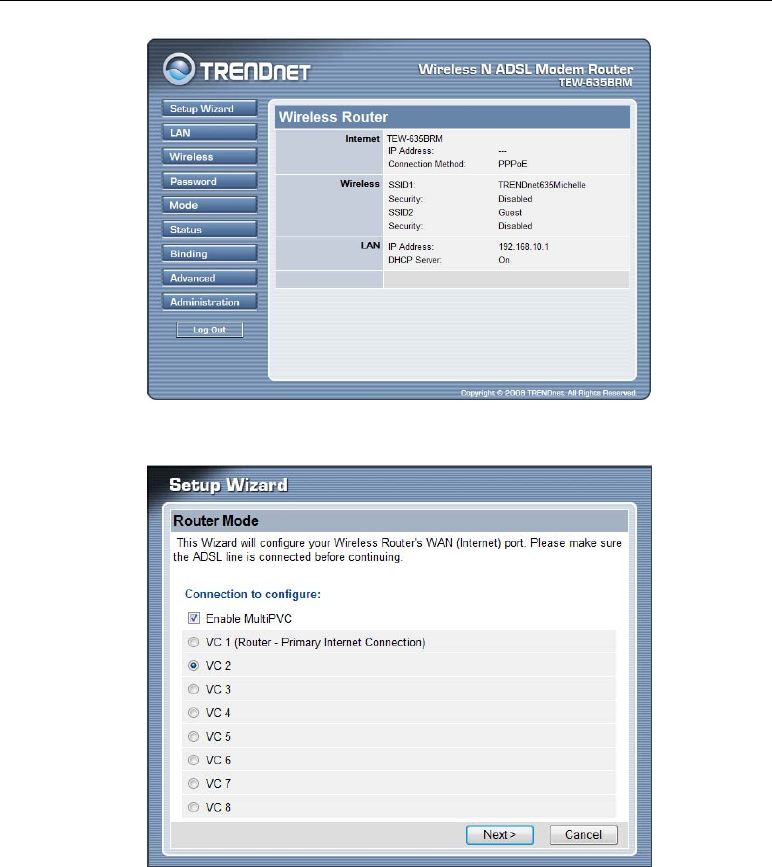
21
2. Select “Enable MultiPVC”, then select VC2 and click "Next"
3. Configure the VC setup screen following by the screen and information by your ISP pro-
vider to finish the VC setup.
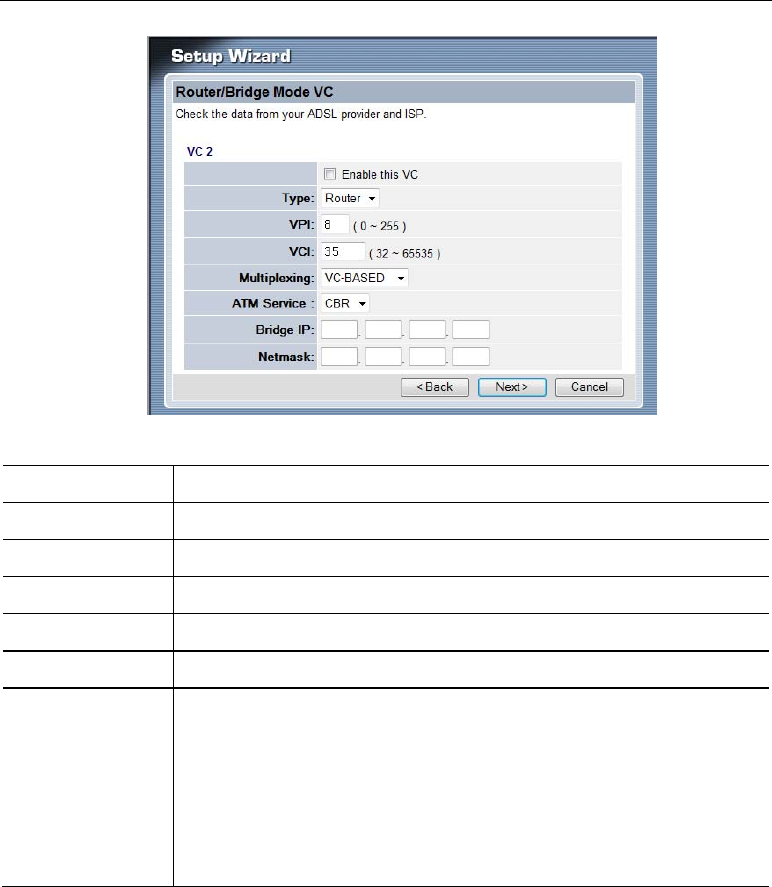
22
Setup Wizard VC Screen
VC The VC number is displayed
Enable To use this VC, you must enable it by checking this checkbox.
VPI Enter the VPI value provided by your ISP.
VCI Enter the VPI value provided by your ISP.
Multiplexing Select the multiplexing value provided by your ISP.
ATM Service Select the multiplexing value provided by your ISP.
LAN IP Address Enter the IP address of the device on your LAN which will receive the
data on this VC.
• For Video-on-Demand, this would be the IP address of your
SetTop Box.
• For VoIP, this would be the IP address of your VoIP TA.
• Note that this IP address does not have to be in the same IP ad-
dress range as other devices on your local LAN.
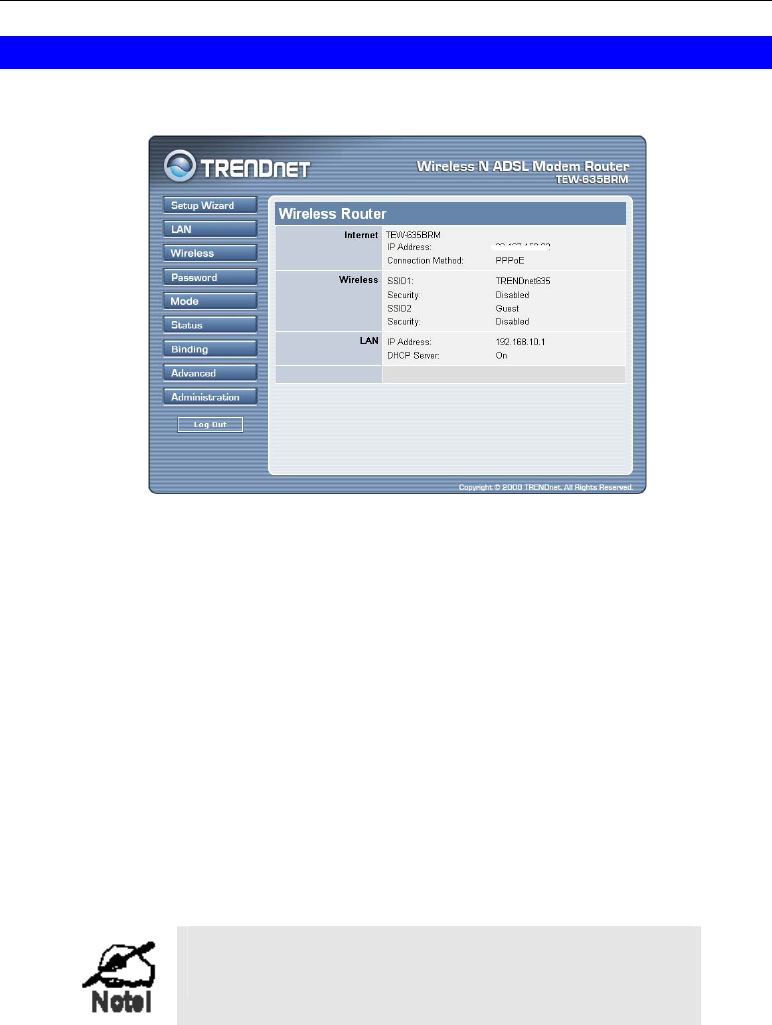
23
Main Screen
After finishing the Setup Wizard, the browse will back to main screen.
Main Menu
The main menu, on the left, contains links to the most-commonly used screen. To see the links
to the other available screens, click "Advanced" or "Administration".
The main menu also contains one (1) button:
• Log Out - When finished, you should click this button to logout.
Navigation & Data Input
• Use the menu bar on the left of the screen, and the "Back" button on your Browser, for
navigation.
• Changing to another screen without clicking "Save" does NOT save any changes you may
have made. You must "Save" before changing screens or your data will be ignored.
On each screen, clicking the "Help" button will
display help for that screen.
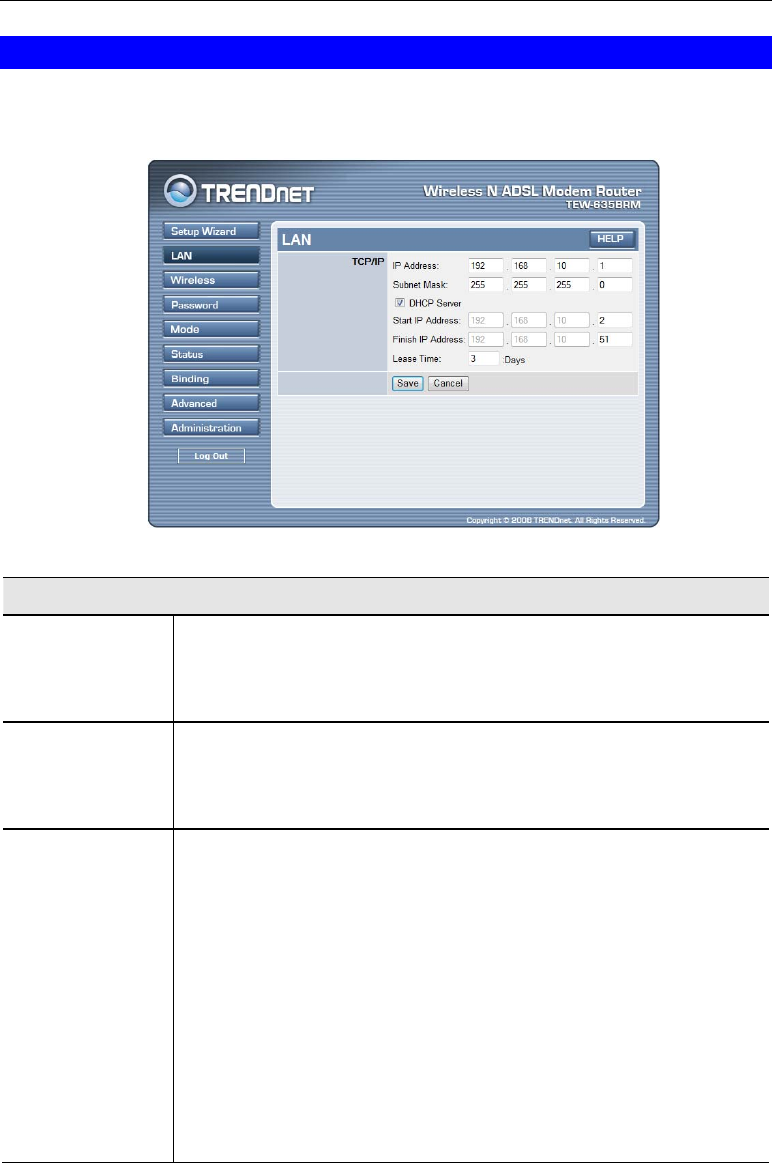
24
LAN Screen
Use the LAN link on the main menu to reach the LAN screen. An example screen is shown
below.
LAN Screen
TCP/IP
IP Address IP address for the Wireless ADSL Modem Router, as seen from the
local LAN. Use the default value unless the address is already in use or
your LAN is using a different IP address range. In the latter case, enter
an unused IP Address from within the range used by your LAN.
Subnet Mask The default value 255.255.255.0 is standard for small (class "C")
networks. For other networks, use the Subnet Mask for the LAN
segment to which the Wireless ADSL Modem Router is attached (the
same value as the PCs on that LAN segment).
DHCP Server • If Enabled, the Wireless ADSL Modem Router will allocate IP
Addresses to PCs (DHCP clients) on your LAN when they start
up. The default (and recommended) value is Enabled.
• If you are already using a DHCP Server, this setting must be
Disabled, and the existing DHCP server must be re-configured to
treat the Wireless ADSL Modem Router as the default Gateway.
See the following section for further details.
• The Start IP Address and Finish IP Address fields set the values
used by the DHCP server when allocating IP Addresses to DHCP
clients. This range also determines the number of DHCP clients
supported. Enter the desired value for the Lease Time, which
should be between 1 and 7.
See the following section for further details on using DHCP.

25
DHCP
What DHCP Does
A DHCP (Dynamic Host Configuration Protocol) Server allocates a valid IP address to a
DHCP Client (PC or device) upon request.
• The client request is made when the client device starts up (boots).
• The DHCP Server provides the Gateway and DNS addresses to the client, as well as
allocating an IP Address.
• The Wireless ADSL Modem Router can act as a DHCP server.
• Windows other non-Server versions of Windows will act as a DHCP client. This is the
default Windows setting for the TCP/IP network protocol. However, Windows uses the
term Obtain an IP Address automatically instead of "DHCP Client".
• You must NOT have two (2) or more DHCP Servers on the same LAN segment. (If your
LAN does not have other Routers, this means there must only be one (1) DHCP Server on
your LAN.)
Using the Wireless ADSL Modem Router's DHCP Server
This is the default setting. The DHCP Server settings are on the LAN screen. On this screen,
you can:
• Enable or Disable the Wireless ADSL Modem Router's DHCP Server function.
• Set the range of IP Addresses allocated to PCs by the DHCP Server function.
You can assign Fixed IP Addresses to some devices
while using DHCP, provided that the Fixed IP Addresses
are NOT within the range used by the DHCP Server.
Using another DHCP Server
You can only use one (1) DHCP Server per LAN segment. If you wish to use another DHCP
Server, rather than the Wireless ADSL Modem Router's, the following procedure is required.
• Disable the DHCP Server feature in the Wireless ADSL Modem Router. This setting is on
the LAN screen.
• Configure the DHCP Server to provide the Wireless ADSL Modem Router's IP Address
as the Default Gateway.
To Configure your PCs to use DHCP
This is the default setting for TCP/IP for all non-Server versions of Windows.
See Chapter 4 - Client Configuration for the procedure to check these settings.
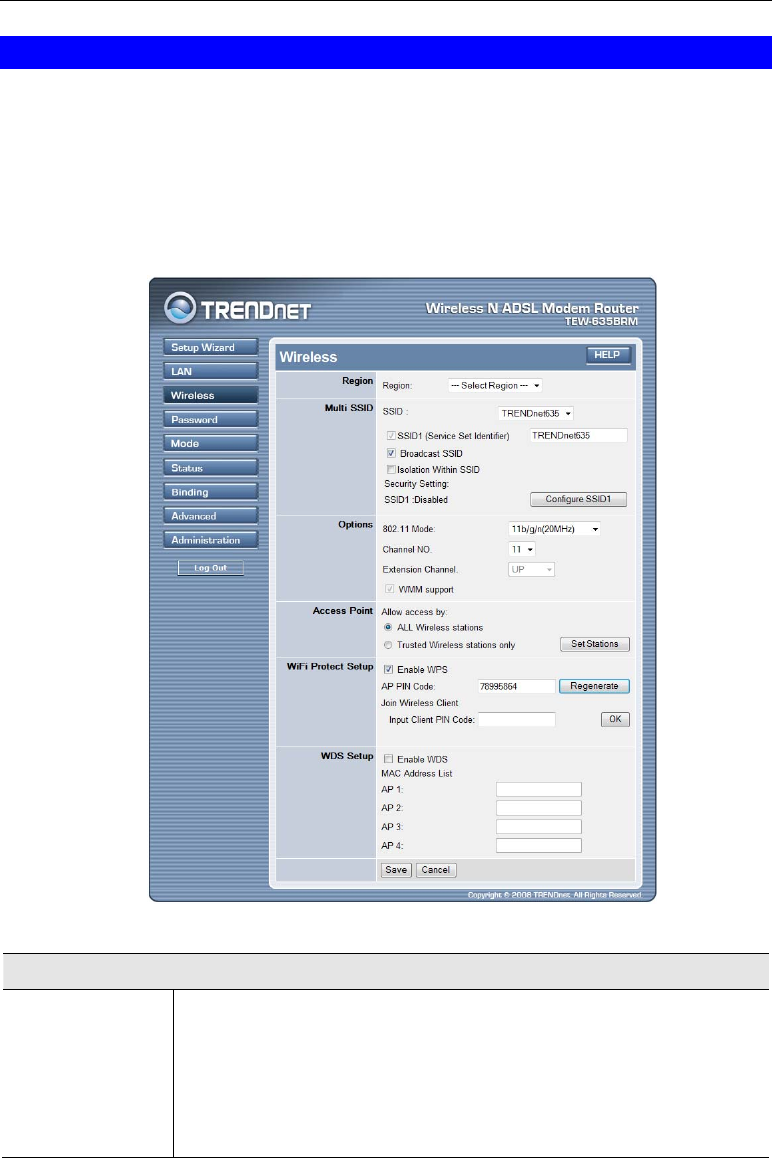
26
Wireless Screen
The Wireless ADSL Modem Router's settings must match the other Wireless stations.
Note that the Wireless ADSL Modem Router will automatically accept both 802.11b and
802.11g connections, and no configuration is required for this feature.
To change the Wireless ADSL Modem Router's default settings for the Wireless Access Point
feature, use the Wireless link on the main menu to reach the Wireless screen. An example
screen is shown below.
Wireless Screen
Region
Region Select the correct domain for your location. It is your responsibility to
ensure:
• That the Wireless ADSL Modem Router is only used in domains
for which is licensed.
• That you select the correct domain, so that only the legal channels
for that domain can be selected.

27
Multi SSID
SSID With Multiple SSIDs, you can have 2 SSIDs on one AP. For example,
a Guest SSID without encryption for visitors to have Internet access
only, and a Admin SSID with encryption for private use to secure your
company resources.
Select the desired SSID from the list to configure.
SSID 1/SSID 2 This is also called the "Network Name".
• If using an ESS (Extended Service Set, with multiple access
points) this ID is called an ESSID (Extended Service Set Identifi-
er).
• To communicate, all Wireless stations should use the same
SSID/ESSID.
Broadcast SSID If enabled, the Wireless ADSL Modem Router will broadcast its SSID.
This allows PCs and other wireless stations to detect this Access Point
and use the correct SSID.
If disabled, PC users will have to manually enter the SSID and other
details of the wireless interface before they can connect to this Access
Point.
Isolation within
SSID If Enabled, devices that have the same SSID will not be able to see
each other.
Security Setting The current Wireless security is displayed. The default value is Dis-
abled.
Configure SSID
1/SSID2 Button Click this button to access the Wireless security sub-screen, and view
or change the settings. See the following section for details.
Options
802.11 Mode Select the desired mode:
• 11b + 11g - Both 802.11b and 802.11g Wireless stations will be
able to use the Wireless Broadband Router.
• 11b/g/N (20MHz) - 802.11.g, 802.11b and 802.11n (20MHz)
Wireless stations can use the Wireless Broadband Router.
• 11b/g/N (20/40MHz) - 802.11b, 802.11g and 802.11n (20MHz or
40MHz) Wireless stations can use the Wireless Broadband Router.
• Disable: Wireless function is off
Channel No. Select the Channel you wish to use on your Wireless LAN.
• If you experience interference (shown by lost connections and/or
slow data transfers) you may need to experiment with different
channels to see which is the best.
• If using multiple Access Points, adjacent Access Points should use
different Channels to reduce interference.
Extension
Channel Select either UP or DOWN from the list.
WMM Support Enable or disable this feature as required.

28
Access Point
Allow access
by … Use this feature to determine which Wireless stations can use the
Access Point. The options are:
• All Wireless Stations - All wireless stations can use the access
point, provided they have the correct SSID and security settings.
• Trusted Wireless stations only - Only wireless stations you
designate as "Trusted" can use the Access Point, even if they have
the correct SSID and security settings.
This feature uses the MAC address to identify Wireless stations.
The MAC address is a low-level network identifier which is
unique to each PC or network device.
To define the trusted wireless stations, use the "Set Stations" but-
ton.
Set Stations
Button Click this button to manage the trusted PC database.
WiFi Protect Setup
Enable WPS Enable this if you want to use Wireless WPS function.
AP PIN Code Click the Regenerate button to have the new pin code in the field.
Input Client PIN
Code Enter the client’s PIN code in the field and click OK to add the client
device.
WDS
Enable WDS This feature allows you to make a completely wireless network by
using multiple access points without connecting them with a wire
LAN.
In order to make the WDS working successfully, the access point must
use the same channel, SSID, as well as the wireless encryption method.
MAC Address
List Enter the MAC address(es) of the AP(s) into the fields to allow the
following access points to be connected to the wireless router.
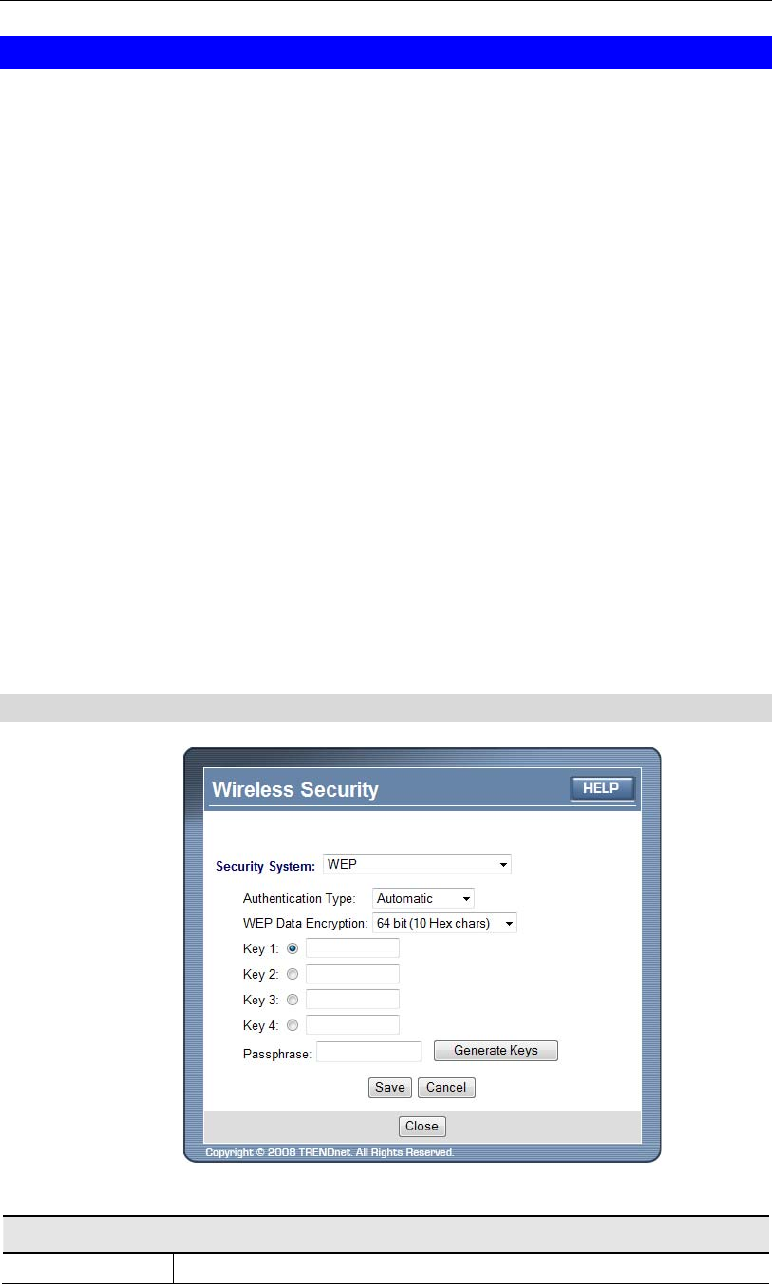
29
Wireless Security
This screen is accessed by clicking the "Configure SSID" button on the Wireless screen. There
are 3 options for Wireless security:
• Disabled - no data encryption is used.
• WEP - data is encrypted using the WEP standard.
• WPA-PSK - data is encrypted using the WPA-PSK standard. This is a later standard than
WEP, and provides much better security than WEP. If all your Wireless stations support
WPA-PSK, you should use WPA-PSK rather than WEP.
• WPA2-PSK - This is a further development of WPA-PSK, and offers even greater securi-
ty, using the AES (Advanced Encryption Standard) method of encryption.
• Mixed WPA-PSK/WAP2-PSK - This method, sometimes called "Mixed Mode", allows
clients to use EITHER WPA-PSK OR WPA2-PSK.
• WPA-802.1x - This version of WPA requires a Radius Server on your LAN to provide the
client authentication according to the 802.1x standard. Data transmissions are encrypted
using the WPA standard.
If this option is selected:
• This Access Point must have a "client login" on the Radius Server.
• Each user must have a "user login" on the Radius Server.
• Each user's wireless client must support 802.1x and provide the login data when required.
• All data transmission is encrypted using the WPA standard. Keys are automatically
generated, so no key input is required.
WEP Wireless Security
WEP Screen
WEP Data Encryption
WEP Data Select the desired option, and ensure the Wireless Stations use the
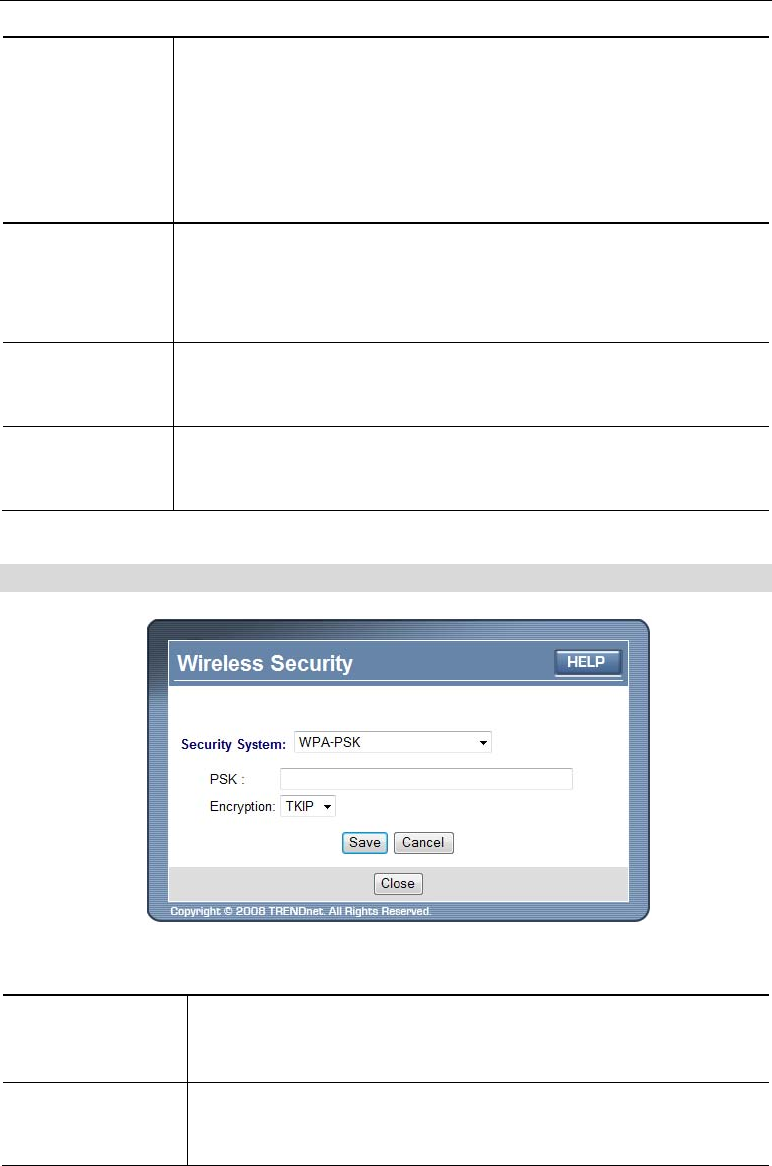
30
Encryption same setting.
• 64 Bit - data is encrypted, using the default key, before being
transmitted. You must enter at least the default key. For 64 Bit En-
cryption, the key size is 10 chars in HEX (0~9 and A~F).
• 128 Bit - data is encrypted, using the default key, before being
transmitted. You must enter at least the default key. For 128 Bit
Encryption, the key size is 26 chars in HEX (0~9 and A~F).
Default Key Select the key you wish to be the default. Transmitted data is
ALWAYS encrypted using the Default Key; the other Keys are for
decryption only.
You must enter a Key Value for the Default Key.
Key Value Enter the key value or values you wish to use. The Default Key is
required, the other keys are optional. Other stations must have the
same key.
Passphrase If desired, you can generate a key from a phrase, instead of entering
the key value directly. Enter the desired phrase, and click the "Gener-
ate Keys" button.
WPA-PSK Wireless Security
WPA-PSK Screen
PSK Enter the PSK (network key). Data is encrypted using a key derived
from the network key. Other Wireless Stations must use the same
network key. The PSK must be from 8 to 63 characters in length.
Encryption The WPA-PSK standard allows different encryption methods to be
used. Select the desired option. Wireless Stations must use the same
encryption method.
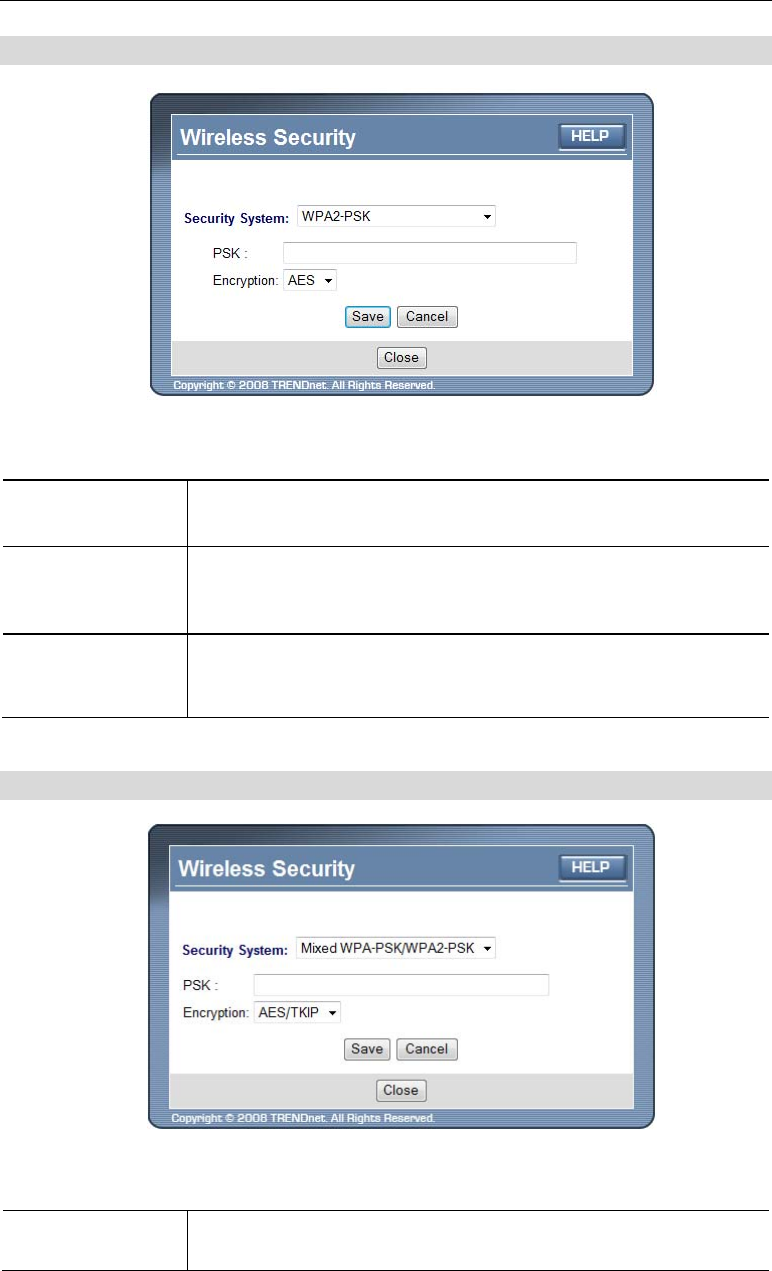
31
WPA2-PSK Wireless Security
WPA2-PSK Screen
Authentication This is a further development of WPA-PSK, and offers even greater
security.
PSK Enter the PSK (network key). Data is encrypted using a key derived
from the network key. Other Wireless Stations must use the same
network key. The PSK must be from 8 to 63 characters in length.
Encryption The WPA2-PSK standard allows different encryption methods to be
used. Select the desired option. Wireless Stations must use the same
encryption method.
Mixed WPA-PSK/WAP2-PSK Wireless Security
Mixed WPA-PSK/WAP2-PSK Screen
Authentication This method, sometimes called "Mixed Mode", allows clients to use
EITHER WPA-PSK OR WPA2-PSK.

32
PSK Enter the PSK (network key). Data is encrypted using a key derived
from the network key. Other Wireless Stations must use the same
network key. The PSK must be from 8 to 63 characters in length.
Encryption The Mixed WPA-PSK/WAP2-PSK standard allows different encryp-
tion methods to be used. Select the desired option. Wireless Stations
must use the same encryption method.
WPA-802.1x Wireless Security
WPA-802.1x Screen
Server Address Enter the server address here.
Radius Port Enter the port number used for connections to the Radius Server.
Shared Key Enter the shared key. Data is encrypted using a key derived from the
network key. Other Wireless Stations must use the same key. The
key must be from 8 to 63 characters in length.
Encryption The encryption method is TKIP. Wireless Stations must also use
TKIP.
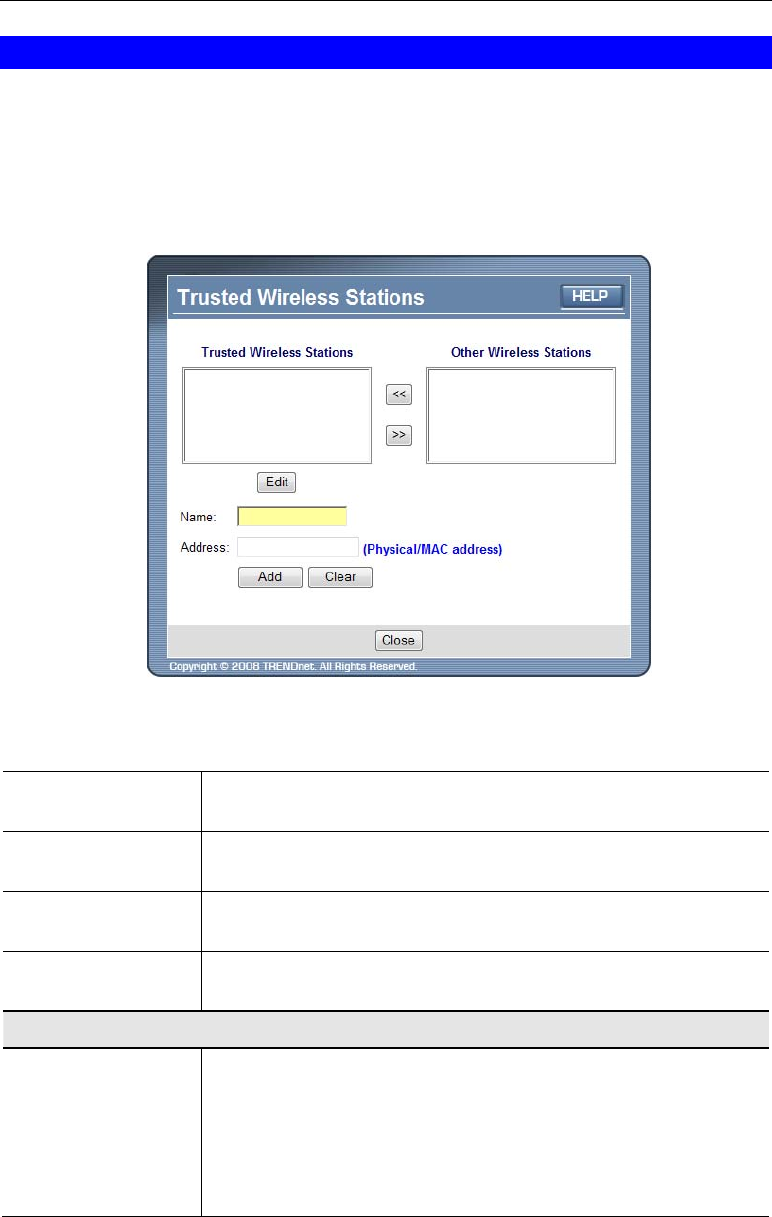
33
Trusted Wireless Stations
This feature can be used to prevent unknown Wireless stations from using the Access Point.
This list has no effect unless the setting Allow access by trusted stations only is enabled.
To change the list of trusted wireless stations, use the Modify List button on the Access Control
screen. You will see a screen like the sample below.
Trusted Wireless Stations
Trusted Wireless
Stations This lists any Wireless Stations which you have defined as
“Trusted”.
Other Wireless
Stations This list any Wireless Stations detected by the Access Point, which
you have not defined as "Trusted".
Name The name assigned to the Trusted Wireless Station. Using this
feature when adding or editing a Trusted Station.
Address The MAC (physical) address of the Trusted Wireless Station. Using
this feature when adding or editing a Trusted Station.
Buttons
<< Add a Trusted Wireless Station to the list (move from the "Other
Stations" list).
• Select an entry (or entries) in the "Other Stations" list, and
click the " << " button.
• Enter the Address (MAC or physical address) of the wireless
station, and click the "Add " button.

34
>> Delete a Trusted Wireless Station from the list (move to the "Other
Stations" list).
• Select an entry (or entries) in the "Trusted Stations" list.
• Click the " >> " button.
Edit Use this to change an existing entry in the "Trusted Stations" list:
1. Select the Station in the Trusted Station list.
2. Click the Edit button. The address will be copied to the "Ad-
dress" field, and the Add button will change to Update.
3. Edit the address (MAC or physical address) as required.
4. Click Update to save your changes.
Add (Update) To add a Trusted Station which is not in the "Other Wireless
Stations" list, enter the required data and click this button.
When editing an existing Wireless Station, this button will change
from Add to Update.
Clear Clear the Name and Address fields.
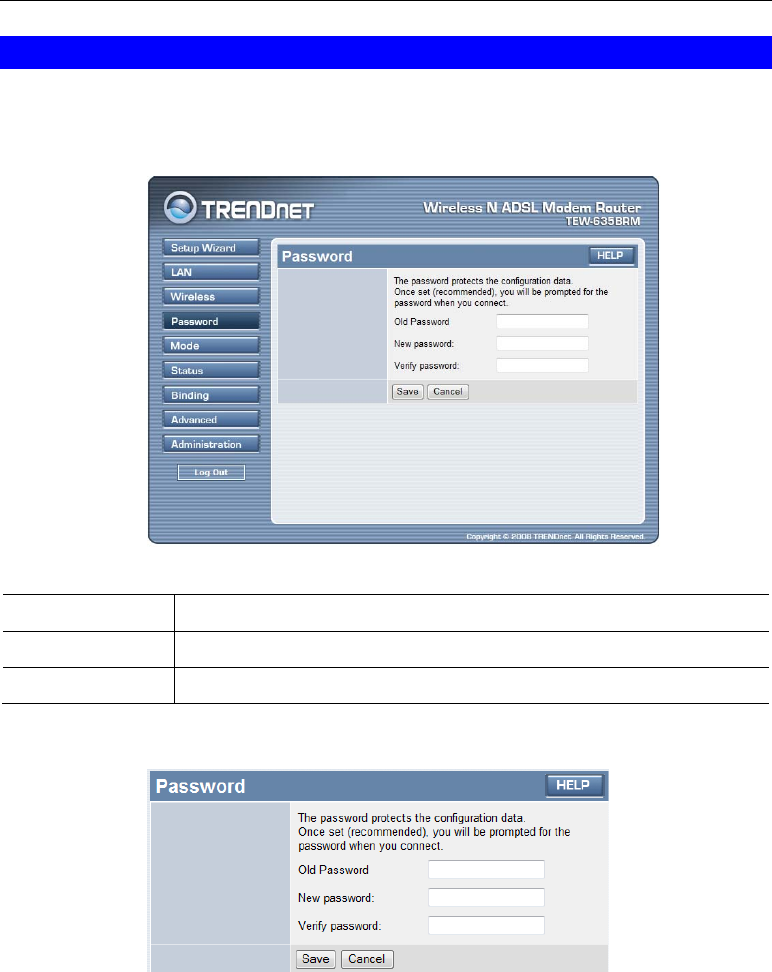
35
Password Screen
The password screen allows you to assign a password to the Wireless ADSL Modem Router.
Old Password Enter the existing password in this field.
New password Enter the new password here.
Verify password Re-enter the new password here.
After click “Save” button, the information will store into the memory and the field will leave
as blank.
Click any button to continue, it screen will prompt the password login page. Enter correct
password to login the page again. Please note: the username name is always “admin”.
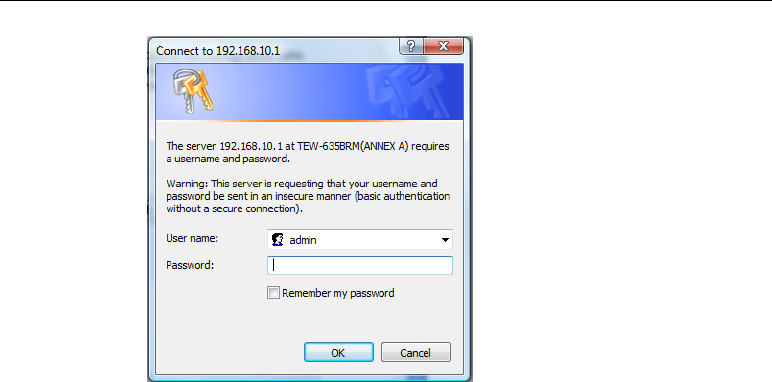
36
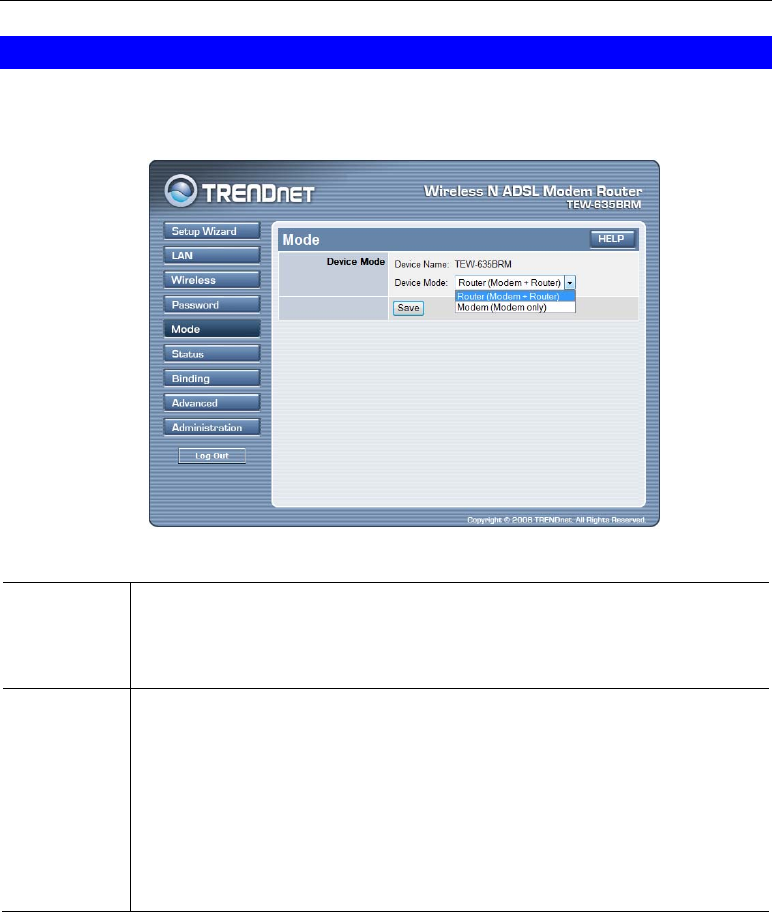
37
Mode Screen
Use this screen to change the mode between Router mode and Modem (Bridge) mode.
The example show below is Router mode. For detail Modem mode, please refer to Chapter 7.
Select the desired option, and click "Save".
Router
(Router +
Modem)
Both the ADSL Modem and the Router features are operational. In this
mode, this device can provide shared Internet Access to all your LAN users.
Also, by default, it acts a DHCP Server, providing an IP address and related
information to all Wireless and LAN users.
Modem
(Modem
only)
Only the ADSL Modem component is operational.
• All Router features are disabled. This device is "transparent" - it does
not perform any operations or make any changes to the network traffic
passing through it.
• You need to have a DHCP Server on your LAN to provide IP addresses
to the Wireless clients using this Access Point.
• All traffic received on either the Wireless or LAN interface will be sent
over the ADSL connection.
Notes:
• Generally, you should NOT use modem mode. Only select this mode if you understand
what you actually needed.
• After changing the mode, this device will restart, which will take a few seconds. The
menu will also change, depending on the mode you are in.
• The Wireless Access Point can function in either Router or Modem mode. However, in
general it is not recommend to combine a Modem with an Access Point, because all data
received from the wireless stations will be sent over the modem connection. (Since the
modem is transparent, it does not examine the traffic to determine whether the traffic is for
the LAN or the WAN.)
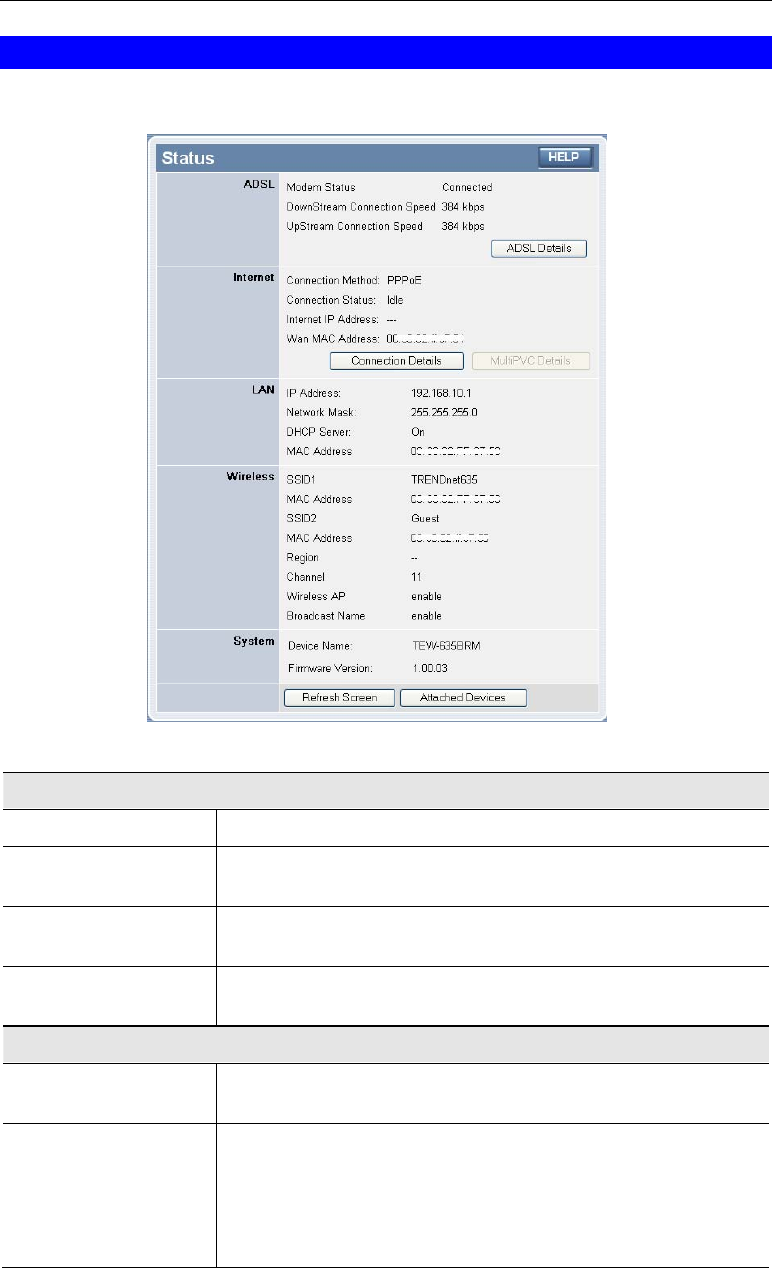
38
Status
Use the Status link on the main menu to view this screen.
Status Screen
ADSL
Modem Status This indicates the status of the ADSL modem component.
DownStream
Connection Speed Displays the speed for the DownStream Connection.
UpStream
Connection Speed If connected, displays the speed for the Up Stream (upload)
ADSL Connection.
ADSL Details Click this button to open a sub-window and view the details of
each VC (Virtual Circuit).
Internet (VC1)
Connection Method Displays the current connection method, as set in the Setup
Wizard.
Connection Status This indicates the current status of the Internet Connection
• Active - Connection exists
• Idle - No current connection, but no error has been detected.
This condition normally arises when an idle connection is au-
tomatically terminated.

39
• Failed - The connection was terminated abnormally. This
could be caused by Modem failure, or the loss of the connec-
tion to the ISP's server.
If there is an error, you can click the "Connection Details" button
to find out more information.
Internet IP Address This IP Address is allocated by the ISP (Internet Service Provid-
er). If using a dynamic IP address, and no connection currently
exists, this information is unavailable.
WAN MAC Address It displays the MAC address for the WAN.
Connection Details Click this button to open a sub-window and view a detailed
description of the current connection. Depending on the type of
connection, a "log" may also be available.
MultiPVC Details Click this button to view the details of multi PVC in the sub-
screen.
Connection Details Click this button to open a sub-window and view a detailed
description of the current connection.
LAN
IP Address The IP Address of the Wireless ADSL Modem Router.
Network Mask The Network Mask (Subnet Mask) for the IP Address above.
DHCP Server This shows the status of the DHCP Server function. The value
will be "Enabled" or "Disabled".
MAC Address This shows the MAC Address for the Wireless ADSL Modem
Router, as seen on the LAN interface.
Wireless
SSID 1 It displays the name of the SSID 1.
SSID 2 It displays the name of the SSID 2.
Region The current region, as set on the Wireless screen.
Channel This shows the Channel currently used, as set on the Wireless
screen.
Wireless AP This indicates whether or not the Wireless Access Point feature is
enabled.
Broadcast Name This indicates whether or not the SSID is Broadcast. This setting
is on the Wireless screen.
System
Device Name The current name of the Router. This name is also the "hostname"
for users with an "@Home" type connection.
Firmware Version The version of the current firmware installed.
Buttons
Attached Devices This will open a sub-window, showing all LAN and Wireless
devices currently on the network.

40
Refresh Screen Update the data displayed on screen.
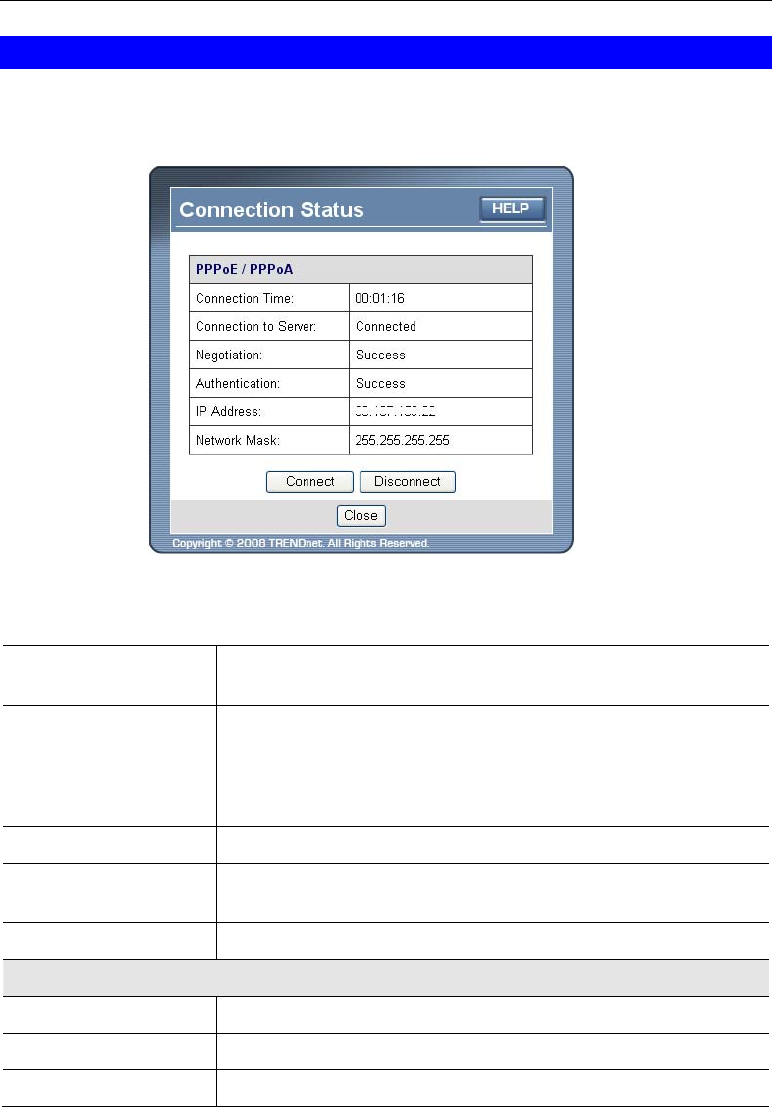
41
Connection Status - PPPoE & PPPoA
If using PPPoE (PPP over Ethernet) or PPPoA (PPP over ATM), a screen like the following
example will be displayed when the "Connection Details" button is clicked.
PPPoE/PPPoA Screen
Connection Time This indicates how long the current connection has been estab-
lished.
PPPoE Link Status This indicates whether or not the connection is currently estab-
lished.
• Click "Connect" button to establish an Internet connection.
• Click “Disconnect” to exit an Internet connection.
Negotiation This indicates the status of the PPPoE Server login.
IP Address The IP Address of this device, as seen by Internet users. This
address is allocated by your ISP (Internet Service Provider).
Network Mask The Network Mask associated with the IP Address above.
Buttons
Connect Click this button to establish a Internet connection.
Disconnect Click this button to exit an Internet connection.
Close Close the window.
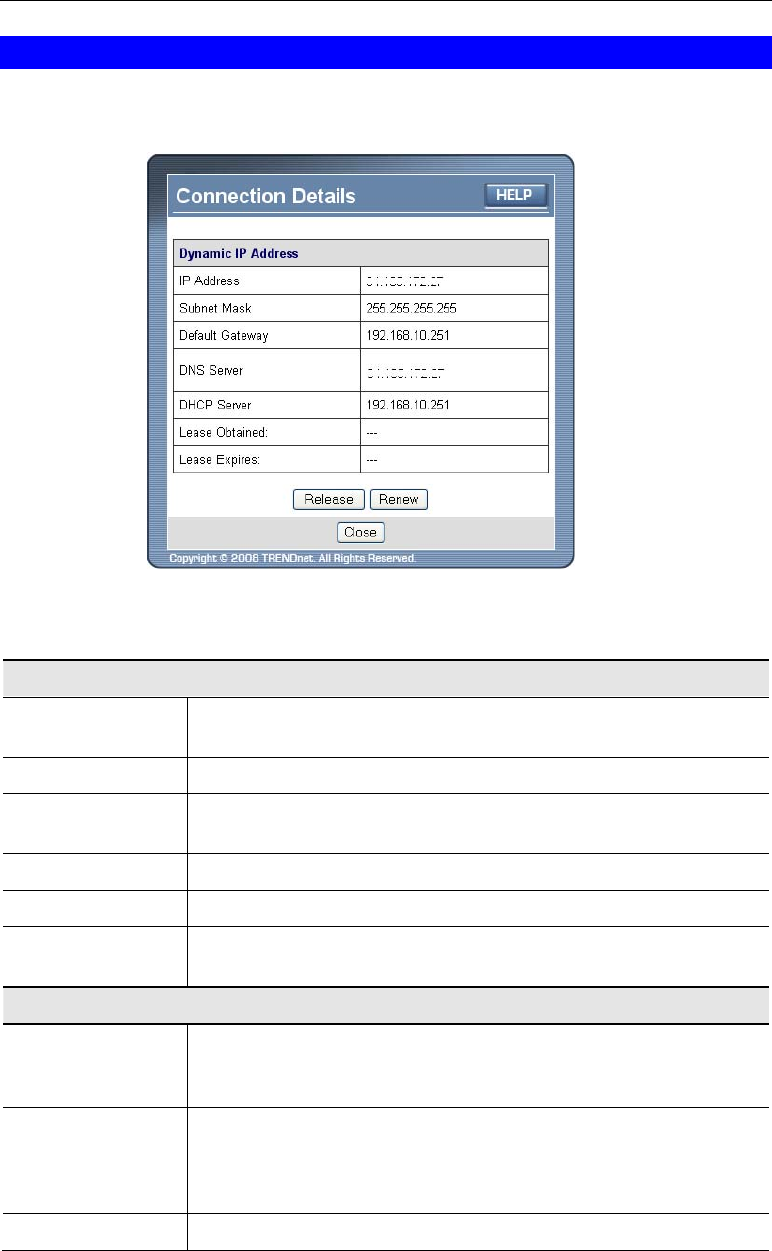
42
Connection Details - Dynamic IP Address
If your access method is "Direct" (no login), with a Dynamic IP address, a screen like the
following example will be displayed when the "Connection Details" button is clicked.
Dynamic IP address
Internet
IP Address The current IP Address of this device, as seen by Internet users. This
address is allocated by your ISP (Internet Service Provider).
Network Mask The Network Mask associated with the IP Address above.
Default Gateway The IP address of the remote Gateway or Router associated with the
IP Address above.
DHCP Server The IP address of your ISP's DHCP Server.
DNS Server The IP address of the Domain Name Server which is currently used.
Lease Obtained
Lease Expires This indicates when the current IP address was obtained, and how
long before this IP address allocation (the DCHP lease) expires.
Buttons
Release If an IP Address has been allocated to the Wireless ADSL Modem
Router (by the ISP's DHCP Server, clicking the "Release" button will
break the connection and release the IP Address.
Renew If the ISP's DHCP Server has NOT allocated an IP Address for the
Wireless ADSL Modem Router, clicking the "Renew" button will
attempt to re-establish the connection and obtain an IP Address from
the ISP's DHCP Server.
Close Close this window.
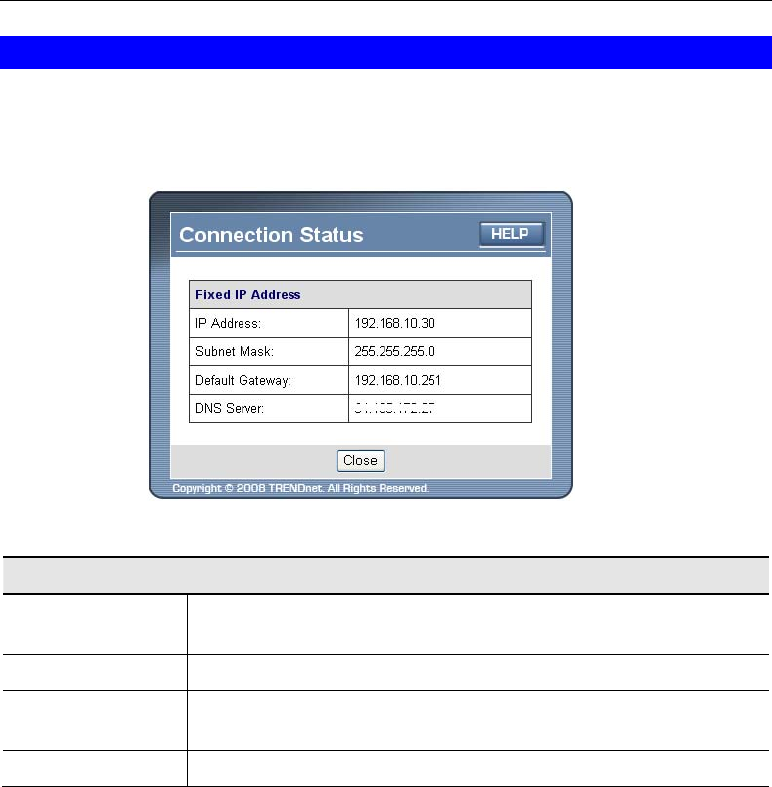
43
Connection Details - Fixed IP Address
If your access method is "Direct" (no login), with a fixed IP address, a screen like the follow-
ing example will be displayed when the "Connection Details" button is clicked.
Fixed IP address Screen
Internet
IP Address The IP Address of this device, as seen by Internet users. This address
is allocated by your ISP (Internet Service Provider).
Network Mask The Network Mask associated with the IP Address above.
Default Gateway The IP Address of the remote Gateway or Router associated with the
IP Address above.
DNS Server The IP Address of the Domain Name Server which is currently used.
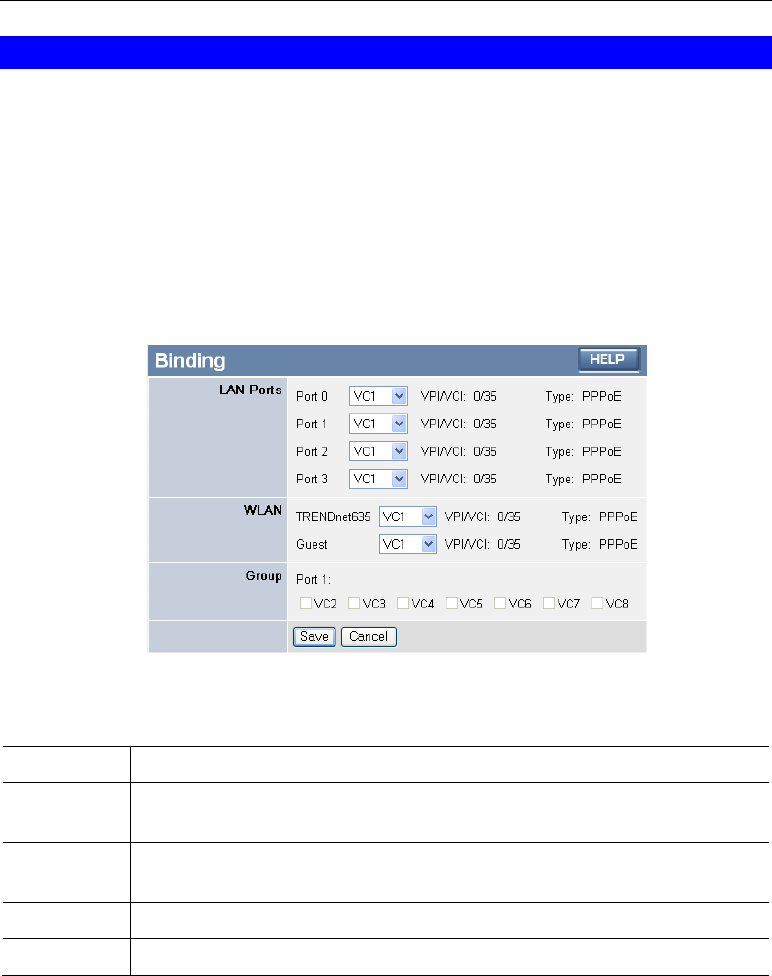
44
Binding Function
The Binding feature is for MultiPVC. If you have enabled multiple PVCs and set the WAN
connection methods individually, you can bind the LAN Ports and WLAN Port to them using
this page. While binding one port to the selected PVC, this port would connect Internet via this
PVC. The PVC port should be configured first or the bound port will not access the Internet.
While in Modem mode, Bridge connection can only be set for all the PVCs. You can click
MultiPVC Details in the Status screen to see all the information.
Note: When you switch from Router (Modem+Router) to Modem mode, all the connection
methods will change to would be changed to Bridge. You may need to reconfigure the Bridge
IP/Netmask through wizard pages if you want to access the WEB Server via the relevant port.
Binding Screen
Port 0 This port is always bound to the Primary Internet Connection VC1.
Port 1~3 These ports can be bound to VC2~VC8. If it is not enabled, it would be
bound to VC1 as default.
WLAN The WLAN Port can be bound to VC2~VC8. If it is not enabled,, it would
be bound to VC1 as default.
VPI/VCI It displays the current VPI/VCI information of the selected PVC.
Type It displays the current connection type of the selected PVC.

45
Chapter 4
Computer Configuration
This Chapter details the Computer Configuration required on the local ("In-
ternal") LAN.
Overview
For each PC, the following may need to be configured:
• TCP/IP network settings
• Internet Access configuration
• Wireless configuration
Windows Clients
This section describes how to configure Windows clients for Internet access via the Wireless
ADSL Modem Router.
The first step is to check the PC's TCP/IP settings.
The Wireless ADSL Modem Router uses the TCP/IP network protocol for all functions, so it is
essential that the TCP/IP protocol be installed and configured on each PC.
TCP/IP Settings - Overview
If using the default Wireless ADSL Modem Router setting, and the default
Windows TCP/IP settings, no changes need to be made.
• By default, the Wireless ADSL Modem Router will act as a DHCP Server, automatically
providing a suitable IP Address (and related information) to each PC when the PC boots.
• For all non-Server versions of Windows, the default TCP/IP setting is to act as a DHCP
client.
If using a Fixed (specified) IP address, the following changes are re-
quired:
• The Gateway must be set to the IP address of the Wireless ADSL Modem Router
• The DNS should be set to the address provided by your ISP.
If your LAN has a Router, the LAN Administrator must re-
configure the Router itself. Refer to Chapter 6 - Ad-
vanced Administrator for details.
4
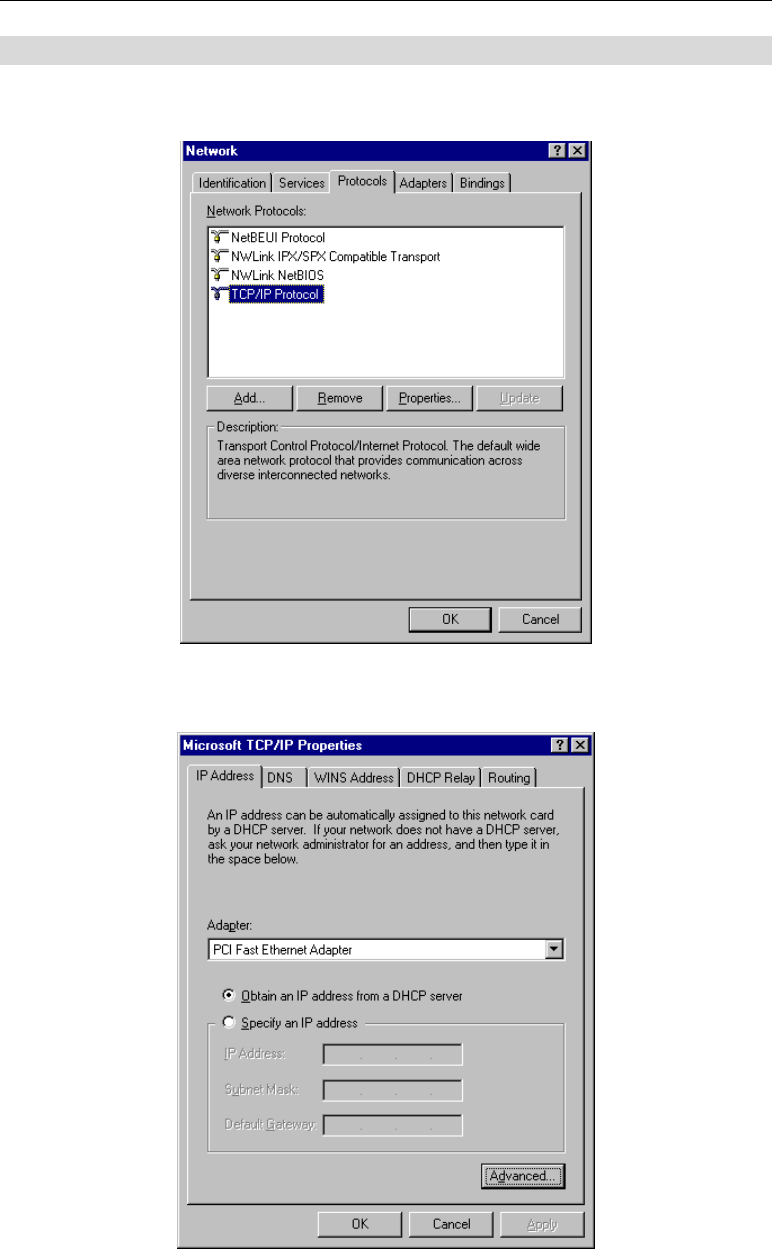
46
Checking TCP/IP Settings - Windows NT4.0
1. Select Control Panel - Network, and, on the Protocols tab, select the TCP/IP protocol, as
shown below.
2. Click the Properties button to see a screen like the one below.
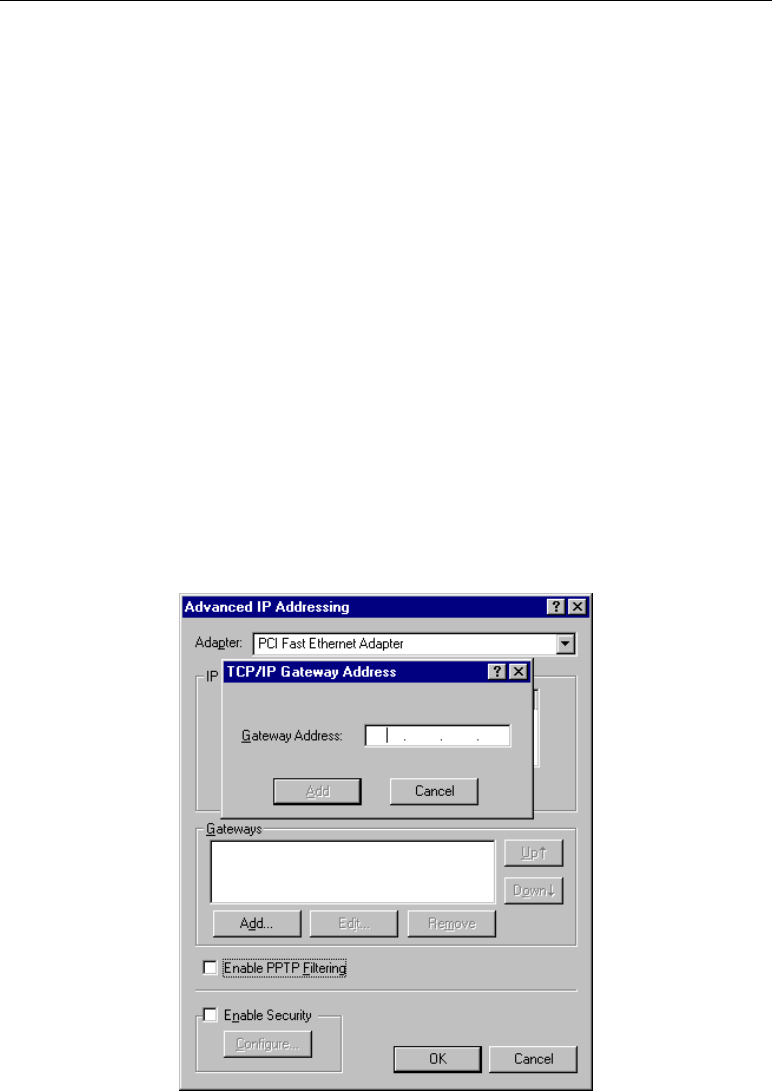
47
3. Select the network card for your LAN.
4. Select the appropriate radio button - Obtain an IP address from a DHCP Server or Specify
an IP Address, as explained below.
Obtain an IP address from a DHCP Server
This is the default Windows setting. Using this is recommended. By default, the Wireless
ADSL Modem Router will act as a DHCP Server.
Restart your PC to ensure it obtains an IP Address from the Wireless ADSL Modem Router.
Specify an IP Address
If your PC is already configured, check with your network administrator before making the
following changes.
1. The Default Gateway must be set to the IP address of the Wireless ADSL Modem Router.
To set this:
• Click the Advanced button on the screen above.
• On the following screen, click the Add button in the Gateways panel, and enter the Wire-
less ADSL Modem Router's IP address, as shown in Error! Reference source not found.
below.
• If necessary, use the Up button to make the Wireless ADSL Modem Router the first entry
in the Gateways list.
2. The DNS should be set to the address provided by your ISP, as follows:
• Click the DNS tab.
• On the DNS screen, shown below, click the Add button (under DNS Service Search
Order), and enter the DNS provided by your ISP.
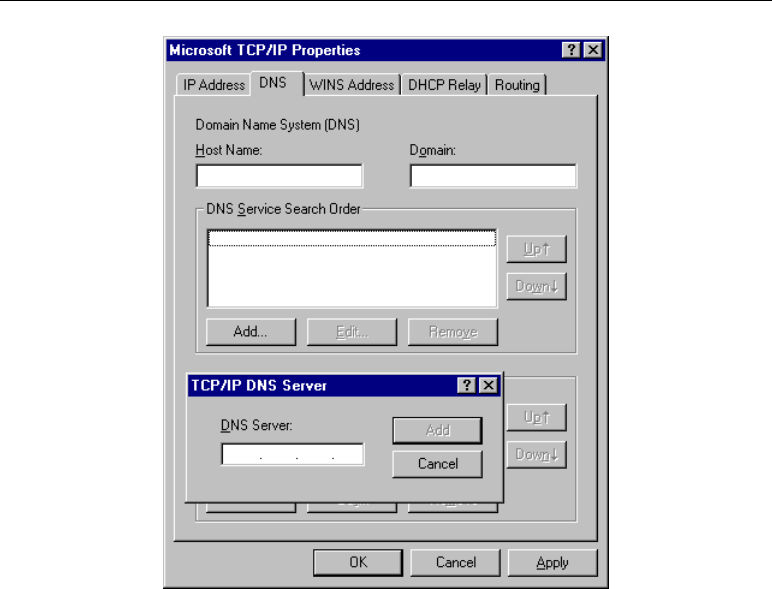
48
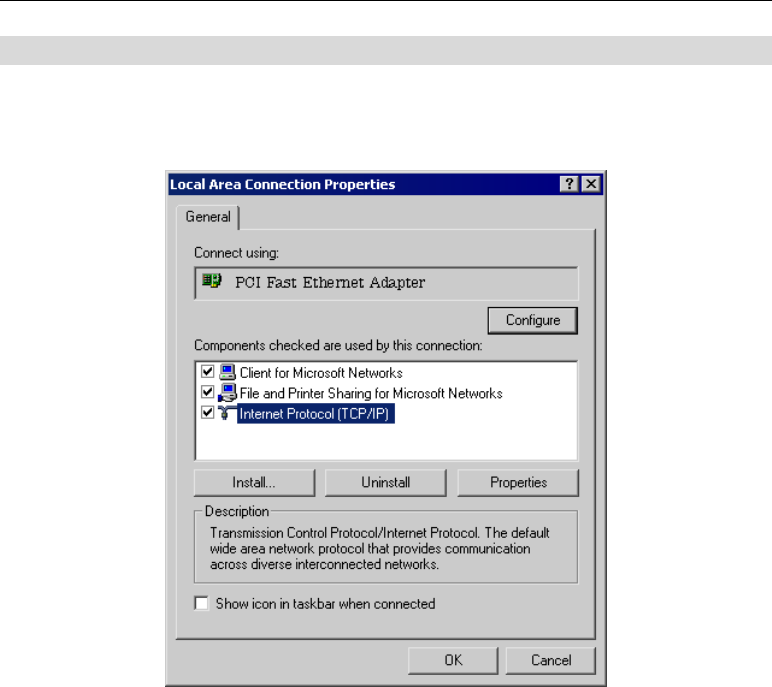
49
Checking TCP/IP Settings - Windows 2000:
1. Select Control Panel - Network and Dial-up Connection.
2. Right - click the Local Area Connection icon and select Properties. You should see a
screen like the following:
3. Select the TCP/IP protocol for your network card.
4. Click on the Properties button. You should then see a screen like the following.
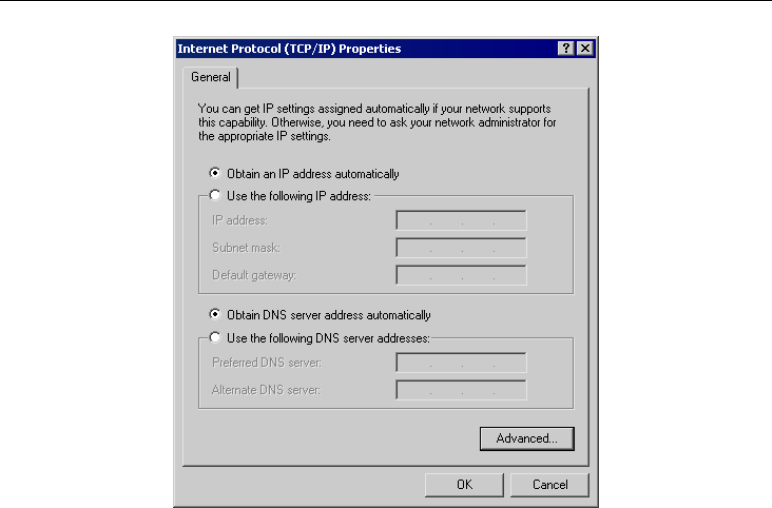
50
5. Ensure your TCP/IP settings are correct, as described below.
Using DHCP
To use DHCP, select the radio button Obtain an IP Address automatically. This is the default
Windows setting. Using this is recommended. By default, the Wireless ADSL Modem Router
will act as a DHCP Server.
Restart your PC to ensure it obtains an IP Address from the Wireless ADSL Modem Router.
Using a fixed IP Address ("Use the following IP Address")
If your PC is already configured, check with your network administrator before making the
following changes.
• Enter the Wireless ADSL Modem Router's IP address in the Default gateway field and
click OK. (Your LAN administrator can advise you of the IP Address they assigned to the
Wireless ADSL Modem Router.)
• If the DNS Server fields are empty, select Use the following DNS server addresses, and
enter the DNS address or addresses provided by your ISP, then click OK.
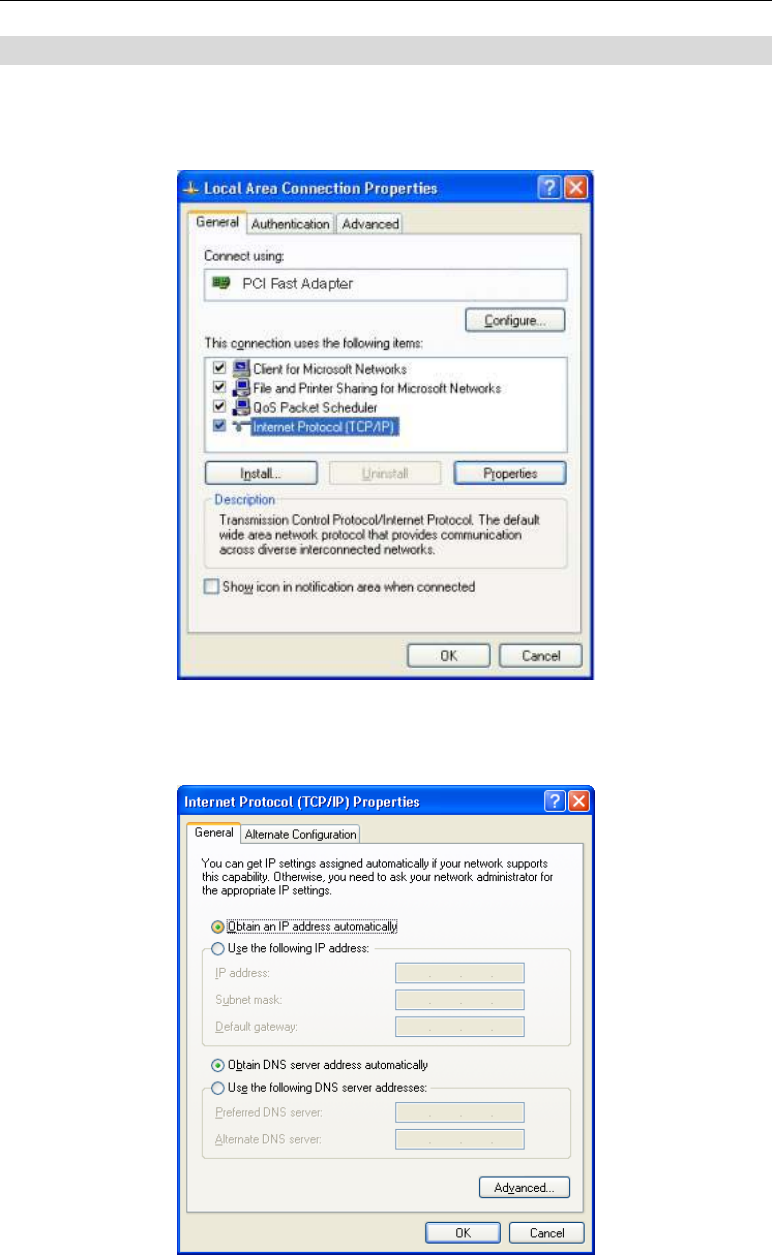
51
Checking TCP/IP Settings - Windows XP
1. Select Control Panel - Network Connection.
2. Right click the Local Area Connection and choose Properties. You should see a screen
like the following:
3. Select the TCP/IP protocol for your network card.
4. Click on the Properties button. You should then see a screen like the following.
5. Ensure your TCP/IP settings are correct.

52
Using DHCP
To use DHCP, select the radio button Obtain an IP Address automatically. This is the default
Windows setting. Using this is recommended. By default, the Wireless ADSL Modem Router
will act as a DHCP Server.
Restart your PC to ensure it obtains an IP Address from the Wireless ADSL Modem Router.
Using a fixed IP Address ("Use the following IP Address")
If your PC is already configured, check with your network administrator before making the
following changes.
• In the Default gateway field, enter the Wireless ADSL Modem Router's IP address and
click OK. Your LAN administrator can advise you of the IP Address they assigned to the
Wireless ADSL Modem Router.
• If the DNS Server fields are empty, select Use the following DNS server addresses, and
enter the DNS address or addresses provided by your ISP, then click OK.
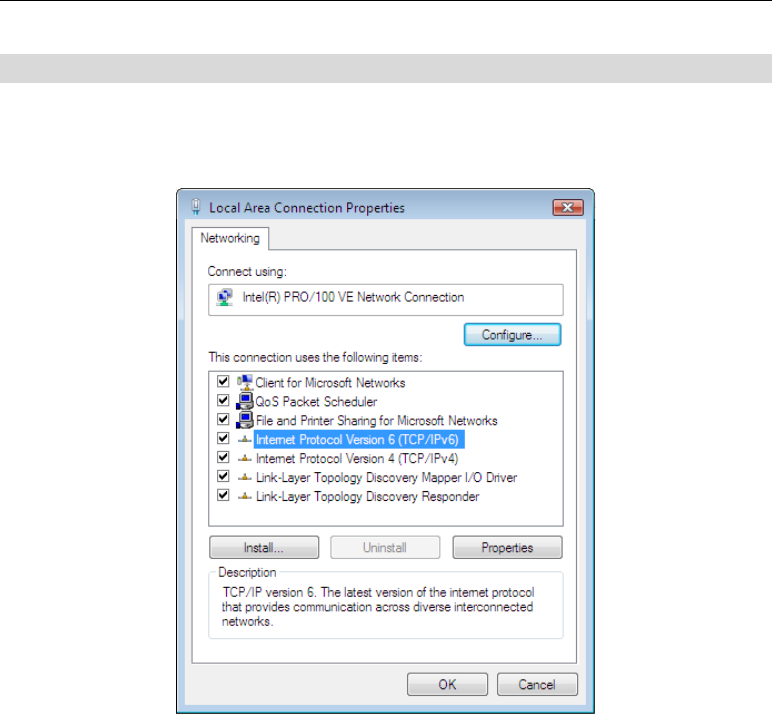
53
Checking TCP/IP Settings - Windows Vista
6. Select Control Panel - Network Connections.
7. Right click the Local Area Connection Status and choose Properties. Click Continue to
the User Account Control dialog box, then you should see a screen like the following:
8. Select the TCP/IP protocol for your network card.
9.
10. Click on the Properties button. You should then see a screen like the following.
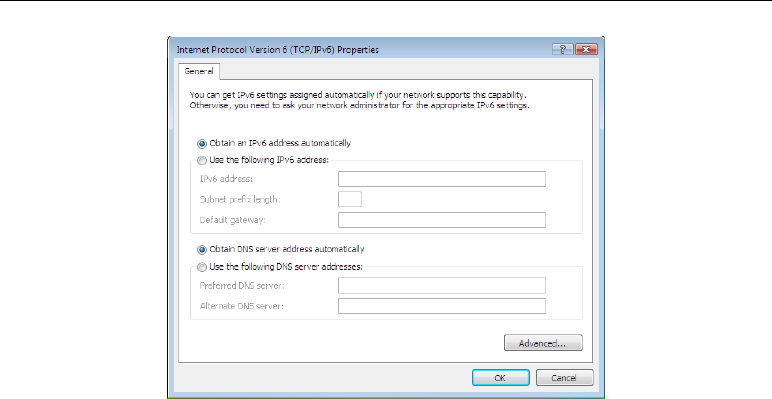
54
11. Ensure your TCP/IP settings are correct.
Using DHCP
To use DHCP, select the radio button Obtain an IP Address automatically. This is the default
Windows setting. To work correctly, you need a DHCP server on your LAN.
Using a fixed IP Address ("Use the following IP Address")
If your PC is already configured for a fixed (specified) IP address, no changes are required.
(The Administrator should configure the Wireless Access Point with a fixed IP address from
the same address range used on the PCs.)

55
Internet Access
To configure your PCs to use the Wireless ADSL Modem Router for Internet access:
• Ensure that the DSL modem, Cable modem, or other permanent connection is functional.
• Use the following procedure to configure your Browser to access the Internet via the LAN,
rather than by a Dial-up connection.
For Windows 2000
1. Select Start Menu - Settings - Control Panel - Internet Options.
2. Select the Connection tab, and click the Setup button.
3. Select "I want to set up my Internet connection manually, or I want to connect through a
local area network (LAN)" and click Next.
4. Select "I connect through a local area network (LAN)" and click Next.
5. Ensure all of the boxes on the following Local area network Internet Configuration screen
are unchecked.
6. Check the "No" option when prompted "Do you want to set up an Internet mail account
now?".
7. Click Finish to close the Internet Connection Wizard.
Setup is now completed.
For Windows XP
1. Select Start Menu - Control Panel - Network and Internet Connections.
2. Select Set up or change your Internet Connection.
3. Select the Connection tab, and click the Setup button.
4. Cancel the pop-up "Location Information" screen.
5. Click Next on the "New Connection Wizard" screen.
6. Select "Connect to the Internet" and click Next.
7. Select "Set up my connection manually" and click Next.
8. Check "Connect using a broadband connection that is always on" and click Next.
9. Click Finish to close the New Connection Wizard.
Setup is now completed.
For Windows Vista
You might already be connected to the Internet if your PC is connected to a local area network.
Open your web browser and try accessing a website to find out.
1. Select Start - Control Panel - Network and Internet.
2. Select Network and Sharing Center.
3. Select Set up a connection or network
4. Select Connect to the Internet.
5. Select the desired method to fit your environment.
Accessing AOL
To access AOL (America On Line) through the Wireless ADSL Modem Router, the AOL for
Windows software must be configured to use TCP/IP network access, rather than a dial-up
connection. The configuration process is as follows:

56
• Start the AOL for Windows communication software. Ensure that it is Version 2.5, 3.0 or
later. This procedure will not work with earlier versions.
• Click the Setup button.
• Select Create Location, and change the location name from "New Locality" to "Wireless
ADSL Modem Router".
• Click Edit Location. Select TCP/IP for the Network field. (Leave the Phone Number
blank.)
• Click Save, then OK.
Configuration is now complete.
• Before clicking "Sign On", always ensure that you are using the "Wireless ADSL Modem
Router" location.

57
Macintosh Clients
From your Macintosh, you can access the Internet via the Wireless ADSL Modem Router. The
procedure is as follows.
1. Open the TCP/IP Control Panel.
2. Select Ethernet from the Connect via pop-up menu.
3. Select Using DHCP Server from the Configure pop-up menu. The DHCP Client ID field
can be left blank.
4. Close the TCP/IP panel, saving your settings.
Note:
If using manually assigned IP addresses instead of DHCP, the required changes are:
• Set the Router Address field to the Wireless ADSL Modem Router's IP Address.
• Ensure your DNS settings are correct.
Linux Clients
To access the Internet via the Wireless ADSL Modem Router, it is only necessary to set the
Wireless ADSL Modem Router as the "Gateway".
Ensure you are logged in as "root" before attempting any changes.
Fixed IP Address
By default, most Unix installations use a fixed IP Address. If you wish to continue using a
fixed IP Address, make the following changes to your configuration.
• Set your "Default Gateway" to the IP Address of the Wireless ADSL Modem Router.
• Ensure your DNS (Name server) settings are correct.
To act as a DHCP Client (recommended)
The procedure below may vary according to your version of Linux and X -windows shell.
1. Start your X Windows client.
2. Select Control Panel - Network
3. Select the "Interface" entry for your Network card. Normally, this will be called "eth0".
4. Click the Edit button, set the "protocol" to "DHCP", and save this data.
5. To apply your changes
• Use the "Deactivate" and "Activate" buttons, if available.
• OR, restart your system.
Other Unix Systems
To access the Internet via the Wireless ADSL Modem Router:
• Ensure the "Gateway" field for your network card is set to the IP Address of the Wireless
ADSL Modem Router.
• Ensure your DNS (Name Server) settings are correct.

58
Wireless Station Configuration
This section applies to all Wireless stations wishing to use the Wireless ADSL Modem Rou-
ter's Access Point, regardless of the operating system which is used on the client.
To use the Wireless Access Point in the Wireless ADSL Modem Router, each Wireless Station
must have compatible settings, as follows:
Mode The mode must be set to Infrastructure (rather than Ad-hoc)
Access points only operate in Infrastructure mode.
SSID (ESSID) This must match the value used on the Wireless ADSL Modem Router.
Note! The SSID is case sensitive.
Wireless
Security By default, Wireless security on the Wireless ADSL Modem Router is
disabled.
• If Wireless security remains disabled on the Wireless ADSL Modem
Router, all stations must have wireless security disabled.
• If Wireless security is enabled on the Wireless Router (either WEP
or WPA-PSK), each station must use the same settings as the Wire-
less ADLS Router.
Wireless Configuration on Windows XP
If using Windows XP to configure the Wireless interface on your PC, the configuration proce-
dure is as follows:
1. Open the Network Connections folder. (Start - Settings - Network Connections).
2. Right-click the Wireless Network Connection, check that it is enabled (menu option says
Disable, rather than Enable) and then select View Available Wireless Networks.
3. You will then see a list of wireless networks.
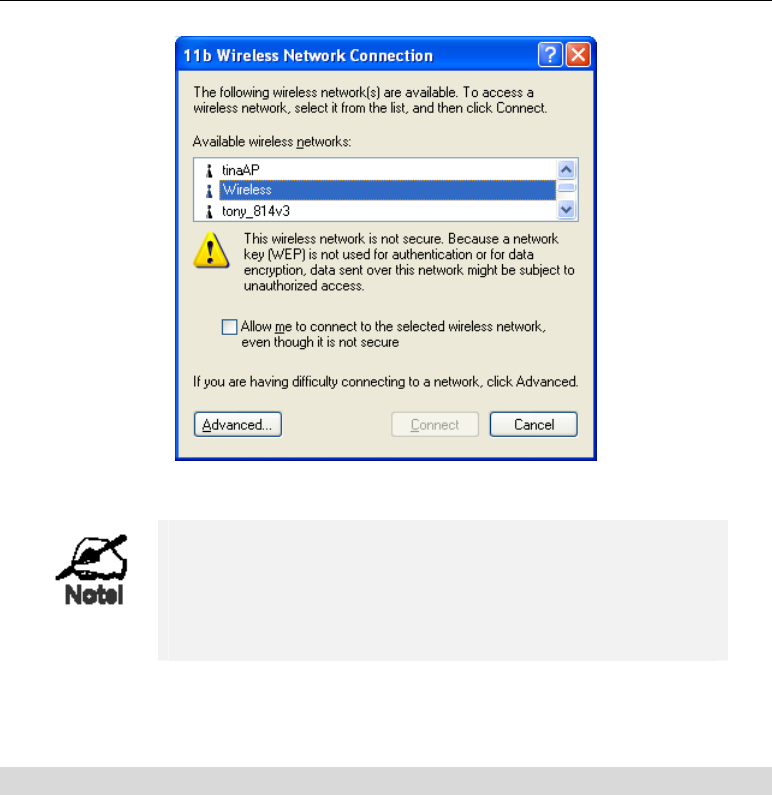
59
If the "Broadcast SSID" setting on the Wireless ADSL
Modem Router has been disabled, its SSID will NOT be
listed.
See the following section "If the SSID is not listed" for
details of dealing with this situation.
4. The next step depends on whether or not Wireless security has been enabled on the Wire-
less ADSL Modem Router.
If Wireless Security is Disabled
If Wireless security on the Wireless ADSL Modem Router is disabled, Windows will warn you
that the Wireless network is not secure.
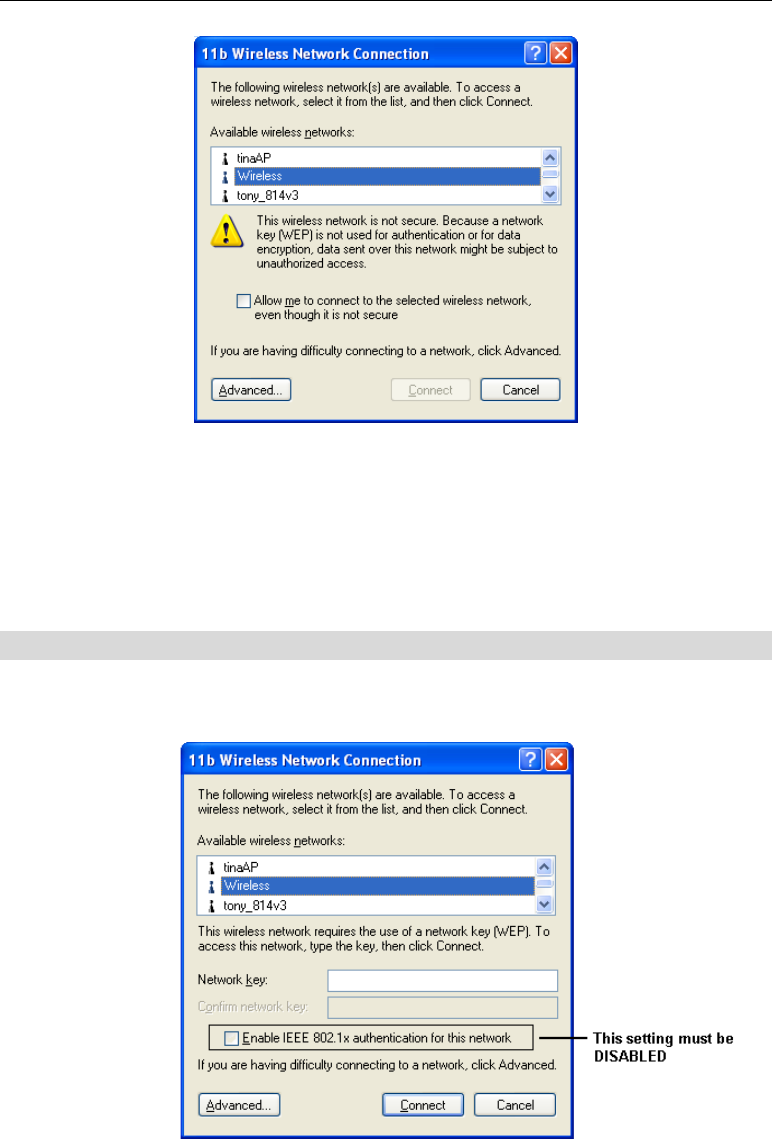
60
To connect:
• Check the checkbox Allow me to connect to the selected wireless network, even though it
is not secure.
• The Connect button will then be available. Click the Connect button, and wait a few
seconds for the connection to be established.
If using WEP Data Encryption
If WEP data encryption has been enabled on the Wireless ADSL Modem Router, Windows
will detect this, and show a screen like the following.
To connect:
• Enter the WEP key, as set on the Wireless ADSL Modem Router, in the Network Key field.
• Re-enter the WEP key into the Confirm Network key field.
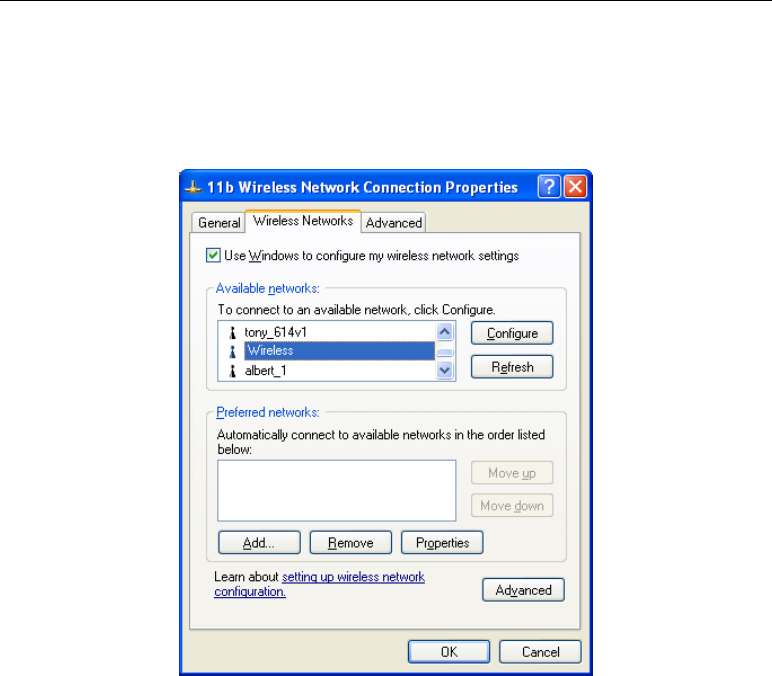
61
• Disable the checkbox Enable IEEE 802.1x authentication for this network.
• Click the Connect button.
If this fails, click the Advanced button, to see a screen like the following:
Select the SSID for the Wireless ADSL Modem Router, and click Configure, to see a screen
like the following:
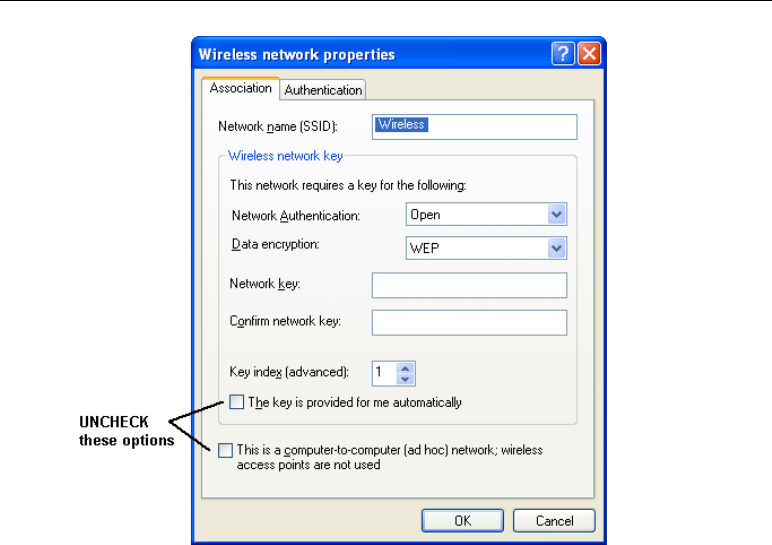
62
Configure this screen as follows:
• Set Network Authentication to match the Wireless ADSL Modem Router. (If the setting on
the Wireless ADSL Modem Router is "Auto", then either Open or Shared can be used.)
• For Data Encryption, select WEP.
• For the Network key and Confirm network key, enter the default key value used on the
Wireless ADSL Modem Router. (Windows will determine if 64bit or 128bit encryption is
used.)
• The Key index must match the default key index on the Wireless ADSL Modem Router.
The default value is 1.
• Ensure the options The key is provided for me automatically and This is a computer-to-
computer (ad hoc) network are unchecked.
• Click OK to save and close this dialog.
• This wireless network will now be listed in Preferred Networks on the screen below.
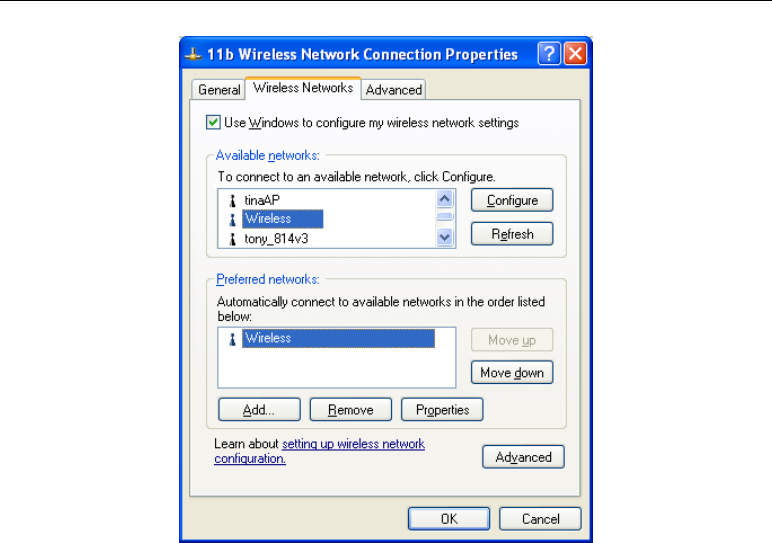
63
Click OK to establish a connection to the Wireless ADSL Modem Router.
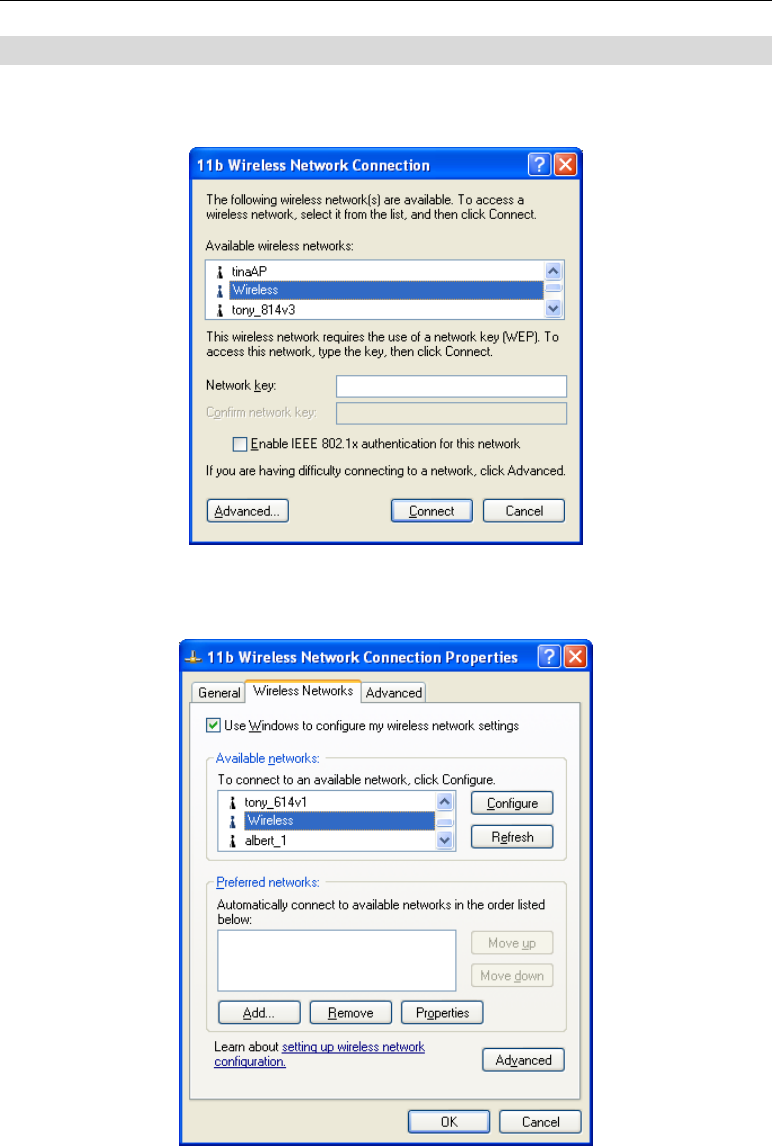
64
If using WPA-PSK Data Encryption
If WPA-PSK data encryption has been enabled on the Wireless ADSL Modem Router, it does
not matter which network is selected on the screen below. Just click the Advanced button.
You will then see a screen like the example below.
Select the SSID for the Wireless ADSL Modem Router, and click Configure, to see a screen
like the following:
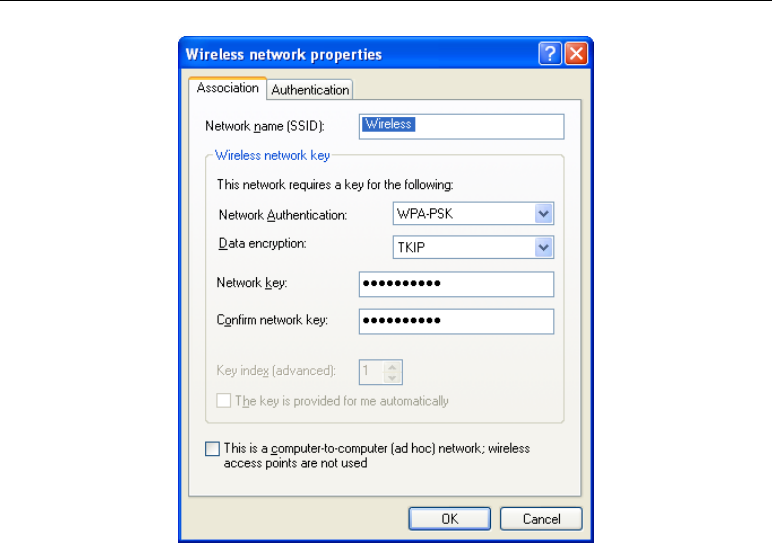
65
Configure this screen as follows:
• Set Network Authentication to WPA-PSK.
• For Data Encryption, select TKIP.
• For the Network key and Confirm network key, enter the network key (PSK) used on the
Wireless ADSL Modem Router.
• Ensure the option This is a computer-to-computer (ad hoc) network is unchecked.
• Click OK to save and close this dialog.
• This wireless network will now be listed in Preferred Networks on the screen below.
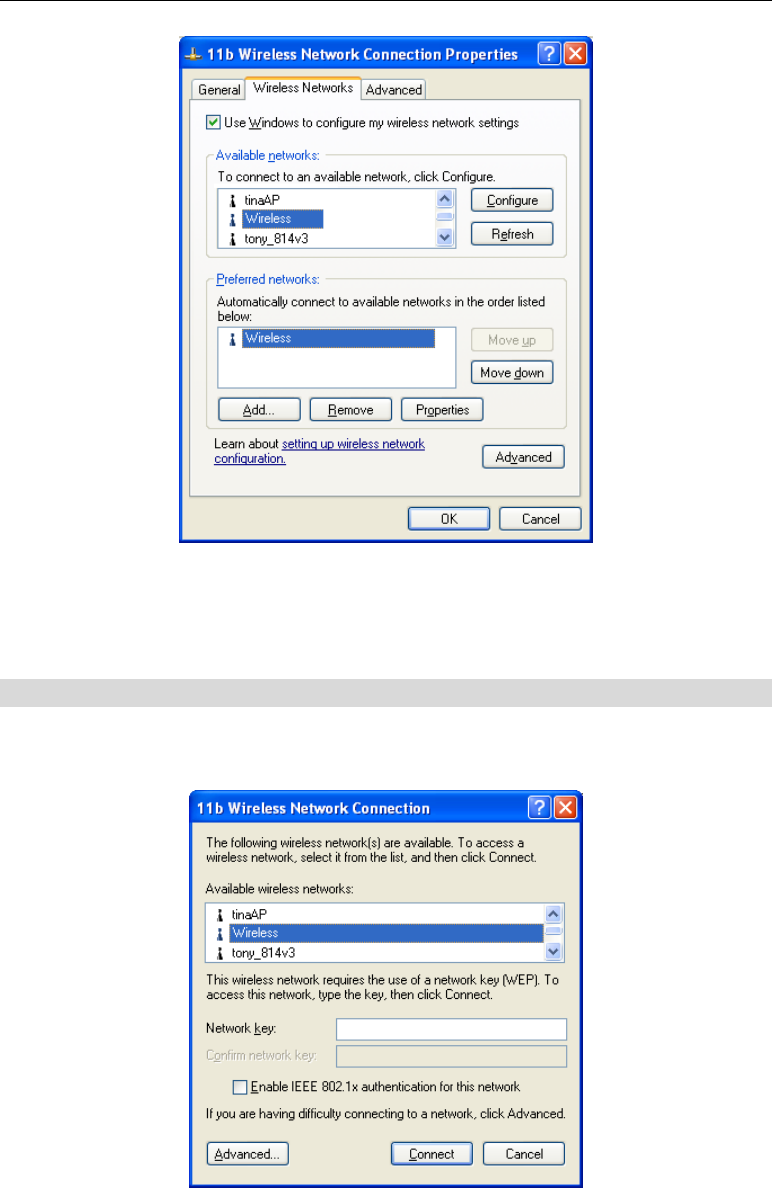
66
Click OK to establish a connection to the Wireless ADSL Modem Router.
If the SSID is not listed
If the "Broadcast SSID" setting on the Wireless ADSL Modem Router has been disabled, its
SSID will NOT be listed on the screen below.
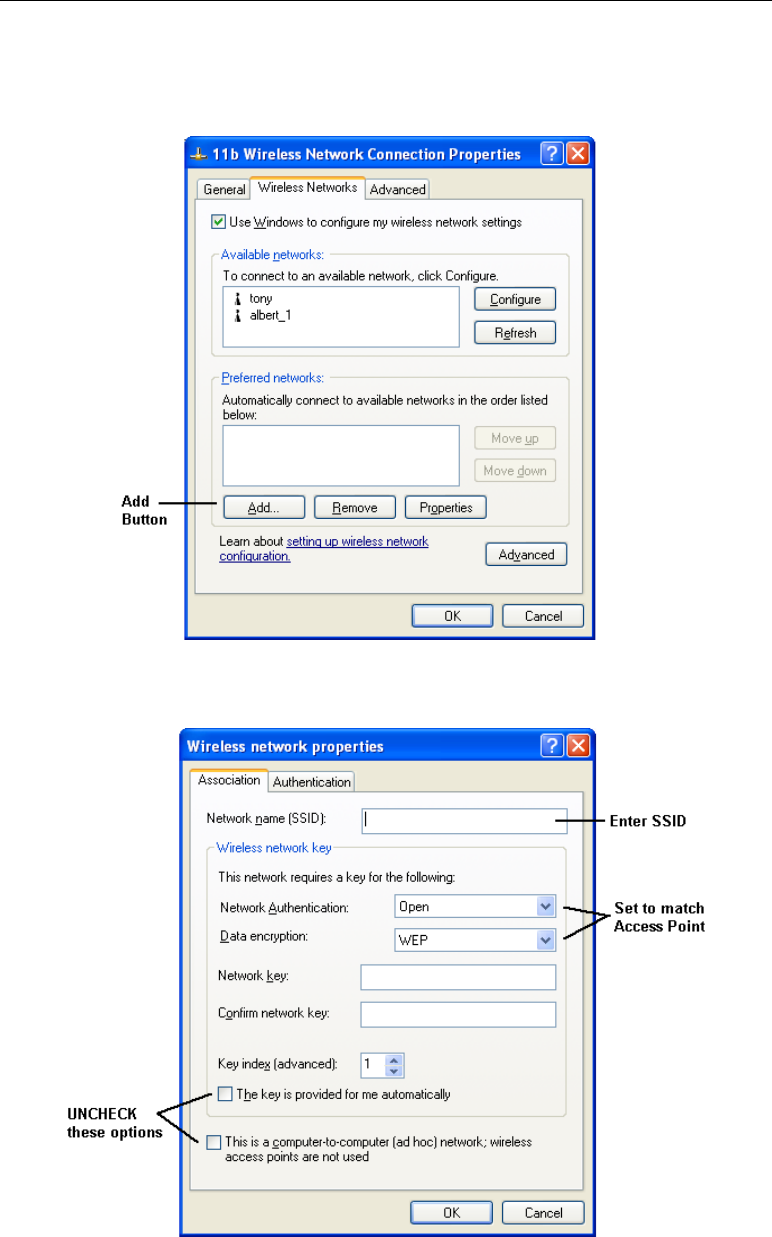
67
In this situation, you need to obtain the SSID from your network administrator, then follow
this procedure:
1. Click the Advanced button to see a screen like the example below.
2. Click the Add button. You will see a screen like the example below.
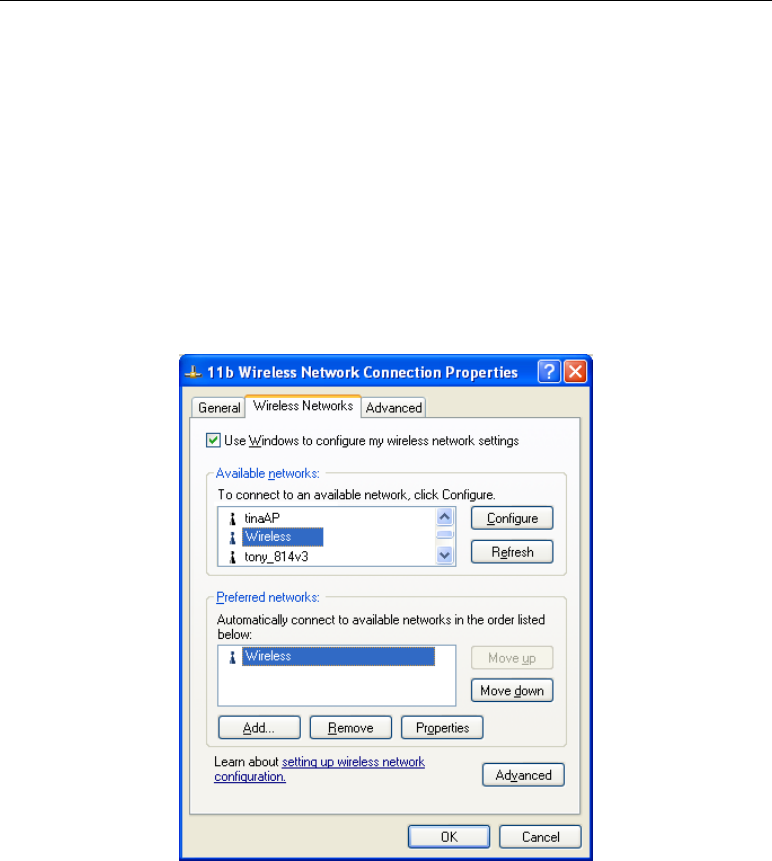
68
3. Configure this screen as follows:
• Enter the correct SSID, as used on the Wireless ADSL Modem Router. Remember the
SSID is case-sensitive, so be sure to match the case, not just the spelling.
• Set Network Authentication and Data Encryption to match the Wireless ADSL Modem
Router.
• If using data encryption (WEP or WPA-PSK), enter the key used on the Wireless ADSL
Modem Router. See the preceding sections for details of WEP and WPA-PSK.
• Uncheck the options The key is provided for me automatically and This is a computer-to-
computer (ad hoc) network.
• Click OK to save and exit.
4. This wireless network will then be listed in Preferred Networks on the screen below.
5. Click OK to establish a connection to the Wireless ADSL Modem Router.

69
Chapter 5
Advanced Features
This Chapter explains when and how to use the Wireless ADSL Modem Rou-
ter's "Advanced" Features.
Overview
The following advanced features are provided:
• Internet:
• DMZ
• URL filter
• Access Control
• Dynamic DNS
• Options
• Schedule
• Port Trigger
• Port Foward
• Port Range Forward
• QoS
Internet
This screen provides access to the DMZ, Special Applications and URL Filter features.
DMZ
This feature, if enabled, allows the DMZ computer on your LAN to be exposed to all users on
the Internet.
• This allows almost any application to be used on the "DMZ PC".
• The "DMZ PC" will receive all "Unknown" connections and data.
5
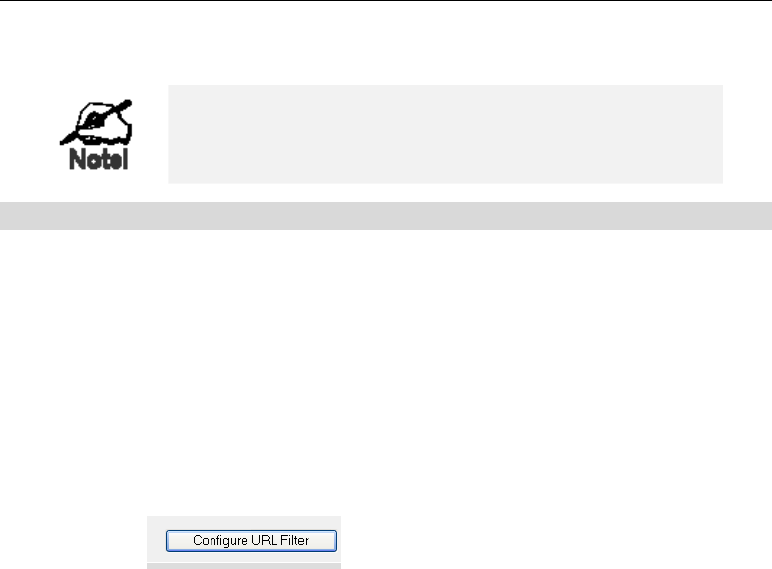
70
• If the DMZ feature is enabled, you must select the PC to be used as the "DMZ PC".
The "DMZ PC" is effectively outside the Firewall, mak-
ing it more vulnerable to attacks. For this reason, you
should only enable the DMZ feature when required.
URL Filter
If you want to limit access on certain sites on the Internet, you can use this feature. The URL
filter will check each Web site access. If the address, or part of the address, is included in the
block site list, access will be denied.
On the Advanced Internet screen, select the desired setting:
• Disable - disable URL filter feature.
• Block Always - allow blocking all of the time, independent of the Schedule page.
• Block By Schedule - block according to the settings on the Schedule page.
Click the Configure URL Filter button to open the URL Filter screen, allowing you to create
or modify the filter strings which determine which sites will be blocked.
The URL Filter screen is displayed when the Configure URL Filter button on the Advanced
Internet screen is clicked. Enter the word or domain name that you would like to be blocked,
then click the Add button. To delete a word or domain name, select the string then click the
Delete button. To remove all URL filter on the list, click Delete All button.
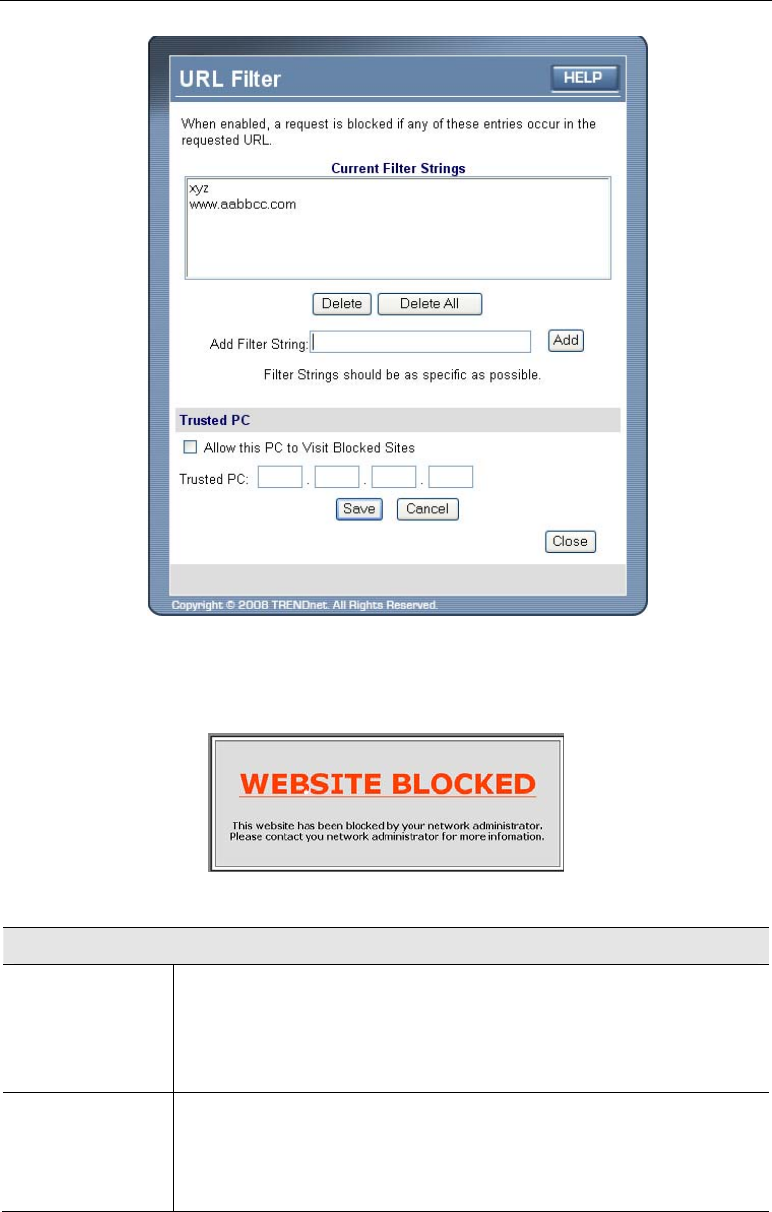
71
The unauthorized access to the block URL will display the following message.
URL Filter Screen
Current Filter Strings
Current Filter
Strings The list contains the current list of items to block.
• To add to the list, use the "Add" option below.
• To delete an entry, select it and click Delete button.
• To delete all entries, click the Delete All button.
Add Filter String To add to the current list, type the word or domain name you want to
block into the field provided, then click the Add button.
Filter strings should be as specific as possible. Otherwise, you may
block access to many more sites than intended.

72
Trusted PC
Allow this PC
to.. Enable this to allow one computer to have unrestricted access to the
Internet. For this PC, the URL filter will be ignored.
If enabled, you must select the PC to be the trusted PC.
Trusted PC Enter the PC to be the Trusted PC.
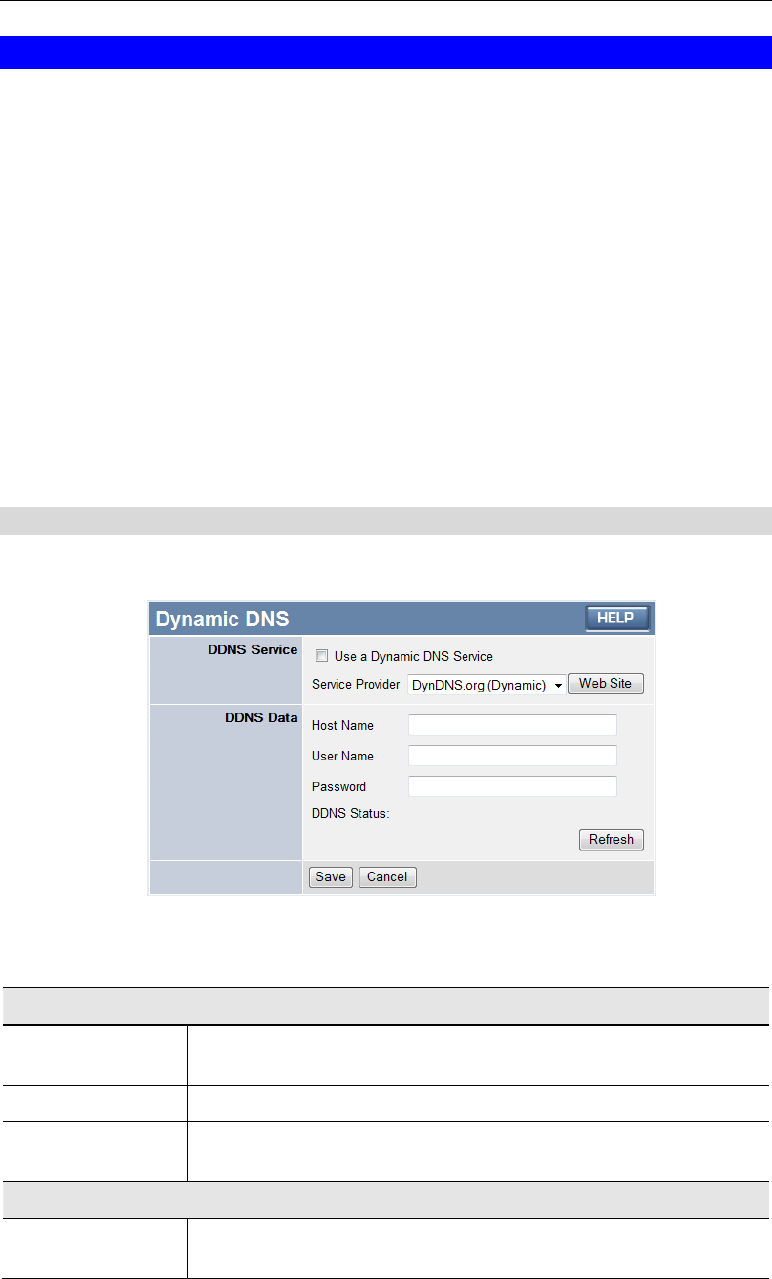
73
Dynamic DNS (Domain Name Server)
This free service is very useful when combined with the Virtual Server feature. It allows
Internet users to connect to your Virtual Servers using a URL, rather than an IP Address.
This also solves the problem of having a dynamic IP address. With a dynamic IP address, your
IP address may change whenever you connect, which makes it difficult to connect to you.
DDNS Services work as follows:
1. You must register for the service at one of the listed DDNS Service providers.
2. After registration, use the Service provider's normal procedure to obtain your desired
Domain name.
3. Enter your DDNS data on the Wireless ADSL Modem Router's DDNS screen, and enable
the DDNS feature.
4. The Wireless ADSL Modem Router will then automatically ensure that your current IP
Address is recorded at the DDNS service provider's Domain Name Server.
5. From the Internet, users will be able to connect to your Virtual Servers (or DMZ PC)
using your Domain name, as shown on this screen.
Dynamic DNS Screen
Select Advanced on the main menu, then Dynamic DNS, to see a screen like the following:
Dynamic DNS Screen
DDNS Service
Use a Dynamic
DNS Service Use this to enable or disable the DDNS feature as required.
Service Provider Select the desired DDNS Service provider.
Web Site Click this button to open a new window and connect to the Web site
of the selected DDNS service provider.
DDNS Data
Host Name Enter the domain name allocated to you by the DDNS Service. If you
have more than one name, enter the name you wish to use.

74
User Name Enter your Username for the DDNS Service. (TZO.com uses your E-
mail address.)
Password Enter your current password for the DDNS Service. (TZO.com calls
this a key.)
DDNS Status • This message is returned by the DDNS Server.
• Normally, this message should be "Update successful"
• If the message indicates some problem, you need to connect to
the DDNS Service provider and correct this problem.
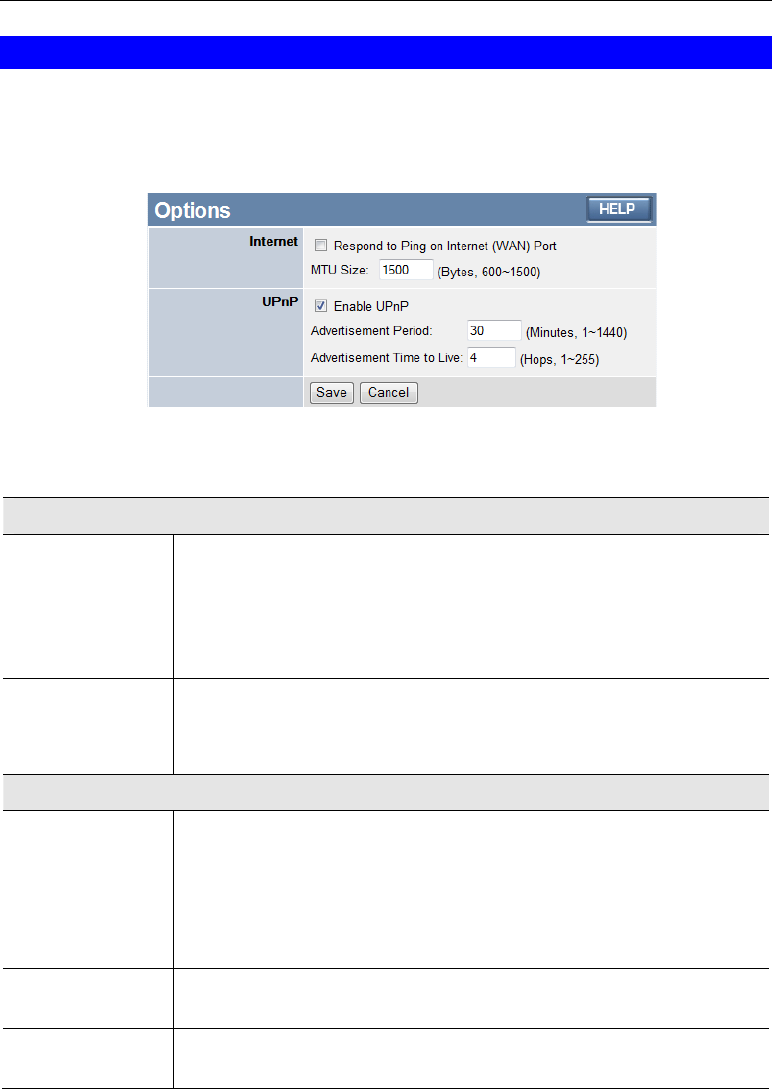
75
Options
This screen allows advanced users to enter or change a number of settings. For normal opera-
tion, there is no need to use this screen or change any settings.
An example Options screen is shown below.
Options Screen
Internet
Respond to Ping • If checked, the Wireless Router will respond to Ping (ICMP)
packets received from the Internet.
• If not checked, Ping (ICMP) packets from the Internet will be
ignored. Disabling this option provides a slight increase in securi-
ty.
MTU Size Enter a value between 600 and 1500.
Note: MTU (Maximum Transmission Unit) size should only be
changed if advised to do so by Technical Support.
UPnP
Enable UPnP • UPnP (Universal Plug and Play) allows automatic discovery and
configuration of equipment attached to your LAN. UPnP is sup-
ported by Windows ME, XP, or later.
• If Enabled, this device will be visible via UPnP.
• If Disabled, this device will not be visible via UPnP.
Advertisement
Period Enter the desired value, in minutes. The valid range is from 1 to 1440.
Advertisement
Time to Live Enter the desired value, in hops. The valid range is from 1 to 255.
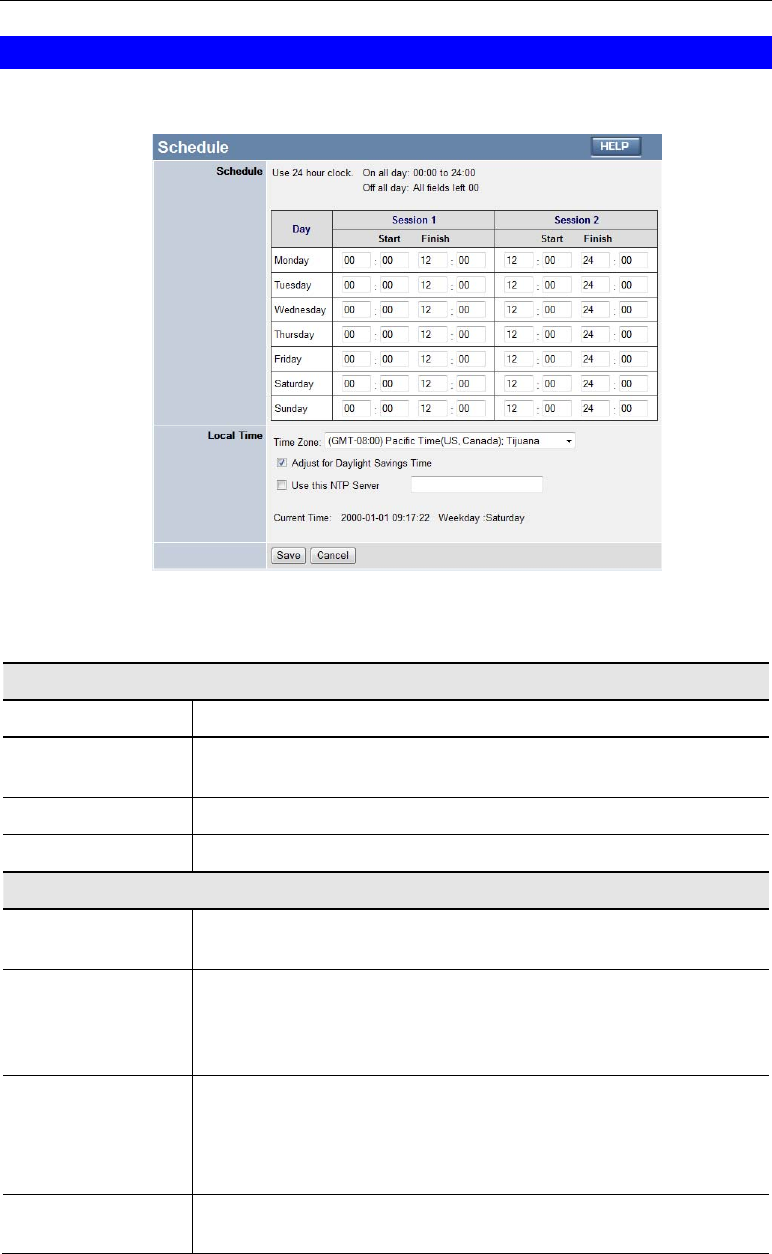
76
Schedule
This Schedule can be used for the Firewall Rules and the URL filter.
Schedule Screen
Schedule
Day Each day of the week can be scheduled independently.
Session 1
Session 2 Two (2) separate sessions or periods can be defined. Session 2 can
be left blank if not required.
Start Time Enter the start using a 24 hr clock.
Finish Time Enter the finish time using a 24 hr clock.
Local Time
Time Zone In order to display your local time correctly, you must select your
"Time Zone" from the list.
Adjust for Day-
light Savings Time If your region uses Daylight Savings Time, you must manually
check "Adjust for Daylight Savings Time" at the beginning of the
adjustment period, and uncheck it at the end of the Daylight Savings
period.
Use this NTP
Server If you prefer to use a particular NTP server as the primary NTP
server, check the checkbox "Use this NTP Server" and enter the
Server's IP address in the fields provided.
If this setting is not enabled, the default NTP Servers are used.
Current Time This displays the current time on the Wireless ADSL Modem Rou-
ter, at the time the page is loaded.
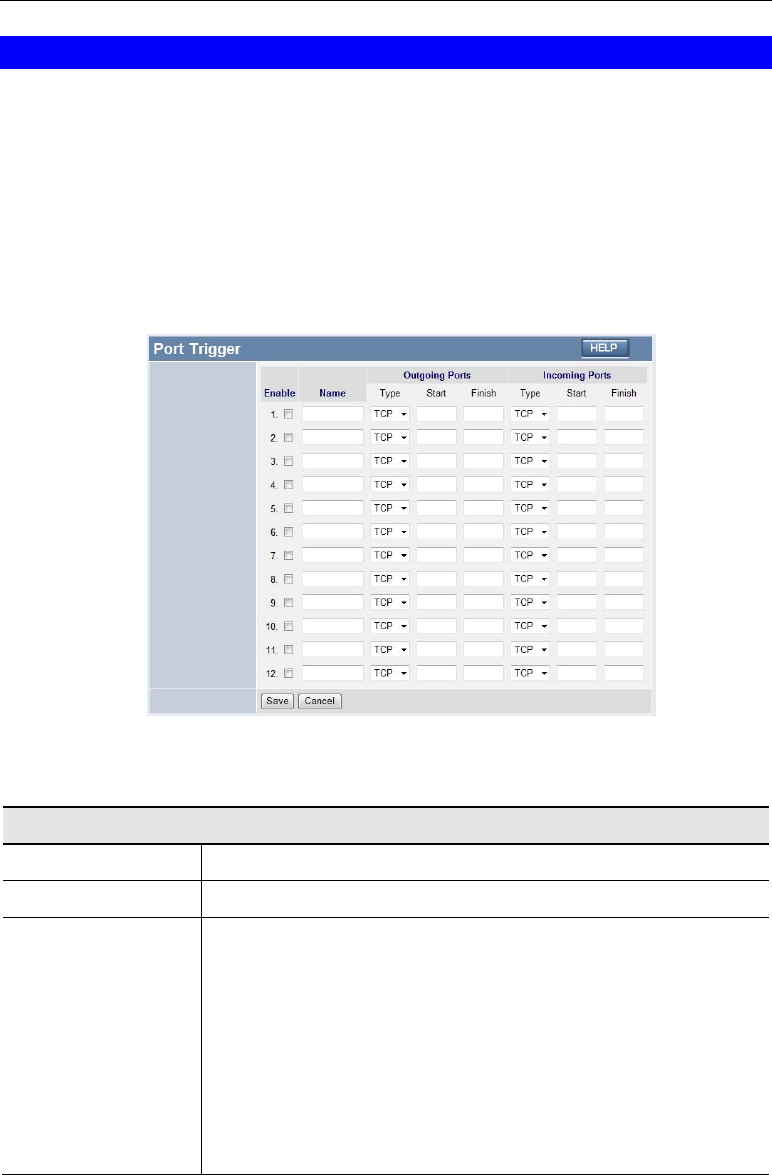
77
Port Trigger
If you use Internet applications which use non-standard connections or port numbers, you may
find that they do not function correctly because they are blocked by the Wireless ADSL
Modem Router's firewall. In this case, you can define the application as a "Port Trigger".
The Port Trigger screen can be reached by clicking the Port Trigger on the screen.
You can then define your Port Trigger. You will need detailed information about the applica-
tion; this is normally available from the supplier of the application.
Also, note that the terms "Incoming" and "Outgoing" on this screen refer to traffic from the
client (PC) viewpoint
Port Trigger Screen
Port Trigger
Enable Use this to Enable or Disable this Special Application as required.
Name Enter a descriptive name to identify this Special Application.
Outgoing
Ports
• Type - Select the protocol (TCP or UDP) used when you send
data to the remote system or service.
• Start - Enter the beginning of the range of port numbers used
by the application server, for data you send to it. If the applica-
tion uses a single port number, enter it in both the "Start" and
"Finish" fields.
• Finish - Enter the end of the range of port numbers used by the
application server, for data you send to it. If the application
uses a single port number, enter it in both the "Start" and
"Finish" fields.

78
Incoming
Ports
• Type - Select the protocol (TCP or UDP) used when you
receive data from the special application or service. (Note:
Some applications use different protocols for outgoing and in-
coming data).
• Start - Enter the beginning of the range of port numbers used
by the application server, for data you receive. If the applica-
tion uses a single port number, enter it in both the "Start" and
"Finish" fields.
• Finish - Enter the end of the range of port numbers used by the
application server, for data you receive.
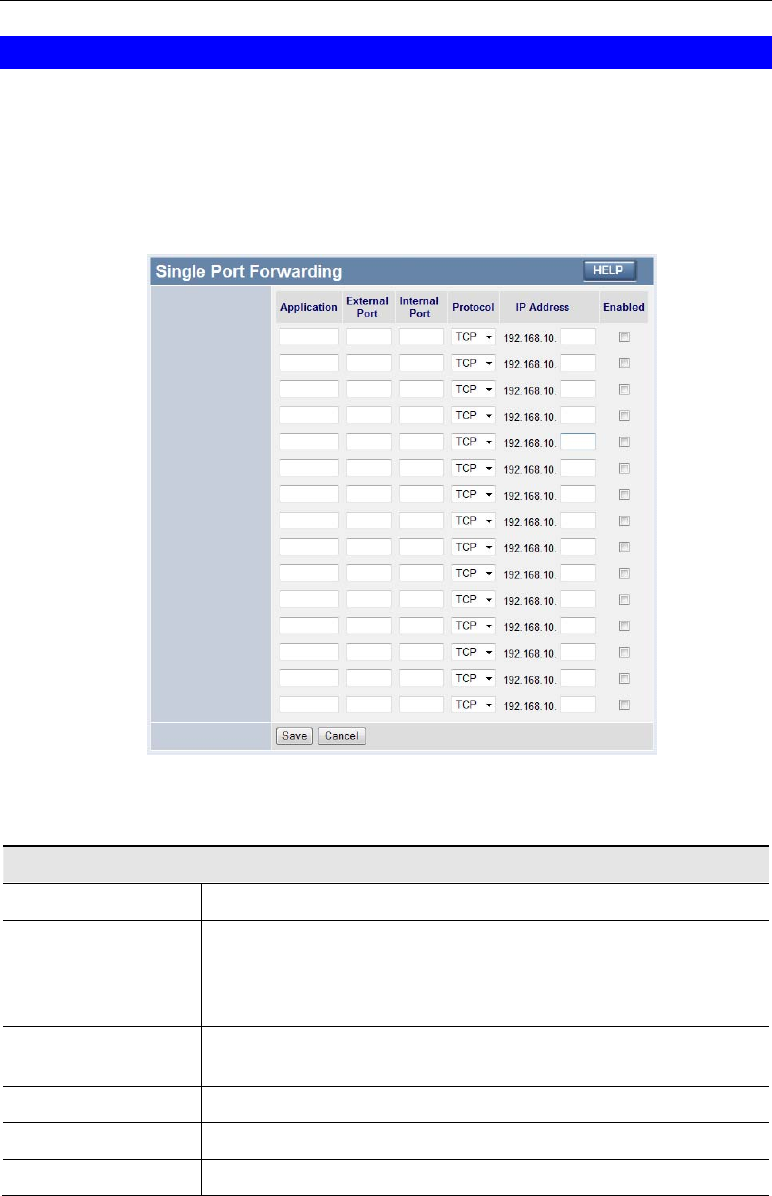
79
Port Forward
This feature allows you to make Servers on your LAN accessible to Internet users. Normally,
Internet users would not be able to access a server on your LAN because:
• Your Server does not have a valid external IP Address.
• Attempts to connect to devices on your LAN are blocked by the firewall in this device.
Port Forwarding Screen
Port Forwarding
Application Enter the desired application type.
External Port Traffic from the Internet using this port number will be sent to the
Server. This is normally the same as the Internal Port Number. If it
is different, this device will perform a "mapping" or "translation"
function, allowing the server to use a different port to the clients.
Internal Port Enter the port numbers which the Server software is configured to
use.
Protocol Select the protocol (TCP or UDP) used by the Server.
IP Address Enter the desired IP address.
Enabled Use this to Enable or Disable support for this Server, as required.
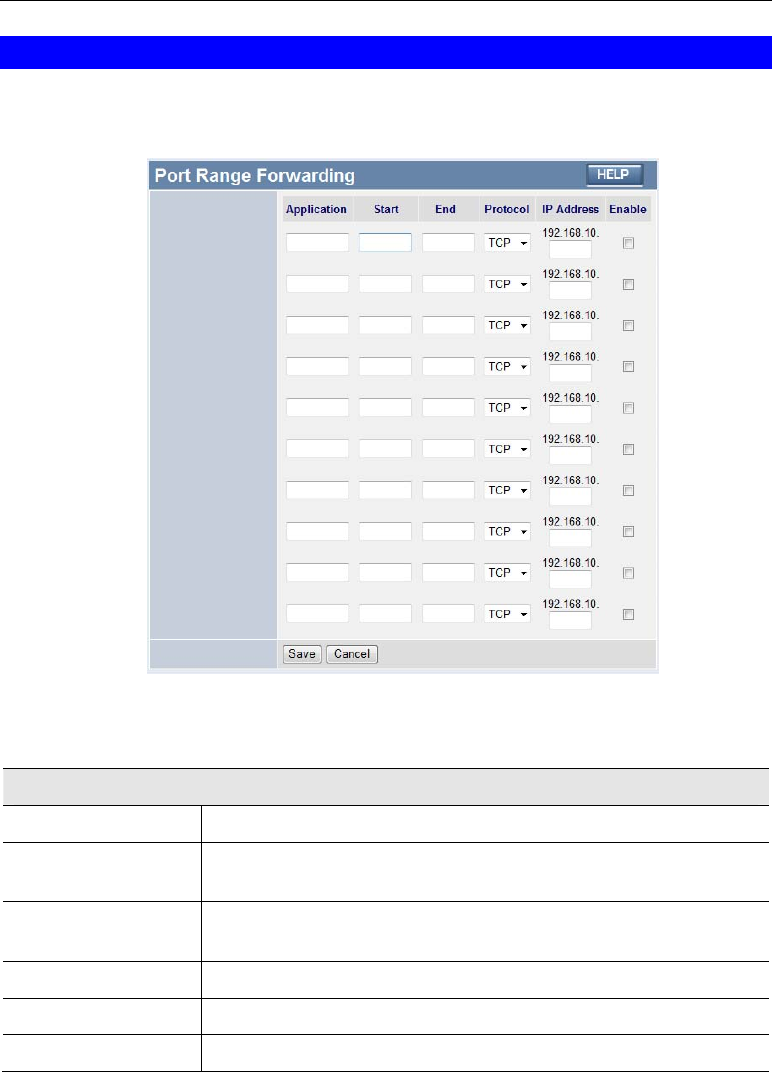
80
Port Range Forward
This feature allows you to make Servers on your LAN accessible to Internet users. Normally,
Internet users would not be able to access a server on your LAN because:
Port Range Forwarding Screen
Port Range Forwarding
Application Enter the desired application type.
Start Enter the beginning of the range of port numbers used by the
application server.
End Enter the end of the range of port numbers used by the application
server.
Protocol Select the protocol (TCP, UDP or Both) used by the Server.
IP Address Enter the desired IP address.
Enable Use this to Enable or Disable support for this Server, as required.
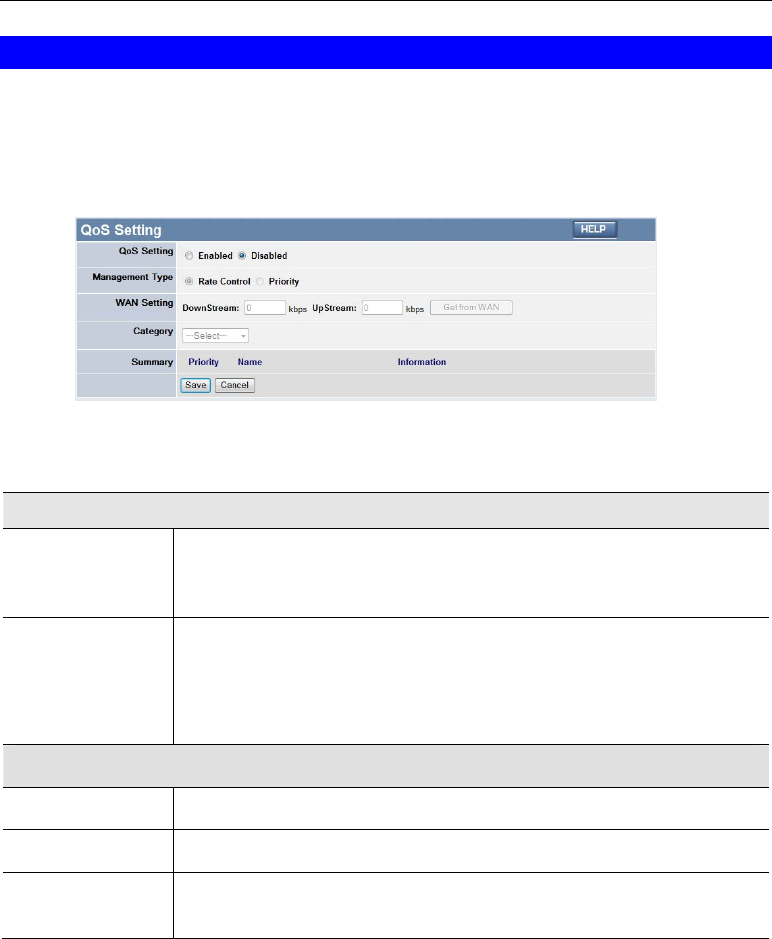
81
QoS
The QoS (Quality of Service) feature allows you specify priorities for different traffic. Lower
priority traffic will be slowed down to allow greater throughput or less delay for high priority
traffic.
An example QoS screen is shown below.
QoS Screen
QoS Setting
QoS Setting To disable QoS (Quality of Service), keep the default setting, Disable.
To enable QoS (Quality of Service), click Enable and follow these
instructions.
Management
Type There are 2 options:
• Rate Control - The QoS will be managed by the size of the band-
width.
• Priority - The QoS will be managed by the priority.
WAN Setting
DownStream Enter the desired value for the DownStream Connection.
UpStream Enter the desired value for the UpStream Connection.
Get from WAN Click this button to get the values for DownStream and UpStream from
WAN.

82
Category • Applications:
• Add a New Application (Once selected, please complete the
following setups.)
• Ip/Net: Enter the IP addresses.
• Rate: Enter the desired rate value.
• Priority: Select the desired option (High, Normal, Low)
• Direct: Select Upstream or Downstream as required.
• Self-Define
• Name. Enter a name for your device.
• Port Range: Enter the values for the desired port range.
• Protocol: Select the desired option.
• Ip/Net: Enter the IP addresses of your device.
• Rate: Enter the desired rate value.
• Priority: Select the option (High, Normal, Low) from the list.
• Direct: Select Upstream or Downstream as required.
Summary
Priority The priority of the application.
Name The Name of this Application or IP Address.
Information The general Information of this Application or IP Address.

83
Chapter 6
Advanced Administration
This Chapter explains the settings available via the "Administration" section
of the menu.
Overview
Normally, it is not necessary to use these screens, or change any settings. These screens and
settings are provided to deal with non-standard situations, or to provide additional options for
advanced users.
The available settings and features are:
PC Database This is the list of PCs shown when you select the "DMZ PC" or a
"Virtual Server". This database is maintained automatically, but
you can add and delete entries for PCs which use a Fixed (Static)
IP Address.
Config File Backup or restore the configuration file for the Wireless ADSL
Modem Router. This file contains all the configuration data.
Logs & E-mail View or clear all logs, set E-Mailing of log files and alerts.
Diagnostics Perform a Ping or DNS Lookup.
Remote Admin Allow settings to be changed from the Internet.
Routing Only required if your LAN has other Routers or Gateways.
Upgrade Firmware Upgrade the Firmware (software) installed in your Wireless
ADSL Modem Router.
6
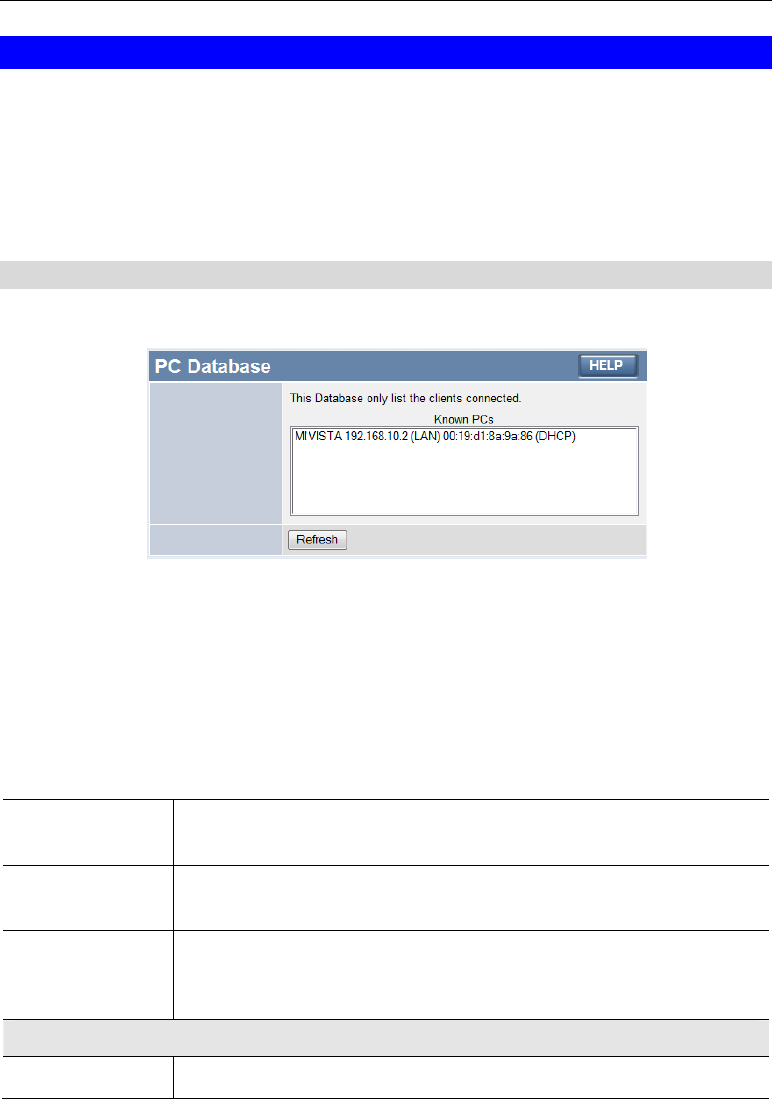
84
PC Database
The PC Database is used whenever you need to select a PC (e.g. for the "DMZ" PC).
• It eliminates the need to enter IP addresses.
• Also, you do not need to use fixed IP addresses on your LAN.
However, if you do use a fixed IP address on some devices on your LAN, you should enter
details of each such device into the PC database, using the PC Database screen.
PC Database Screen
An example PC Database screen is shown below.
• PCs which are "DHCP Clients" are automatically added to the database, and updated as
required.
• The Wireless ADSL Modem Router uses the "Hardware Address" to identify each PC, not
the name or IP address. The "Hardware Address" can only change if you change the PC's
network card or adapter.
PC Database Screen
Known PCs This lists all current entries. Data displayed is name (IP Address) type.
The "type" indicates whether the PC is connected to the LAN.
Name If adding a new PC to the list, enter its name here. It is best if this
matches the PC's "hostname".
IP Address Enter the IP Address of the PC. The PC will be sent a "ping" to deter-
mine its hardware address. If the PC is not available (not connected, or
not powered On) you will not be able to add it.
Buttons
Refresh Update the data on screen.
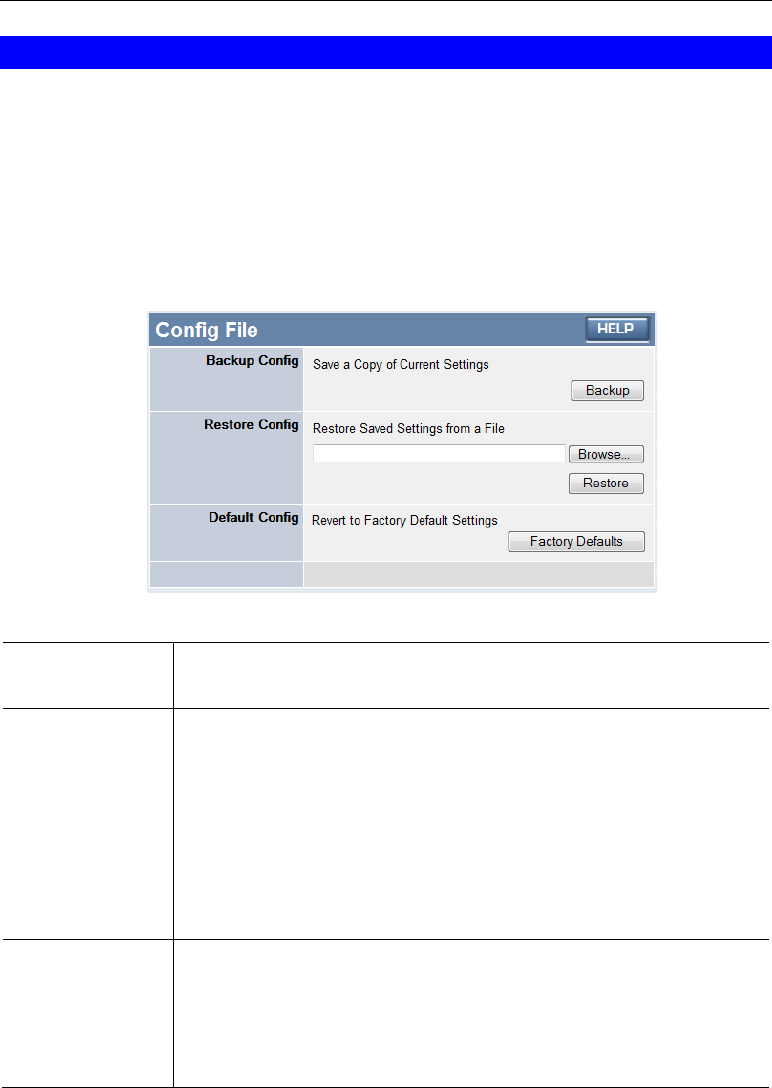
85
Config File
This feature allows you to download the current settings from the Wireless ADSL Modem
Router, and save them to a file on your PC.
You can restore a previously-downloaded configuration file to the Wireless ADSL Modem
Router, by uploading it to the Wireless ADSL Modem Router.
This screen also allows you to set the Wireless ADSL Modem Router back to its factory
default configuration. Any existing settings will be deleted.
An example Config File screen is shown below.
Config File Screen
Backup Config Use this to download a copy of the current configuration, and store the
file on your PC. Click Backup to start the download.
Restore Config This allows you to restore a previously-saved configuration file back to
the Wireless ADSL Modem Router.
Click Browse to select the configuration file, then click Restore to
upload the configuration file.
WARNING!
Uploading a configuration file will destroy (overwrite) ALL of the
existing settings.
Default Config Clicking the Factory Defaults button will reset the Wireless ADSL
Modem Router to its factory default settings.
WARNING!
This will delete ALL of the existing settings.
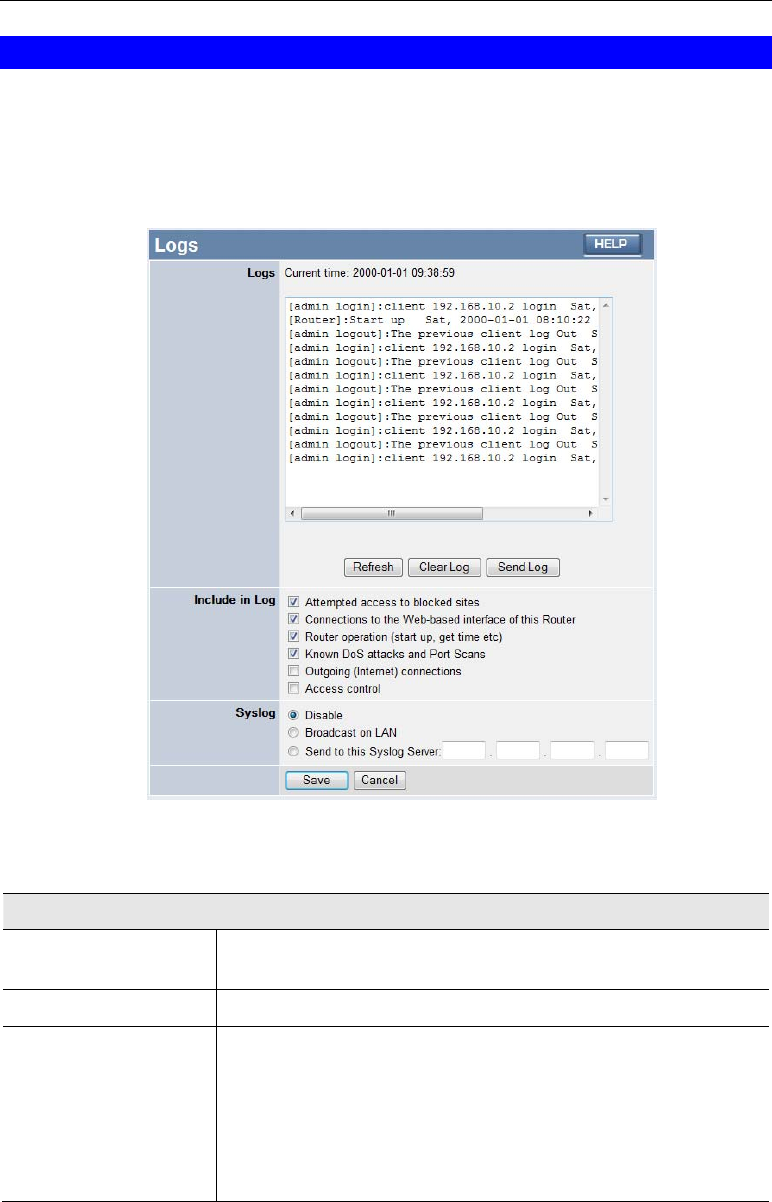
86
Logs
The Logs record various types of activity on the Wireless ADSL Modem Router. This data is
useful for troubleshooting, but enabling all logs will generate a large amount of data and
adversely affect performance.
Since only a limited amount of log data can be stored in the Wireless ADSL Modem Router,
log data can also be E-mailed to your PC. Use the E-mail screen to configure this feature.
Logs Screen
Logs
Current Time The current time on the Wireless ADSL Modem Router is dis-
played.
Log Data Current log data is displayed in this panel.
Buttons There are three (3) buttons
• Refresh - Update the log data.
• Clear Log - Clear the log, and restart it. This makes new
messages easier to read.
• Send Log - E-mail the log immediately. This is only func-
tional if the E-mail screen has been configured.

87
Include in Log
Include (Checkboxes) Use these checkboxes to determine which events are included in
the log. Checking all options will increase the size of the log, so it
is good practice to disable any events which are not really re-
quired.
• Attempted access to blocked sites - If checked, attempted
Internet accesses which were blocked are logged.
• Connections to the Web-based interface of this Router - If
checked, this will log connections TO this Router, rather than
through this Router to the Internet.
• Router operation - If checked, other Router operations (not
covered by the selections above) will be logged.
• Known DoS attacks and Port Scans - If checked, Denial of
Service attacks, as well as port scans, will be logged.
Syslog
Disable Data is not sent to a Syslog Server.
Broadcast on LAN The Syslog data is broadcast, rather than sent to a specific Syslog
server. Use this if your Syslog Server does not have a fixed IP
address.
Send to this Syslog
Server If your Syslog server has a fixed IP address, select this option,
and enter the IP address of your Syslog server.
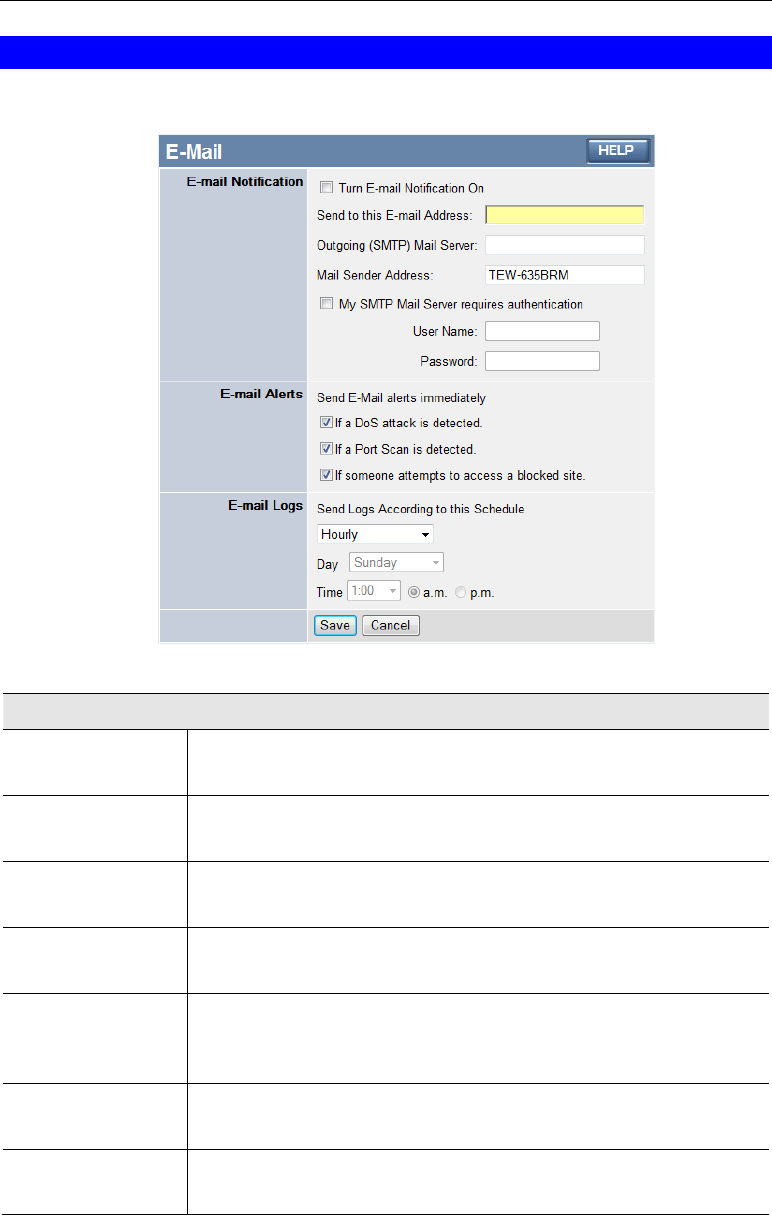
88
E-mail
This screen allows you to E-mail Logs and Alerts. A sample screen is shown below.
E-mail Screen
E-Mail Notification
Turn E-mail
Notification on Check this box to enable this feature. If enabled, the E-mail address
information (below) must be provided.
Send to this E-
mail address Enter the E-mail address the Log is to be sent to.
Outgoing (SMTP)
Mail Server Enter the address or IP address of the SMTP (Simple Mail Transport
Protocol) Server you use for outgoing E-mail.
Mail Sender
Address Enter the mail address of the sender. The E-mail will also show this
address as the Sender's address.
My SMTP Mail
Server requires
authentication
To stop spanners, many SMTP mail servers require you to log in to
send mail. In this case, enable this checkbox, and enter the login
information (User name and Password) in the fields below.
User Name If you have enabled "My SMTP Mail Server requires authentication"
above, enter the User Name required to login to your SMTP Server.
Password If you have enabled "My SMTP Mail Server requires authentication"
above, enter the password required to login to your SMTP Server.

89
E-mail Alerts
Send E-mail alerts
immediately You can choose to have alerts E-mailed to you, by checking the
desired checkboxes. The Broadband ADSL Router can send an
immediate alert when it detects a significant security incident such as
• A known hacker attack is directed at your IP address
• A computer on the Internet scans your IP address for open ports
• Someone on your LAN (Local Area Network) tries to visit a
blocked site.
E-mail Logs
Send Logs Select the desired option for sending the log by E-mail.
• Never (default) - This feature is disabled; Logs are not sent.
• When log is full - The time is not fixed. The log will be sent
when the log is full, which will depend on the volume of traffic.
• Hourly, Daily, Weekly... - The log is sent on the interval
specified.
• If Daily is selected, the log is sent at the time specified.
Select the time of day you wish the E-mail to be sent.
• If Weekly is selected, the log is sent once per week, on the
specified day, at the specified time.
Select the day and the time of day you wish the E-mail to be
sent.
Note:
If the log is full before the time specified to send it, it will be sent
regardless of the day and time specified.
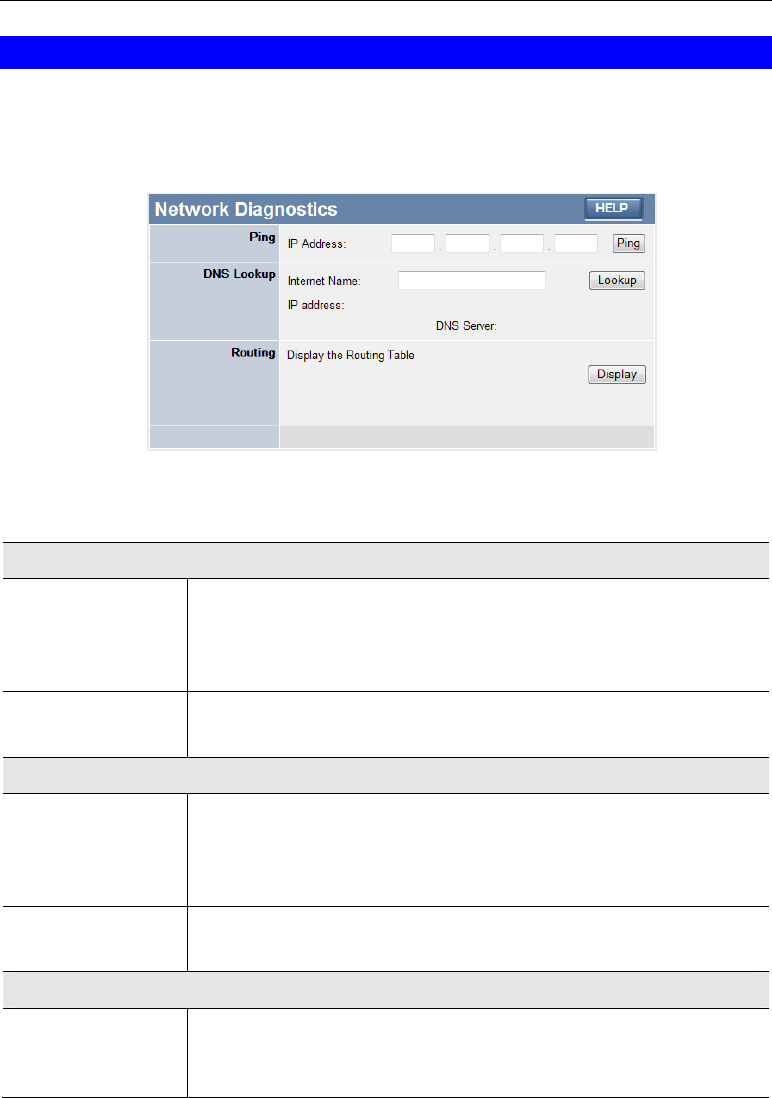
90
Diagnostics
This screen allows you to perform a "Ping" or a "DNS lookup". These activities can be useful
in solving network problems.
An example Network Diagnostics screen is shown below.
Network Diagnostics Screen
Ping
IP Address Enter the IP address you wish to ping. The IP address can be on your
LAN, or on the Internet. Note that if the address is on the Internet,
and no connection currently exists, you could get a "Timeout" error.
In that case, wait a few seconds and try again.
Ping Button After entering the IP address, click this button to start the "Ping"
procedure. The results will be displayed in the Ping Results pane.
DNS Lookup
Internet Name Enter the Domain name or URL for which you want a DNS (Domain
Name Server) lookup. Note that if the address in on the Internet, and
no connection currently exists, you could get a "Timeout" error. In
that case, wait a few seconds and try again.
Lookup Button After entering the Domain name/URL, click this button to start the
"DNS Lookup" procedure.
Routing
Display Click this button to display the internal routing table. This informa-
tion can be used by Technical Support and other staff who
understand Routing Tables.
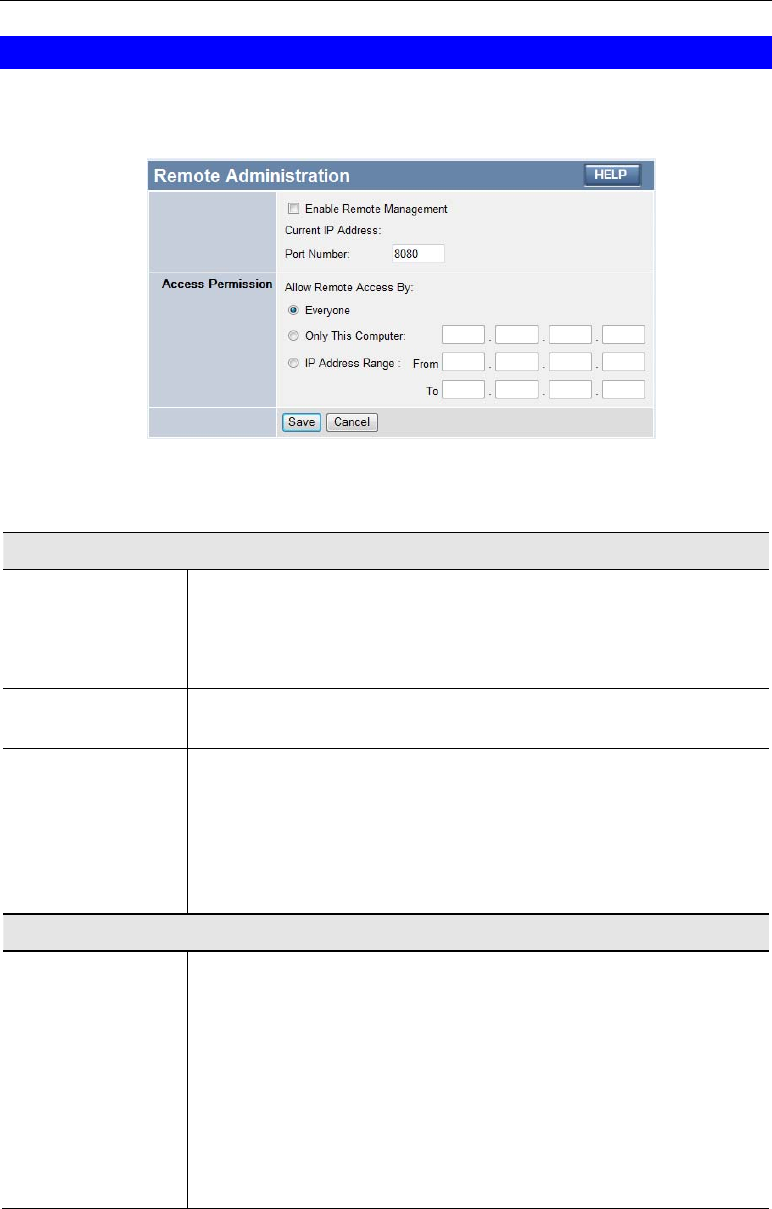
91
Remote Administration
If enabled, this feature allows you to manage the Wireless ADSL Modem Router via the
Internet.
Remote Administration Screen
Remote Administration
Enable Remote
Management Check to allow administration/management via the Internet. (To
connect, see below).
If Disabled, this device will ignore Administration connection
attempts from the Internet.
Current
IP Address This is the current address you will use when accessing this device
from the Internet. To connect, see details and an example below.
Port Number Enter a port number between 1 and 65535. The default for HTTP
(Web) connections is port 80, but using port 80 will prevent the use
of a Web "Virtual Server" on your LAN. So using a different port
number is recommended. The default value is 8080.
The port number must be specified in your Browser when you
connect. See the following section for details.
Access Permission
Allow Remote
Access Select the desired option.
• Everyone - allow access by everyone on the Internet.
• Only This Computer - allow access by only one IP address.
Enter the desired IP address.
• IP Address Range - allow access from a range of IP addresses
on the Internet. Enter a beginning and ending IP address to de-
fine the allowed range.
For security, you should restrict access to as few external IP ad-
dresses as practical.

92
To connect from a remote PC via the Internet
1. Ensure your Internet connection is established, and start your Web Browser.
2. In the "Address" bar, enter "HTTP://" followed by the Internet IP Address of the Wireless
ADSL Modem Router. If the port number is not 80, the port number is also required. (Af-
ter the IP Address, enter ":" followed by the port number.)
e.g.
HTTP://123.123.123.123:8080
This example assumes the WAN IP Address is 123.123.123.123, and the port number is
8080.
3. You will then be prompted for the login name and password for this device.

93
Routing
Overview
• If you don't have other Routers or Gateways on your LAN, you can ignore the "Routing"
page completely.
• If the Wireless ADSL Modem Router is only acting as a Gateway for the local LAN
segment, ignore the "Routing" page even if your LAN has other Routers.
• If your LAN has a standard Router (e.g. Cisco) on your LAN, and the Wireless ADSL
Modem Router is to act as a Gateway for all LAN segments, enable RIP (Routing Infor-
mation Protocol) and ignore the Static Routing table.
• If your LAN has other Gateways and Routers, and you wish to control which LAN seg-
ments use each Gateway, do NOT enable RIP (Routing Information Protocol). Configure
the Static Routing table instead. (You also need to configure the other Routers.)
• If using Windows 2000 Data center Server as a software Router, enable RIP on the Wire-
less ADSL Modem Router, and ensure the following Windows 2000 settings are correct:
• Open Routing and Remote Access
• In the console tree, select Routing and Remote Access, [server name], IP Routing, RIP
• In the "Details" pane, right-click the interface you want to configure for RIP version 2,
and then click "Properties".
• On the "General" tab, set Outgoing packet protocol to "RIP version 2 broadcast", and
Incoming packet protocol to "RIP version 1 and 2".
Routing Screen
The routing table is accessed by the Routing link on the Administration menu.
Using this Screen
Generally, you will use either RIP (Routing Information Protocol) OR the Static Routing Table,
as explained above, although is it possible to use both methods simultaneously.
Static Routing Table
• If RIP is not used, an entry in the routing table is required for each LAN segment on your
Network, other than the segment to which this device is attached.
• The other Routers must also be configured. See Configuring Other Routers on your LAN
later in this chapter for further details and an example.
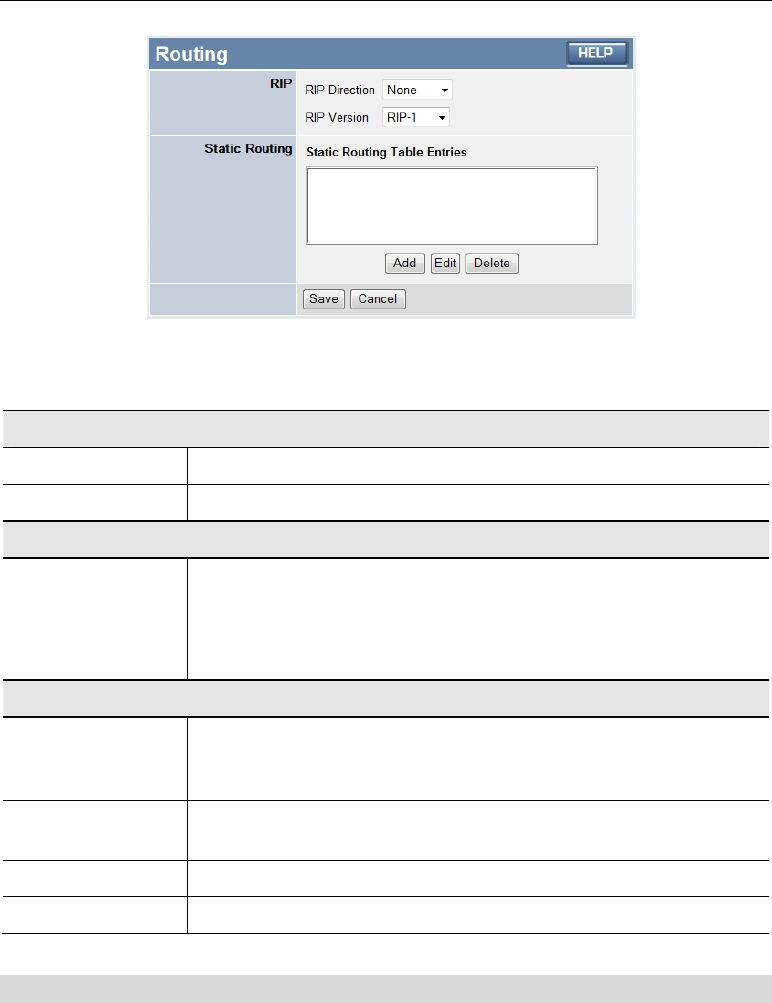
94
Routing Screen
RIP
RIP Direction Select the desired RIP Direction.
RIP Version Choose the RIP Version for the Server.
Static Routing
Static Routing
Table Entries This list shows all entries in the Routing Table.
• This area shows details of the selected item in the list.
• Change any the properties as required, then click the "Edit"
button to save the changes to the selected entry.
Buttons
Add Add a new entry to the Static Routing table, using the data shown in
the "Properties" area on screen. The entry selected in the list is
ignored, and has no effect.
Edit Update the current Static Routing Table entry, using the data shown
in the table area on screen.
Delete Delete the current Static Routing Table entry.
Save Save the RIP setting. This has no effect on the Static Routing Table.
Configuring Other Routers on your LAN
It is essential that all IP packets for devices not on the local LAN be passed to the Wireless
ADSL Modem Router, so that they can be forwarded to the external LAN, WAN, or Internet.
To achieve this, the local LAN must be configured to use the Wireless ADSL Modem Router
as the Default Route or Default Gateway.
Local Router
The local router is the Router installed on the same LAN segment as the Wireless ADSL
Modem Router. This router requires that the Default Route is the Wireless ADSL Modem
Router itself. Typically, routers have a special entry for the Default Route. It should be confi-
gured as follows.
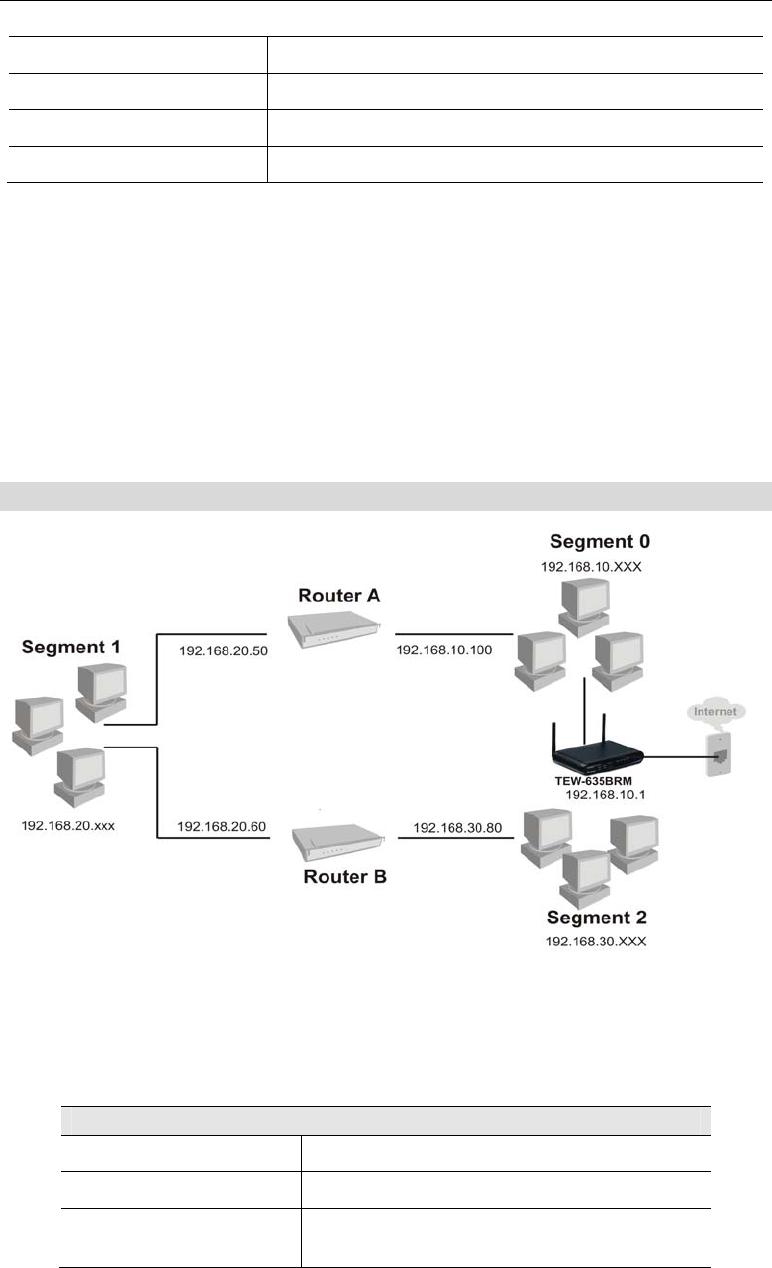
95
Destination IP Address Normally 0.0.0.0, but check your router documentation.
Network Mask Normally 0.0.0.0, but check your router documentation.
Gateway IP Address The IP Address of the Wireless ADSL Modem Router.
Metric 1
Other Routers on the Local LAN
Other routers on the local LAN must use the Wireless ADSL Modem Router's Local Router as
the Default Route. The entries will be the same as the Wireless ADSL Modem Router's local
router, with the exception of the Gateway IP Address.
• For a router with a direct connection to the Wireless ADSL Modem Router's local Router,
the Gateway IP Address is the address of the Wireless ADSL Modem Router's local router.
• For routers which must forward packets to another router before reaching the Wireless
ADSL Modem Router's local router, the Gateway IP Address is the address of the inter-
mediate router.
Static Routing - Example
For the Wireless ADSL Modem Router's Routing Table
For the LAN shown above, with 2 routers and 3 LAN segments, the Wireless ADSL Modem
Router requires 2 entries as follows.
Entry 1 (Segment 1)
Destination IP Address 192.168.20.0
Network Mask 255.255.255.0 (Standard Class C)
Gateway IP Address 192.168.10.100 (Wireless ADSL Modem
Router's local Router)

96
Metric 2
Entry 2 (Segment 2)
Destination IP Address 192.168.30.0
Network Mask 255.255.255.0 (Standard Class C)
Gateway IP Address 192.168.10.100
Metric 3
For Router A's Default Route
Destination IP Address 0.0.0.0
Network Mask 0.0.0.0
Gateway IP Address 192.168.10.1 (Wireless ADSL Modem Rou-
ter's IP Address)
For Router B's Default Route
Destination IP Address 0.0.0.0
Network Mask 0.0.0.0
Gateway IP Address 192.168.20.50 (Wireless ADSL Modem
Router's local router)
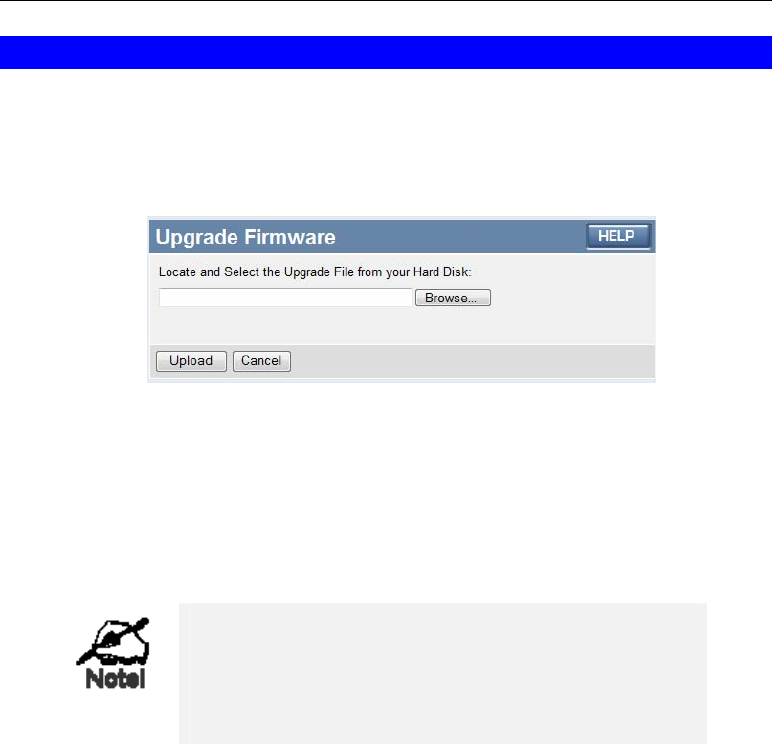
97
Upgrade Firmware
The firmware (software) in the Wireless ADSL Modem Router can be upgraded using your
Web Browser.
You must first download the upgrade file, then select Upgrade Firmware on the Administra-
tion menu. You will see a screen like the following.
To perform the Firmware Upgrade:
1. Click the Browse button and navigate to the location of the upgrade file.
2. Select the upgrade file. Its name will appear in the Upgrade File field.
3. Click the Upload button to commence the firmware upgrade.
The Wireless ADSL Modem Router is unavailable
during the upgrade process, and must restart when
the upgrade is completed. Any connections to or
through the Wireless ADSL Modem Router will be
lost.

98
Chapter 7
Modem Mode
This Chapter explains configuration and operation when in Modem Mode (al-
so known as Bridge Mode)
Overview
There are two modes available on the Mode screen.
• Router - Both the ADSL Modem and the Router features are operational. In this mode,
this device can provide shared Internet Access to all your LAN users. Also, by default, it
acts a DHCP Server, providing an IP address and related information to all Wireless and
LAN users.
• Modem (Bridge Mode) - Only the ADSL Modem component is operational. All Router
features are disabled. This device is "transparent" - it does not perform any operations or
make any changes to the network traffic passing through it. You need to have a DHCP
Server on your LAN to provide IP addresses to the Wireless clients using this Access
Point.
This Chapter describes operation while in Modem Mode (Bridge Mode)
Management Connections
When this device restarts in Modem mode, the IP address does not change, but the DHCP
server is disabled. However, your PC will usually retain the IP address provided by the DHCP
Server, so the connection will be automatically re-established. You then need to ensure that the
IP address of this modem is suitable for your LAN.
• You need to have a DHCP Server on your LAN to provide IP addresses to the Wireless
clients using this Access Point.
• This Modem/AP must be a valid device on your LAN, to allow management connections.
You must assign a (fixed) IP address which is within the address range used on your LAN,
but not within the address range used by your DHCP server.
When you connect in future, just connect normally, using the IP address you assigned.
1. Start your WEB browser.
2. In the Address box, enter "HTTP://" and the current IP Address of the Wireless ADSL
Modem, as in this example, which uses the Wireless ADSL Modem's default IP Address:
HTTP://192.168.10.1
3. When prompted for the User name and Password, enter admin for the user name, and
password for the password. (The password is the same regardless of the mode setting.)
7
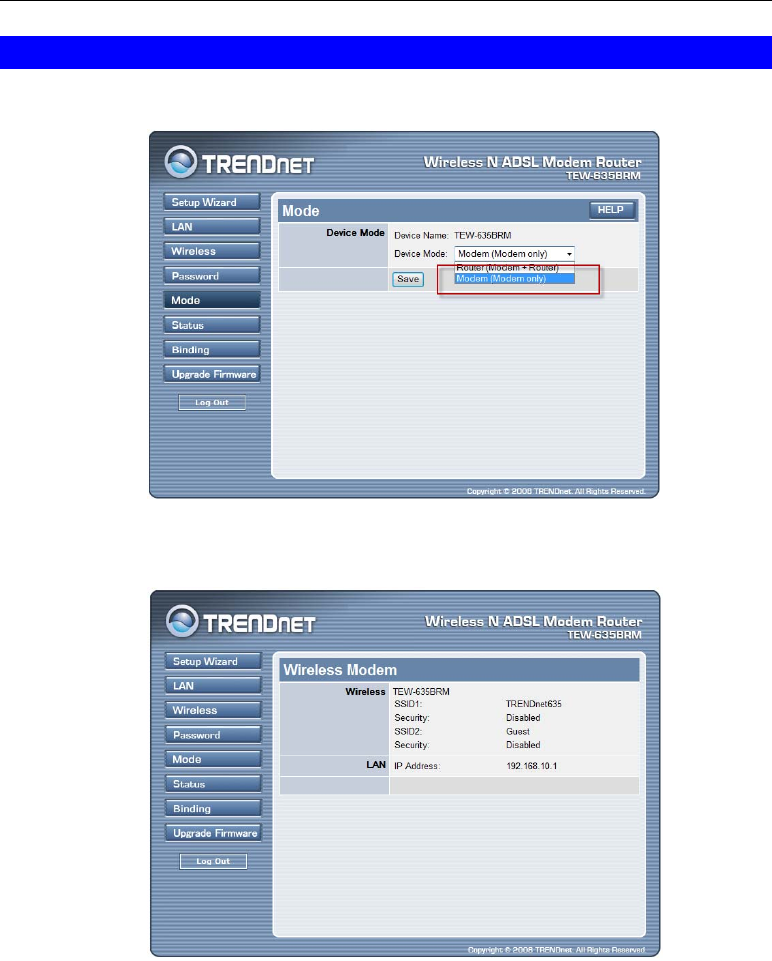
99
Modem Mode Main Screen
In the Device Mode drop down menu, select Modem(Modem only) and click “Save”.
The main screen will look like the example below.
Note:
When choosing Modem Mode, some of the Router options will not available for Modem mode.
The detail information as showed below.
• LAN – Allows user to set IP address and submask
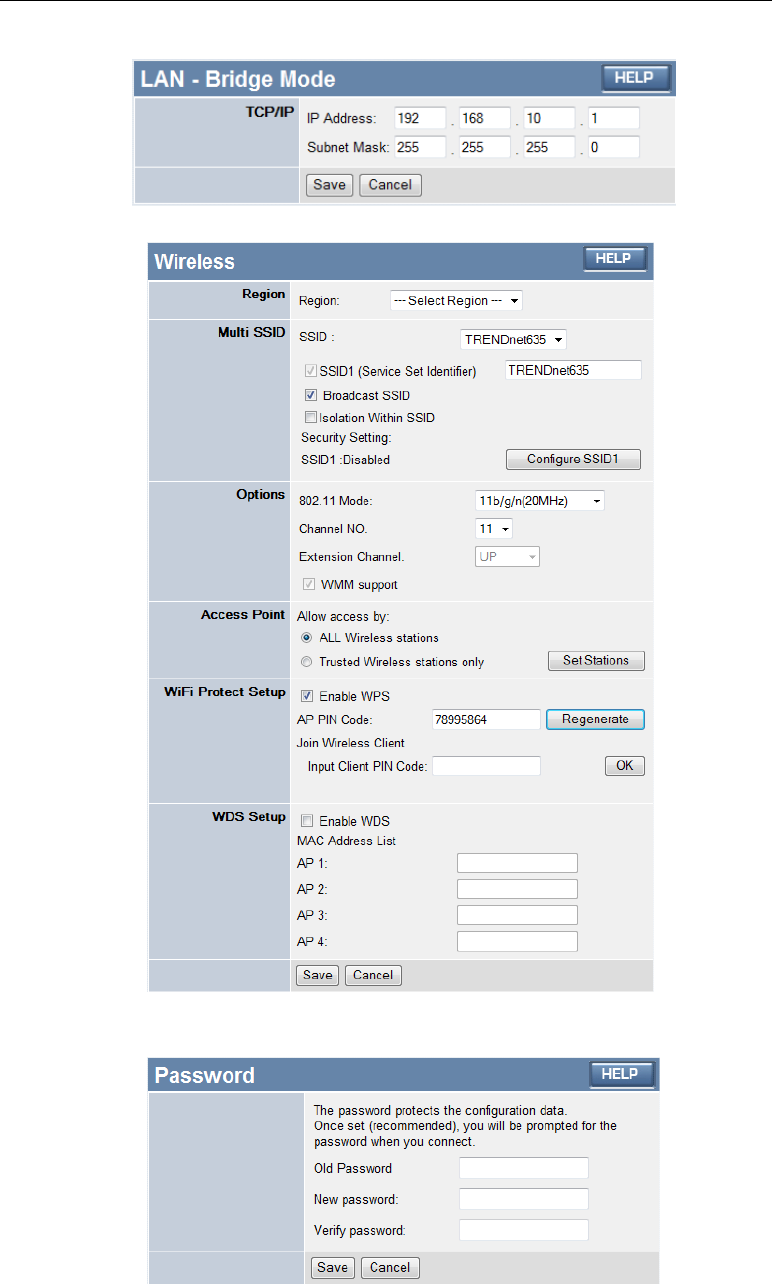
100
• Wireless – the wireless feature is same as the Router mode.
• Password – the password feature is same as Router mode.
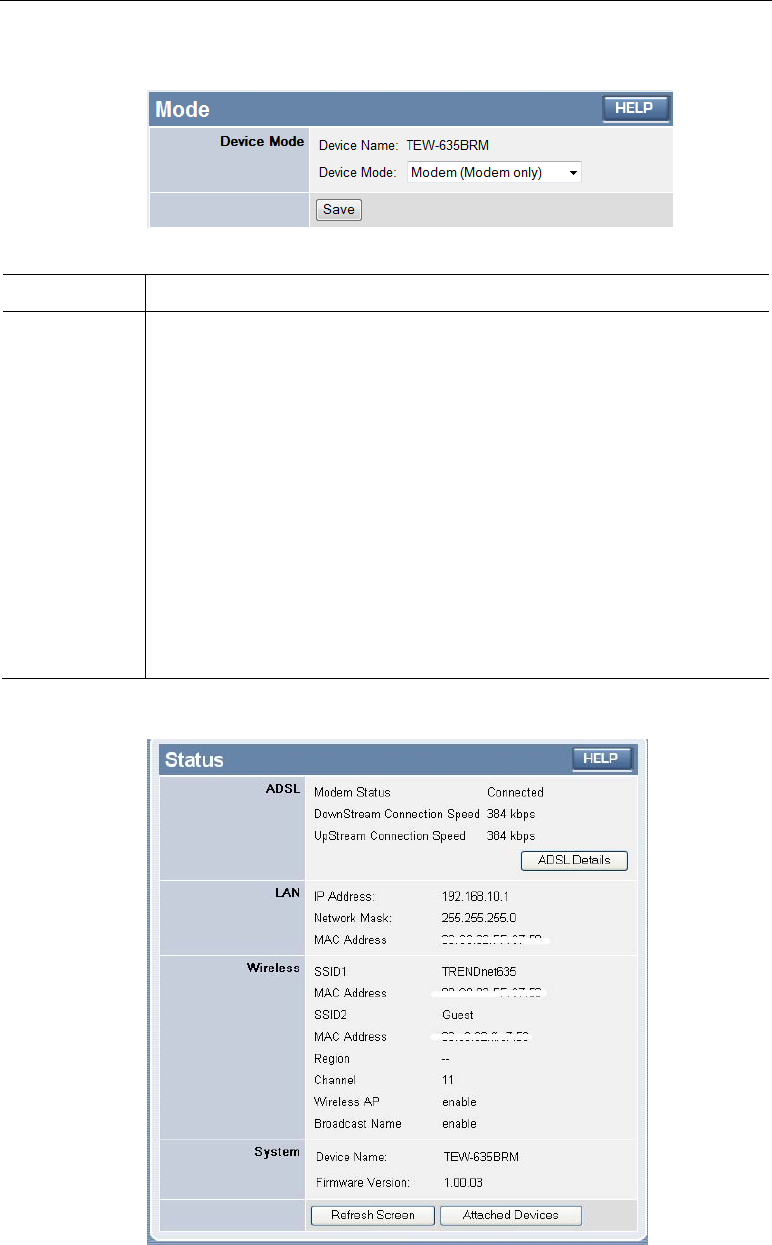
101
• Mode - this mode feature allows user to changed the mode setting back to Router Mode.
Mode Function
Device Name This field displays the current name of this device.
Device Mode Select the desired device mode for the router:
• Router - Both the ADSL Modem and the Router features are opera-
tional. In this mode, this device can provide shared Internet Access to
all your LAN users. Also, by default, it acts a DHCP Server, provid-
ing an IP address and related information to all Wireless and LAN
users.
• Modem - Only the ADSL Modem component is operational. All
Router features are disabled. This device is "transparent" - it does not
perform any operations or make any changes to the network traffic
passing through it. You need to have a DHCP Server on your LAN to
provide IP addresses to the Wireless clients using this Access Point.
This mode is also called Bridge Mode.
After changing the mode, this device will restart, which will take a few
seconds. The menu will also change, depending on the mode you are in.
• Status - displays current settings and status. See the following section for details.

102
Status Function
ADSL
Modem Status This indicates the status of the ADSL modem component.
DownStream
Connection Speed Displays the speed for the DownStream Connection.
UpStream
Connection Speed If connected, displays the speed for the Up Stream (upload)
ADSL Connection.
ADSL Details Click this button to open a sub-window and view the details of
each VC (Virtual Circuit).
LAN
IP Address The IP Address of the Wireless ADSL Modem Router.
Network Mask The Network Mask (Subnet Mask) for the IP Address above.
MAC Address This shows the MAC Address for the Wireless ADSL Modem
Router, as seen on the LAN interface.
Wireless
SSID 1/ SSID 2 If using an ESS (Extended Service Set, with multiple access
points) this ID is called an ESSID (Extended Service Set Identifi-
er).
Region The current region, as set on the Wireless screen.
Channel This shows the Channel currently used, as set on the Wireless
screen.
Wireless AP This indicates whether or not the Wireless Access Point feature is
enabled.
Broadcast Name This indicates whether or not the SSID is Broadcast. This setting
is on the Wireless screen.
System
Device Name The current name of the Router. This name is also the "hostname"
for users with an "@Home" type connection.
Firmware Version The version of the current firmware installed.
Buttons
ADSL Details View the details of each VC (Virtual Circuit).
Attached Devices This will open a sub-window, showing all LAN and Wireless
devices currently on the network.
Refresh Screen Update the data displayed on screen.
• Binding - this function is same as Router mode.
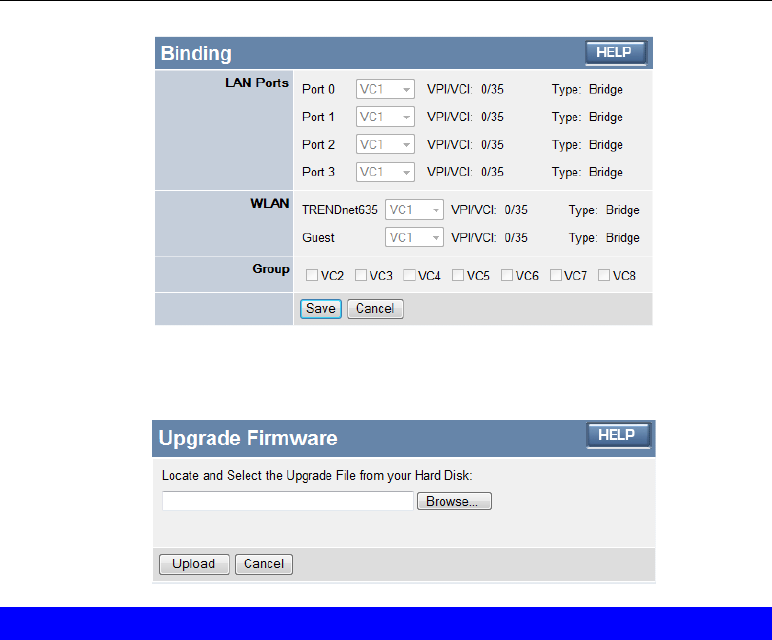
103
• Upgrade Firmware - this function is same as Router mode.
Operation
Operation is automatic and transparent.
• Wireless clients can connect to the Access Point if they have the correct SSID and security,
but they must obtain an IP address from the DHCP Server on your LAN.
• The modem will act like any other ADSL modem. No routing will be performed, and no
client login will be done. If a client login is required, it must be performed by your Rou-
ter/Gateway or by software on your PC.

104
Appendix A
Troubleshooting
This Appendix covers the most likely problems and their solutions.
Overview
This chapter covers some common problems that may be encountered while using the Wireless
ADSL Modem Router and some possible solutions to them. If you follow the suggested steps
and the Wireless ADSL Modem Router still does not function properly, contact your dealer for
further advice.
General Problems
Problem 1: Can't connect to the Wireless ADSL Modem Router to configure it.
Solution 1: Check the following:
• The Wireless ADSL Modem Router is properly installed, LAN connec-
tions are OK, and it is powered ON.
• Ensure that your PC and the Wireless ADSL Modem Router are on the
same network segment. (If you don't have a router, this must be the
case.)
• If your PC is set to "Obtain an IP Address automatically" (DHCP
client), restart it.
• If your PC uses a Fixed (Static) IP address, ensure that it is using an IP
Address within the range 192.168.10.2 to 192.168.10.254 and thus
compatible with the Wireless ADSL Modem Router's default IP Ad-
dress of 192.168.10.1.
Also, the Network Mask should be set to 255.255.255.0 to match the
Wireless ADSL Modem Router.
In Windows, you can check these settings by using Control Panel-
Network to check the Properties for the TCP/IP protocol.
Internet Access
Problem 1: When I enter a URL or IP address I get a time out error.
Solution 1: A number of things could be causing this. Try the following troubleshooting
steps.
• Check if other PCs work. If they do, ensure that your PCs IP settings
are correct. If using a Fixed (Static) IP Address, check the Network
Mask, Default gateway and DNS as well as the IP Address.
• If the PCs are configured correctly, but still not working, check the
Wireless ADSL Modem Router. Ensure that it is connected and ON.
Connect to it and check its settings. (If you can't connect to it, check the
A

105
LAN and power connections.)
• Check the Wireless ADSL Modem Router's status screen to see if it is
working correctly.
Problem 2: Some applications do not run properly when using the Wireless ADSL
Modem Router.
Solution 2: The Wireless ADSL Modem Router processes the data passing through it,
so it is not transparent.
For incoming connections, you must use the Virtual Server or Firewall
Rules to specify the PC which will receive the incoming traffic.
You can also use the DMZ function. This should work with almost every
application, but:
• It is a security risk, since the firewall is disabled.
• Only one (1) PC can use this feature.
Wireless Access
Problem 1: My PC can't locate the Wireless Access Point.
Solution 1: Check the following.
• Your PC is set to Infrastructure Mode. (Access Points are always in
Infrastructure Mode)
• The SSID on your PC and the Wireless Access Point are the same.
Remember that the SSID is case-sensitive. So, for example
"Workgroup" does NOT match "workgroup".
• Both your PC and the Wireless ADSL Modem Router must have the
same setting for WEP. The default setting for the Wireless ADSL Mod-
em Router is disabled, so your wireless station should also have WEP
disabled.
• If WEP is enabled on the Wireless ADSL Modem Router, your PC
must have WEP enabled, and the key must match.
• If the Wireless ADSL Modem Router's Wireless screen is set to Allow
Trusted PCs only, then each of your Wireless stations must have been
designated as "Trusted", or the Wireless station will be blocked.
• To see if radio interference is causing a problem, see if connection is
possible when close to the Wireless ADSL Modem Router.
Remember that the connection range can be as little as 100 feet in poor
environments.
Problem 2: Wireless connection speed is very slow.
Solution 2: The wireless system will connect at the highest possible speed, depending
on the distance and the environment. To obtain the highest possible connec-
tion speed, you can experiment with the following:
• Wireless ADSL Modem Router location.
Try adjusting the location and orientation of the Wireless ADSL Mod-
em Router.
• Wireless Channel
If interference is the problem, changing to another channel may show a

106
marked improvement.
• Radio Interference
Other devices may be causing interference. You can experiment by
switching other devices Off, and see if this helps. Any "noisy" devices
should be shielded or relocated.
• RF Shielding
Your environment may tend to block transmission between the wireless
stations. This will mean high access speed is only possible when close
to the Wireless ADSL Modem Router.

107
Appendix B
About Wireless LANs
This Appendix provides some background information about using Wireless
LANs (WLANs).
Modes
Wireless LANs can work in either of two (2) modes:
• Ad-hoc
• Infrastructure
Ad-hoc Mode
Ad-hoc mode does not require an Access Point or a wired (Ethernet) LAN. Wireless Sta-
tions (e.g. notebook PCs with wireless cards) communicate directly with each other.
Infrastructure Mode
In Infrastructure Mode, one or more Access Points are used to connect Wireless Stations
(e.g. Notebook PCs with wireless cards) to a wired (Ethernet) LAN. The Wireless Stations
can then access all LAN resources.
Access Points can only function in "Infrastructure" mode,
and can communicate only with Wireless Stations which are
set to "Infrastructure" mode.
BSS/ESS
BSS
A group of Wireless Stations and a single Access Point, all using the same ID (SSID), form a
Basic Service Set (BSS).
Using the same SSID is essential. Devices with different SSIDs are unable to communicate
with each other.
ESS
A group of Wireless Stations, and multiple Access Points, all using the same ID (ESSID), form
an Extended Service Set (ESS).
Different Access Points within an ESS can use different Channels. In fact, to reduce interfe-
rence, it is recommended that adjacent Access Points SHOULD use different channels.
B

108
As Wireless Stations are physically moved through the area covered by an ESS, they will
automatically change to the Access Point which has the least interference or best performance.
This capability is called Roaming. (Access Points do not have or require Roaming capabilities.)
Channels
The Wireless Channel sets the radio frequency used for communication.
• Access Points use a fixed Channel. You can select the Channel used. This allows you to
choose a Channel which provides the least interference and best performance. In the USA
and Canada, 11 channels are available. If using multiple Access Points, it is better if adja-
cent Access Points use different Channels to reduce interference.
• In "Infrastructure" mode, Wireless Stations normally scan all Channels, looking for an
Access Point. If more than one Access Point can be used, the one with the strongest signal
is used. (This can only happen within an ESS.)
• If using "Ad-hoc" mode (no Access Point), all Wireless stations should be set to use the
same Channel. However, most Wireless stations will still scan all Channels to see if there
is an existing "Ad-hoc" group they can join.
WEP
WEP (Wired Equivalent Privacy) is a standard for encrypting data before it is transmitted.
This is desirable because it is impossible to prevent snoopers from receiving any data which is
transmitted by your Wireless Stations. But if the data is encrypted, then it is meaningless
unless the receiver can decrypt it.
If WEP is used, the Wireless Stations and the Access Point must have the same settings
for each of the following:
WEP Off, 64 Bit, 128 Bit
Key For 64 Bit encryption, the Key value must match.
For 128 Bit encryption, the Key value must match
WEP Authentication Open System or Shared Key.
WPA-PSK
WPA-PSK is another standard for encrypting data before it is transmitted. This is a later
standard than WEP (Wired Equivalent Privacy), and provides greater security for your data.
Data is encrypted using a 256Bit key which is automatically generated and changed often.
If all your Wireless stations support WPA-PSK, you should use this instead of WEP.
If WPA-PSK is used, the Wireless Stations and the Access Point must have the same
settings for each of the following:
WPA PSK
(Pre-shared Key) Enter the same value on every station and the AP. The PSK
must be from 8 to 63 characters in length. The 256Bit key
used for the actual encryption is derived from this key.

109
Encryption The same encryption method must be used. The most
common encryption method is TKIP. Another widely-
supported method is AES.
WPA2-PSK
This is a later version of WPA (WPA-PSK). The major change is the use of AES (Advanced
Encryption System) for protecting data. AES is very secure, considered to be unbreakable. The
PSK (Pre-shared Key) must be entered on each Wireless station.
If WPA2-PSK is used, the Wireless Stations and the Access Point must have the same
settings for each of the following:
WPA2 PSK
(Pre-shared Key) Enter the same value on every station and the AP. The PSK
must be from 8 to 63 characters in length. The 256Bit key
used for the actual encryption is derived from this key.
Encryption The same encryption method must be used. The most
common encryption method is TKIP. Another widely-
supported method is AES.
WPA-802.1x
This version of WPA requires a Radius Server on your LAN to provide the client authentica-
tion according to the 802.1x standard. Data transmissions are encrypted using the WPA
standard.
If this option is used:
• The Access Point must have a "client login" on the Radius Server.
• Each user must have a "user login" on the Radius Server.
• Each user's wireless client must support 802.1x and provide the login data when required.
All data transmission is encrypted using the WPA standard. Keys are automatically generated,
so no key input is required.
Wireless LAN Configuration
To allow Wireless Stations to use the Access Point, the Wireless Stations and the Access Point
must use the same settings, as follows:
Mode On client Wireless Stations, the mode must be set to "Infrastructure".
(The Access Point is always in "Infrastructure" mode.)
SSID (ESSID) Wireless Stations should use the same SSID (ESSID) as the Access
Point they wish to connect to. Alternatively, the SSID can be set to
"any" or null (blank) to allow connection to any Access Point.
Wireless
Security The Wireless Stations and the Access Point must use the same settings
for Wireless security. (None, WEP, WPA-PSK, WPA2-PSK, WPA-
802.1x).

110
Appendix C
Specifications
Multi-Function Wireless ADSL Modem Router
Model TEW-635BRM 300Mbps Wireless ADSL2/2+ Modem Router
ADSL Standard ADSL : ANSI T1.413 and multi-mode, ITU G.992.1 (G.dmt) Annex A,
ITU G.992.2 G.lite, ITU G.992.3 Annex A ADSL2, ITU G.992.3 Annex
A DELT, ITU G.992.3 Annex L READSL2, ITU G.992.5 Annex A
ADSL2+, ITU G.994.1 (G.hs) ver.3
Dimensions 175 x 130 x 30mm
Operating Temperature 0° C to 40° C
Storage Temperature -20° C to 70° C
Network Protocol: TCP/IP
Network Interface: 4 * 10/100BaseT (RJ45) LAN connection
1 * RJ11 for ADSL line
LEDs 15
Power Adapter 12VDC 1A External
Wireless Interface
Standards IEEE802.11b, IEEE802.11g, 802.11n Draft
Frequency 2.412 to 2.4835GHz (Industrial Scientific Medical Band)
Channels 1 ~ 14 Channel (Universal Domain Selection)
Modulation CCK, DQPSK, DBPSK, BPSK, QPSK, 16-QAM, 64-QAM, OFDM
Data Rate Up to 300Mbps (802.11n Draft)
Security WEP 64Bit, 128Bit, WPA-PSK, WPA2-PSK, WPA-802.1X, WPS Button
Support, MAC address checking
Output Power 802.11b: 17dBm + 1.5 (typical)
802.11g: 15dBm + 1.5 (typical)
802.11n : 12.5dBm + 1.5 (typical)
Receiver Sensitivity 802.11b: -86 + 1.5 dBm (typical)
802.11g: -70 + 1.5 dBm (typical)
802.11n: -69 + 1.5 dBm (typical)
C

111
Regulatory Approvals
FCC Statement
This equipment has been tested and found to comply with the limits for a Class B digital
device, pursuant to Part 15 of the FCC Rules. These limits are designed to provide reasonable
protection against harmful interference in a residential installation.
This equipment generates, uses and can radiate radio frequency energy and, if not installed and
used in accordance with the instructions, may cause harmful interference to radio communica-
tions. However, there is no guarantee that interference will not occur in a particular installation.
If this equipment does cause harmful interference to radio or television reception, which can be
determined by turning the equipment off and on, the user is encouraged to try to correct the
interference by one of the following measures:
• Reorient or relocate the receiving antenna.
• Increase the separation between the equipment and receiver.
• Connect the equipment into an outlet on a circuit different from that to which the receiver
is connected.
• Consult the dealer or an experienced radio/TV technician for help.
To assure continued compliance, any changes or modifications not expressly approved by the
party responsible for compliance could void the user's authority to operate this equipment.
(Example - use only shielded interface cables when connecting to computer or peripheral
devices).
FCC Radiation Exposure Statement
This equipment complies with FCC RF radiation exposure limits set forth for an uncontrolled
environment. This equipment should be installed and operated with a minimum distance of 20
centimeters between the radiator and your body.
This device complies with Part 15 of the FCC Rules. Operation is subject to the following two
conditions:
(1) This device may not cause harmful interference, and
(2) This device must accept any interference received, including interference that may cause
undesired operation.
This transmitter must not be co-located or operating in conjunction with any other antenna or
transmitter.
CE Approval
CE Standards
This product complies with the 99/5/EEC directives, including the following safety and EMC
standards:
• EN300328-2
• EN301489-1/-17
• EN60950

112
Limited Warranty
TRENDnet warrants its products against defects in material and workmanship, under normal use and service, for the
following lengths of time from the date of purchase.
TEW-635BRM – 3 Years Limited Warranty
If a product does not operate as warranted above during the applicable warranty period, TRENDnet shall, at its option
and expense, repair the defective product or part, deliver to customer an equivalent product or part to replace the
defective item, or refund to customer the purchase price paid for the defective product. All products that are replaced
will become the property of TRENDnet. Replacement products may be new or reconditioned.
TRENDnet shall not be responsible for any software, firmware, information, or memory data of customer contained in,
stored on, or integrated with any products returned to TRENDnet pursuant to any warranty.
There are no user serviceable parts inside the product. Do not remove or attempt to service the product by any
unauthorized service center. This warranty is voided if (i) the product has been modified or repaired by any unautho-
rized service center, (ii) the product was subject to accident, abuse, or improper use (iii) the product was subject to
conditions more severe than those specified in the manual.
Warranty service may be obtained by contacting TRENDnet office within the applicable warranty period for a Return
Material Authorization (RMA) number, accompanied by a copy of the dated proof of the purchase. Products returned
to TRENDnet must be pre-authorized by TRENDnet with RMA number marked on the outside of the package, and
sent prepaid, insured and packaged appropriately for safe shipment.
WARRANTIES EXCLUSIVE: IF THE TRENDNET PRODUCT DOES NOT OPERATE AS WARRANTED
ABOVE, THE CUSTOMER’S SOLE REMEDY SHALL BE, AT TRENDNET’S OPTION, REPAIR OR
REPLACEMENT. THE FOREGOING WARRANTIES AND REMEDIES ARE EXCLUSIVE AND ARE IN LIEU
OF ALL OTHER WARRANTIES, EXPRESSED OR IMPLIED, EITHER IN FACT OR BY OPERATION OF LAW,
STATUTORY OR OTHERWISE, INCLUDING WARRANTIES OF MERCHANTABILITY AND FITNESS FOR A
PARTICULAR PURPOSE. TRENDNET NEITHER ASSUMES NOR AUTHORIZES ANY OTHER PERSON TO
ASSUME FOR IT ANY OTHER LIABILITY IN CONNECTION WITH THE SALE, INSTALLATION
MAINTENANCE OR USE OF TRENDNET’S PRODUCTS.
TRENDNET SHALL NOT BE LIABLE UNDER THIS WARRANTY IF ITS TESTING AND EXAMINATION
DISCLOSE THAT THE ALLEGED DEFECT IN THE PRODUCT DOES NOT EXIST OR WAS CAUSED BY
CUSTOMER’S OR ANY THIRD PERSON’S MISUSE, NEGLECT, IMPROPER INSTALLATION OR TESTING,
UNAUTHORIZED ATTEMPTS TO REPAIR OR MODIFY, OR ANY OTHER CAUSE BEYOND THE RANGE OF
THE INTENDED USE, OR BY ACCIDENT, FIRE, LIGHTNING, OR OTHER HAZARD.
LIMITATION OF LIABILITY: TO THE FULL EXTENT ALLOWED BY LAW TRENDNET ALSO EXCLUDES
FOR ITSELF AND ITS SUPPLIERS ANY LIABILITY, WHETHER BASED IN CONTRACT OR TORT
(INCLUDING NEGLIGENCE), FOR INCIDENTAL, CONSEQUENTIAL, INDIRECT, SPECIAL, OR PUNITIVE
DAMAGES OF ANY KIND, OR FOR LOSS OF REVENUE OR PROFITS, LOSS OF BUSINESS, LOSS OF
INFORMATION OR DATE, OR OTHER FINANCIAL LOSS ARISING OUT OF OR IN CONNECTION WITH
THE SALE, INSTALLATION, MAINTENANCE, USE, PERFORMANCE, FAILURE, OR INTERRUPTION OF
THE POSSIBILITY OF SUCH DAMAGES, AND LIMITS ITS LIABILITY TO REPAIR, REPLACEMENT, OR
REFUND OF THE PURCHASE PRICE PAID, AT TRENDNET’S OPTION. THIS DISCLAIMER OF LIABILITY
FOR DAMAGES WILL NOT BE AFFECTED IF ANY REMEDY PROVIDED HEREIN SHALL FAIL OF ITS
ESSENTIAL PURPOSE.
Governing Law: This Limited Warranty shall be governed by the laws of the state of California.
AC/DC Power Adapter, Cable, Cooling Fan, and Power Supply carry 1 year warranty.
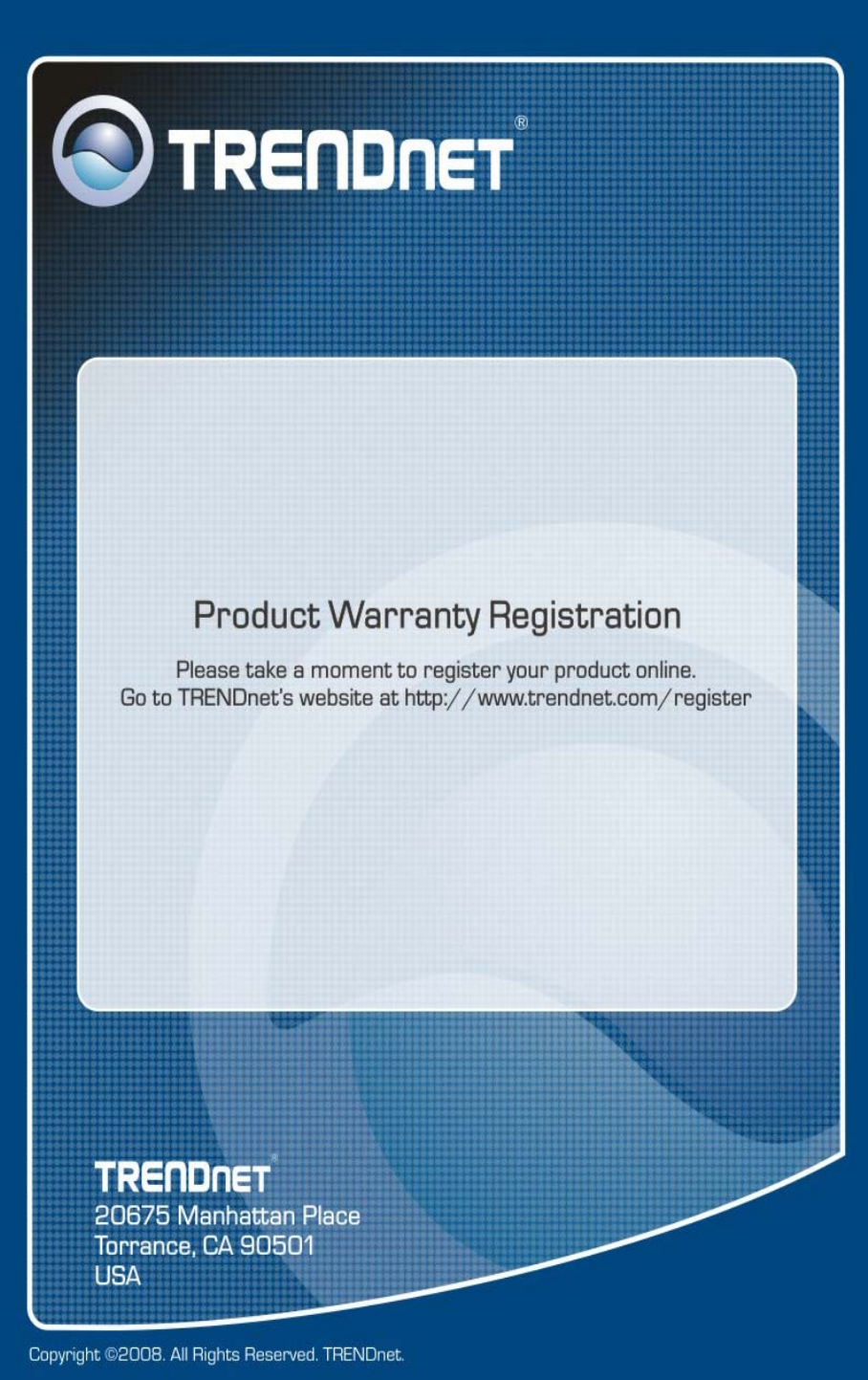
113